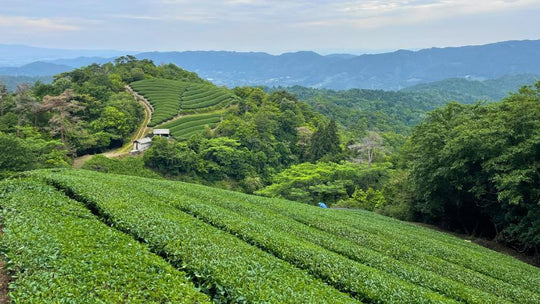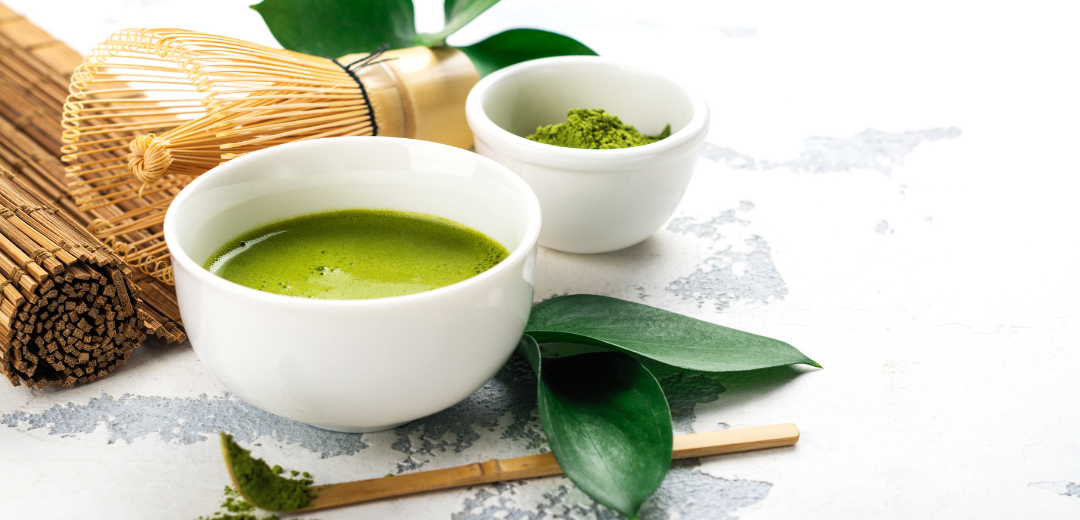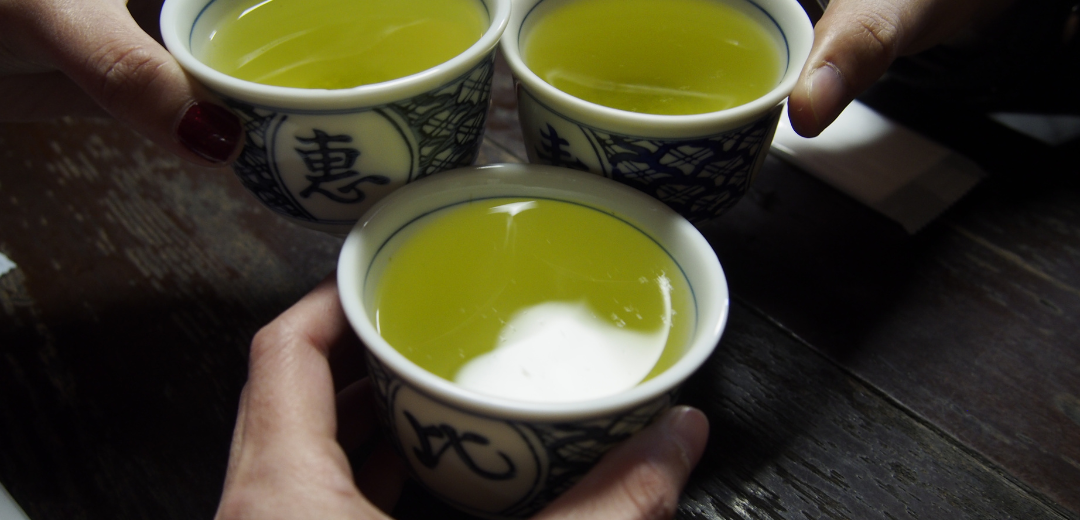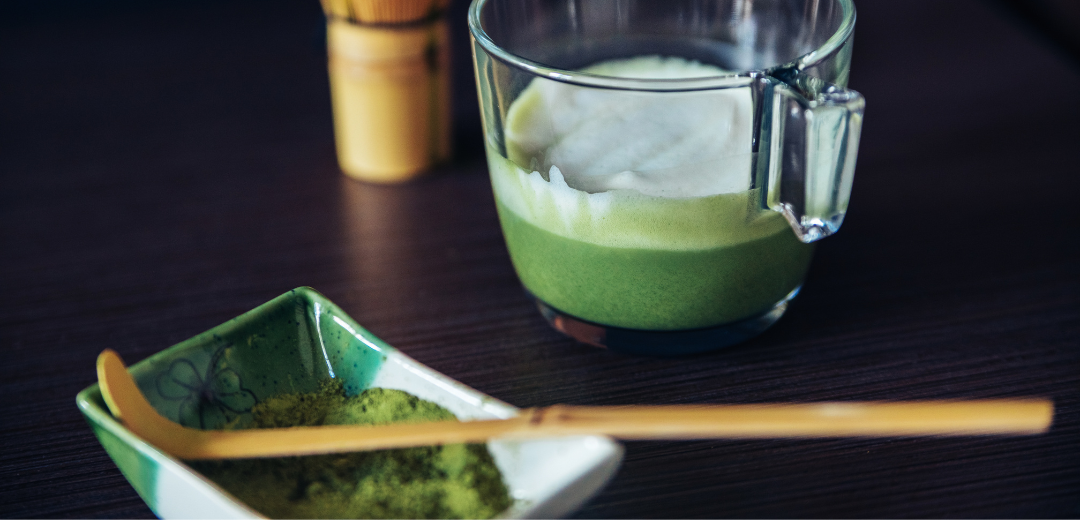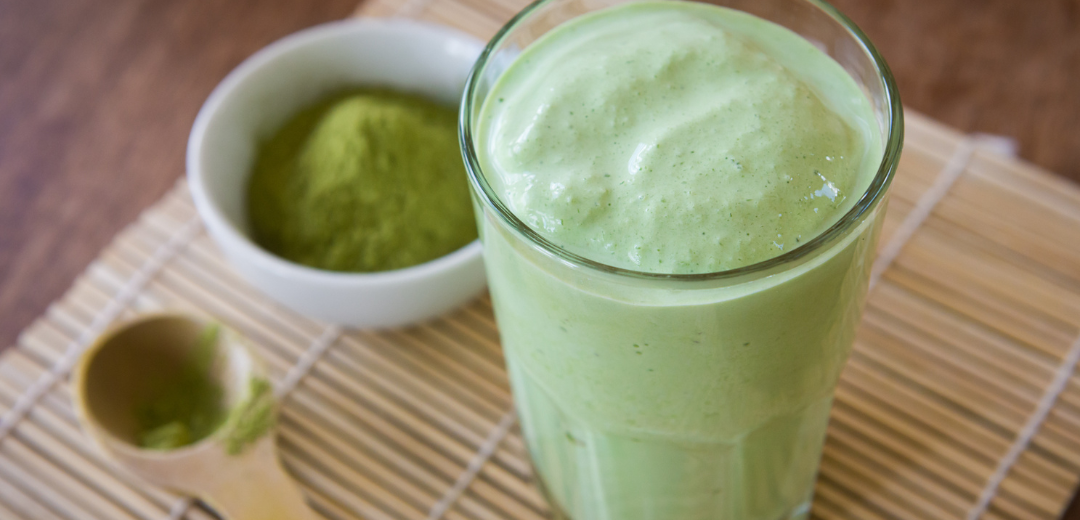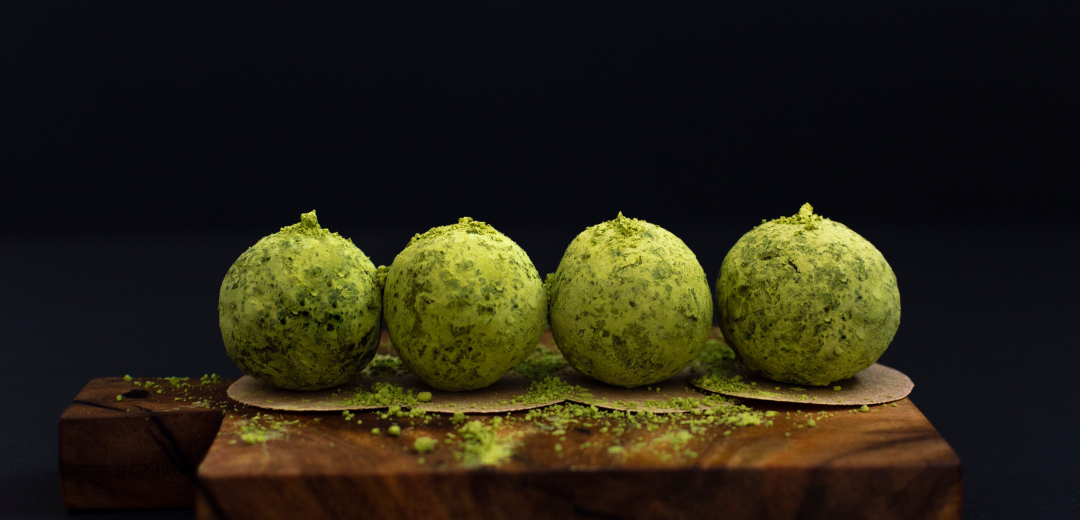
News
Matcha-Mangel und Preisanstieg in Japan 2025 – Was passiert wirklich?
Die Matcha-Preise haben sich bis 2025 mehr als verdoppelt, und das Angebot aus Kyoto ist stark zurückgegangen. Als Matcha-Exporteur mit Sitz in Japan analysieren wir die tatsächlichen Entwicklungen – und...
Was passiert, was hat es verursacht und was ist als nächstes zu erwarten?
Wenn Sie kürzlich versucht haben, Matcha zu kaufen – insbesondere hochwertigen zeremoniellen Matcha – ist Ihnen möglicherweise etwas Ungewöhnliches aufgefallen: steigende Preise, begrenzte Verfügbarkeit und verspätete Lieferungen.
Wir sind in Japan ansässig und arbeiten direkt mit Teebauern und Großhändlern zusammen. Hier finden Sie eine klare Übersicht über die aktuellen Entwicklungen und ihre Bedeutung für unsere Branche und unsere Kunden weltweit.
📉 Das Matcha-Angebot ist stark zurückgegangen

Matcha wird aus Tencha hergestellt, einer Art schattigen Grünteeblatts. Bei der Ernte 2025 in der Präfektur Kyoto , dem Zentrum des Uji-Matcha, kam es zu starken Produktionsrückgängen:
| Teesorte | 2024 Volumen | Band 2025 | Ändern |
|---|---|---|---|
| Uji Tencha (handverlesen) | 10,216 kg | 6.140 kg | –40 % |
| Tencha der ersten Ernte (maschinell gepflückt) | 529.960 kg | 434,521 kg | –18 % |
Diese Zahlen wurden im Juni 2025 von der Kyoto Tea Industry Association und JA Zen-Noh Kyoto offiziell bekannt gegeben.
💴 Die Preise haben sich mehr als verdoppelt

Angesichts des knappen Angebots und der weltweiten Nachfrage, die stärker war als je zuvor, schossen die Auktionspreise in die Höhe:
| Teesorte | 2024 Preis/kg | 2025 Preis/kg | Ändern |
|---|---|---|---|
| Uji Tencha | 20.024 Yen | 43.330 ¥ | +116 % |
| Tencha der ersten Ernte | 5.402 Yen | 14.541 ¥ | +169 % |
Diese Preiserhöhungen sind beispiellos und haben bereits begonnen, sich auf die Produktpreise und -verfügbarkeit weltweit auszuwirken.
🔍 Was ist der Grund für den Mangel?
Der Mangel ist nicht auf ein einzelnes Problem zurückzuführen – es ist ein perfekter Sturm:
1. Die weltweite Nachfrage nach Matcha boomt
Gesundheitsbewusste Verbraucher treiben die Nachfrage nach Matcha in allen Formen an – von traditionellen Teeschalen über Matcha-Lattes und Smoothies bis hin zu Süßigkeiten und Nahrungsergänzungsmitteln. Sogar die Gastronomie und die Kosmetikindustrie verwenden mehr Matcha als je zuvor.
2. Klima- und landwirtschaftliche Herausforderungen
Japan erlebte im Frühjahr 2025 ein ungewöhnlich heißes und trockenes Wetter. Einige Regionen berichteten von Stress für die Teepflanzen, was sich auf Blattqualität und Ertrag auswirkte. Dies gilt insbesondere für Kyoto, wo traditionelle, nicht-mechanisierte Anbaumethoden noch immer weit verbreitet sind.
3. Verschiebung der Prioritäten in der Teeproduktion
Um die Nachfrage zu decken, stellen viele Farmen von Gyokuro oder Sencha auf Tencha (den Rohstoff für Matcha) um. Diese Umstellung ist zwar strategisch, reduziert aber auch die Vielfalt und begrenzt kurzfristig die Produktion.
4. Material- und Arbeitskosten
Die Kosten für Treibstoff, Verpackung, Düngemittel und Arbeitskraft sind gestiegen. Zusammen mit dem schwachen Yen ist die Produktion teurer denn je, insbesondere bei Bio- und handgepflückten Tees.
🗾 Was zeigen nationale Daten?
Interessanterweise hat die landesweite Tencha-Produktion im letzten Jahrzehnt zugenommen . Laut dem japanischen Landwirtschaftsministerium war die Tencha-Produktion 2024 2,7-mal höher als 2014.
Aber das ist nur ein Teil der Geschichte: Kyoto – die Heimat des wertvollsten Uji Matcha – erlebte 2025 dramatische Rückgänge. Während also das Gesamtangebot in ganz Japan gestiegen ist, ist Matcha bester Qualität mittlerweile knapp.
🔮 Was Sie in Zukunft erwarten können
Bei Premium Health Japan haben wir viele Fragen von Kunden und Partnern aus aller Welt erhalten. Folgendes können Sie unserer Meinung nach erwarten:
✅ Die Preise bleiben hoch – vorerst
Die Preise für Tencha und Matcha werden nicht so schnell wieder das Niveau von 2022 erreichen. Eine gewisse Stabilisierung könnte jedoch nach der Herbsternte oder mit höheren Frühjahrserträgen im Jahr 2026 eintreten.
✅ Lieferketten werden angepasst
Landwirte, Auktionshäuser und Käufer passen sich an. Der Fokus liegt verstärkt auf der Verbesserung der Erträge, der Neubepflanzung von Teefeldern und der Modernisierung der Produktion bei gleichbleibender Qualität.
✅ Matcha wird nicht verschwinden
Trotz des Schocks ist Japans Matcha-Industrie stark. Kluge Investitionen, strategisches Wachstum und internationale Nachfrage werden dafür sorgen, dass authentischer Matcha weiterhin verfügbar bleibt, auch wenn man möglicherweise selektiver vorgehen muss.
💬 Was wir bei Premium Health Japan tun
Wir sind stolz darauf, direkt in Japan tätig zu sein und direkt mit den Produzenten zusammenzuarbeiten. Wir pflegen enge Beziehungen zu Landwirten, Genossenschaften und Müllern. Das bedeutet:
-
Wir beziehen unseren Tee direkt von Farmen in Uji, darunter auch seltene, handverlesene Sorten.
-
Wir haben die Preise bereits an die aktuellen Auktionspreise angepasst.
-
Wir minimieren Abfall , lagern effizient und versenden weltweit von unseren Drehkreuzen in Japan, den USA, der EU und Australien .
Wenn Sie Großhandelskäufer oder OEM-Partner sind, können wir Sie durch die aktuellen Optionen und voraussichtlichen Lieferzeiten führen.
Zusammenfassend
| Kernproblem | Details |
|---|---|
| Liefern | Uji Tencha geht im Jahr 2025 um 40–60 % zurück |
| Preise | Auktionspreise steigen im Vergleich zum Vorjahr um 116–169 % |
| Treiber | Klimafolgen, Nachfrageboom, höhere Kosten |
| Ausblick | Erholung der Versorgung in den Jahren 2026–2028 möglich |
| Unser Angebot | Direkte Beschaffung nach Kyoto, zuverlässiger Vertrieb, vollständige Transparenz |
📌 Zusätzliche Quellen
Für weitere Hintergrundinformationen empfehlen wir die Lektüre dieser nichtkommerziellen Artikel:
-
Reuters – Japans Matcha-Produktion durch Hitze beeinträchtigt, weltweite Nachfrage steigt sprunghaft
-
Japanisches Landwirtschaftsministerium – Teemarktbericht (2025)
Haben Sie Fragen zu unseren Produkten, OEM-Optionen oder Preisen?
Wir helfen Ihnen gerne weiter. Kontaktieren Sie uns und unser zweisprachiges Team wird sich bei Ihnen melden.
Die 10 besten Tees für mehr Konzentration: Steigern Sie Ihre Gehirnleistung mit Tee
Begeben Sie sich mit „Die 10 besten Tees für mehr Konzentration: Stärken Sie Ihr Gehirn mit Tee“ auf eine Reise durch die besten Teesorten für mehr geistige Schärfe. Von der...

In unserer schnelllebigen Welt ist es wichtig, geistig fit zu bleiben. Was wäre, wenn das Geheimnis für mehr Konzentration und kognitive Klarheit in Ihrer Teetasse läge? Dieser Artikel stellt Ihnen die zehn besten Teesorten vor, die für ihre hirnfördernden Eigenschaften bekannt sind. Jeder Tee mit seiner einzigartigen Mischung aus Aromen und gesundheitlichen Vorteilen bietet mehr als nur eine erfrischende Pause; sie sind ein natürlicher Verbündeter auf Ihrem Weg zur Verbesserung. geistige Leistungsfähigkeit .
Von alten Kräuterheilmitteln bis hin zu modernen wissenschaftlichen Erkenntnissen vereinen diese Tees eine Welt der Tradition und Innovation. Während wir jede Auswahl durchgehen, werden wir die Geheimnisse hinter ihren kognitive Vorteile . Egal, ob Sie geistige Erschöpfung bekämpfen, Ihre Konzentration verbessern oder einfach eine gesündere Alternative zu Ihrem täglichen Kaffee genießen möchten, diese Tees werden Ihren Alltag verändern.
Entdecken Sie mit uns diese bemerkenswerten Teesorten – jeder mit seiner eigenen Geschichte und der Fähigkeit, Ihre geistige Leistungsfähigkeit zu steigern. Die gute Nachricht: Die Reise zur Entdeckung des besten Tees für den ultimativen Gehirnschub ist nur einen Schluck entfernt.

10. Salbeitee: Der unterschätzte Gehirn-Booster
Einführung in Salbeitee
Salbeitee, oft von bekannteren Teesorten überschattet, ist ein Geheimtipp unter den kognitiven Leistungssteigerern. Dieser Kräutertee stammt aus dem Mittelmeerraum und wird seit Jahrhunderten in der traditionellen Medizin verwendet. Wir erklären, warum er sich hervorragend zur Steigerung der Gehirnfunktion eignet.
Hauptvorteile:
- Verbessert die kognitive Funktion: Salbeitee ist reich an essentiellen Verbindungen wie Rosmarinsäure und Carnosinsäure, die der Schlüssel zu seiner kognitive leistungssteigernde Eigenschaften . Rosmarinsäure ist bekannt für ihre Fähigkeit, das Erinnerungsvermögen und die kognitive Leistung zu verbessern. Carnosinsäure hingegen wurde auf ihre neuroprotektiven Effekte untersucht, die zur Erhaltung und Verbesserung der Gehirnfunktion beitragen.
- Reduziert geistige Ermüdung: Eine Tasse Salbeitee ist mehr als nur ein beruhigendes Getränk; es ist ein Fördert die geistige Klarheit . Das Vorhandensein von Verbindungen wie Cineol und Kampfer trägt dazu bei, geistige Ermüdung zu reduzieren. Diese Substanzen haben eine stimulierende Wirkung auf das Gehirn, helfen, den Nebel im Kopf zu beseitigen und die Konzentration zu steigern. Dadurch fällt es leichter, den ganzen Tag über konzentriert und geistig fit zu bleiben.
- Natürliche entzündungshemmende Eigenschaften: Die Fähigkeit des Salbeitees, oxidativen Stress im Gehirn zu bekämpfen, beruht größtenteils auf seiner entzündungshemmende Verbindungen , darunter Flavonoide und Phenolsäuren. Diese natürlichen Antioxidantien spielen eine entscheidende Rolle beim Schutz des Gehirns vor oxidativen Schäden und Entzündungen, die oft mit kognitivem Abbau in Verbindung gebracht werden. Durch die Reduzierung von oxidativem Stress unterstützt Salbeitee allgemeine kognitive Gesundheit und Belastbarkeit .
Salbeitee und Gehirngesundheit
- Steigert die geistige Wachheit: Regelmäßiger Konsum von Salbeitee kann zu einer verbesserten geistigen Wachheit und Reaktionszeit führen.
- Unterstützt die Gesundheit des Gehirns: Die natürlichen Inhaltsstoffe des Salbeitees, einschließlich Rosmarinsäure, tragen zur allgemeinen Gesundheit des Gehirns und zur kognitiven Funktion bei.
- Hilft bei der Aufmerksamkeitsspanne: Seine beruhigende Wirkung kann die Aufmerksamkeitsspanne erhöhen und es so einfacher machen, sich auf anstehende Aufgaben zu konzentrieren.
Warum Salbeitee eine großartige Option ist
- Koffeinfreier Tee: Da es kein Koffein enthält, ist es eine großartige Alternative für alle, die empfindlich auf Koffein reagieren, aber dennoch einen mentalen Schub wünschen.
- Reich an Antioxidantien: Salbeitee ist reich an Antioxidantien wie Epigallocatechin-Gallat, die freie Radikale bekämpfen und das Immunsystem unterstützen.
- Vielseitig einsetzbar: Er lässt sich als Heißaufguss oder als Bestandteil verschiedener Teemischungen genießen und ist somit eine flexible Ergänzung Ihrer täglichen Routine.

9. Yerba Mate Tee: Der belebende Kräutertee
Einführung in Yerba Mate Tee
Yerba Mate, ein traditionelles südamerikanisches Gebräu, ist bekannt für seine einzigartige Balance aus Koffein und Nährstoffen. Dieser Tee ist nicht nur ein Getränk, sondern ein kulturelles Symbol, das oft mit Energie und geistiger Klarheit assoziiert wird.
Hauptvorteile:
- Natürlicher Energieschub: Yerba Mate zeichnet sich aus als natürlicher Energiespender , der sich von herkömmlichen Energydrinks unterscheidet. Sein Koffeingehalt, vergleichbar mit dem von Kaffee, bietet eine Ein kräftiger Energieschub , aber mit einem ausgewogeneren Profil, das das Risiko von Nervosität oder Koffein-Crashs reduziert. Studien haben gezeigt, dass das Koffein in Yerba Mate die Wachsamkeit und das Energieniveau steigern kann. Dies macht es zum idealen Getränk für alle, die einen natürlichen, nachhaltigen Energieschub für ihre täglichen Aktivitäten suchen.
- Reich an Antioxidantien und Nährstoffen: Yerba Mate ist ein Nährstoff-Kraftpaket, Reich an natürlichen Verbindungen wie Polyphenolen und Saponinen . Polyphenole sind Antioxidantien, die eine wichtige Rolle bei der Reduzierung von oxidativem Stress und der Bekämpfung von Zellschäden spielen. Saponine hingegen wirken entzündungshemmend. Diese Verbindungen wirken zusammen und unterstützen die allgemeine Gesundheit, verringern das Risiko chronischer Erkrankungen und verbessern die Immunfunktion, wie verschiedene wissenschaftliche Studien belegen.
- Verbessert die mentalen Funktionen: Regelmäßiger Konsum von Yerba Mate wird mit verbesserten kognitiven Funktionen in Verbindung gebracht. Die synergistische Wirkung seines Koffein-, Theobromin- und Theophyllingehalts ist bekannt dafür, Verbessern Sie die geistige Konzentration, Aufmerksamkeitsspanne und Reaktionszeit . Untersuchungen zeigen, dass diese Verbindungen die Gehirnleistung kurzfristig verbessern können, was Yerba Mate zu einem nützlichen Getränk für Aufgaben macht, die längere Konzentrationsphasen und geistige Anstrengung erfordern.
Yerba Mate und kognitive Leistung
- Verbessert die Konzentration: Der Koffeingehalt in Yerba Mate sorgt für eine ausgewogenerer Energieschub im Vergleich zu einer Tasse Kaffee , wodurch die Wahrscheinlichkeit eines Koffein-Crashs verringert wird.
- Unterstützt die Gesundheit des Gehirns: Das Vorhandensein von Verbindungen wie Theobromin und Theophyllin neben Koffein trägt zu einer verbesserten Gehirnfunktion bei.
- Hilft bei der geistigen Wachheit: Seine stimulierende Wirkung hält den Geist wach und konzentriert, weshalb es eine beliebte Wahl für geistige Aufgaben ist.
Warum Yerba Mate eine gute Wahl ist
- Vielseitiger Konsum: Yerba Mate kann heiß oder als Eistee genossen werden und fügt sich nahtlos in jeden Alltag ein.
- Ausgewogener Koffeingehalt: Mit weniger Koffein als Kaffee, aber mehr als die meisten Tees bietet es die perfekte Balance für einen anhaltenden Energieschub.
- Kulturelle Bedeutung: Bei Yerba Mate geht es nicht nur darum, eine Tasse Tee zu genießen; es geht darum, ein Stück südamerikanischer Tradition zu erleben.

8. Ginseng-Tee: Das uralte Gehirntonikum
Einführung in Ginseng-Tee
Ginseng-Tee, der in der Traditionellen Chinesischen Medizin und der Ayurveda-Medizin verwurzelt ist, ist seit Jahrhunderten ein Grundpfeiler zur Steigerung der geistigen Schärfe und der körperlichen Vitalität. Dieser Kräutertee ist wird aus der Ginsengwurzel gewonnen und ist für ihren einzigartigen, leicht bitteren Geschmack und ihre zahlreichen gesundheitlichen Vorteile bekannt.
Hauptvorteile:
- Steigert die kognitive Funktion: Ginseng hat eine gut dokumentierte Geschichte der Verbesserung der kognitiven Leistung und der Gehirnfunktion. Mehrere Studien haben gezeigt, dass Ginsenoside, die Wirkstoffe im Ginseng, Verbesserung der geistigen Leistungsfähigkeit, des Gedächtnisses und der kognitiven Verarbeitungsgeschwindigkeit . Das macht Ginseng-Tee zu einer ausgezeichneten Wahl, um den Tag mental gestärkt zu beginnen. Seine adaptogenen Eigenschaften helfen zudem beim Stressmanagement und tragen so zu einer verbesserten kognitiven Funktion bei.
- Reduziert geistige Ermüdung: Ginseng-Tee wirkt wirksam gegen geistige Ermüdung, eine Behauptung, die durch Forschungsergebnisse gestützt wird. Seine Fähigkeit, das Energieniveau zu steigern, wird seinen Polysacchariden und Oligopeptiden zugeschrieben, die bekanntermaßen geringerer oxidativer Stress und erhöhen die Energieproduktion in den Zellen. Dies macht Ginseng-Tee zu einem wohltuenden Getränk, um ein hohes Energieniveau aufrechtzuerhalten und Müdigkeit im Laufe des Tages zu bekämpfen, insbesondere für Personen, die geistig anspruchsvolle Aufgaben erledigen.
- Unterstützt den Nervenwachstumsfaktor: Der Einfluss von Ginseng-Tee auf den Nervenwachstumsfaktor (NGF) ist ein weiterer wichtiger Aspekt seiner positiven Wirkung auf die Gehirngesundheit. NGF ist essentiell für das Wachstum, die Erhaltung und das Überleben von Nervenzellen, einschließlich der Gehirnneuronen. Ginsenoside im Ginseng haben gezeigt, dass stimulieren die NGF-Produktion , was zu einer verbesserten Gesundheit und Funktion des Gehirns führen kann. Diese Eigenschaft macht Ginseng nicht nur zu einem kognitiven Verstärker, sondern auch zu einem potenziellen Beitrag zur langfristigen neuronalen Gesundheit.
Ginseng-Tee und geistige Klarheit
- Verbessert die Reaktionszeit: Regelmäßiger Konsum kann zu schnelleren Reaktionszeiten und verbesserter geistiger Beweglichkeit führen.
- Verbessert die geistige Konzentration: Die natürlichen Bestandteile des Ginsengs tragen zur Schärfung der geistigen Aufmerksamkeit und Konzentration bei.
- Lindert Stress: Seine adaptogenen Eigenschaften helfen, Stress und Angst zu reduzieren und tragen zu einer besseren psychischen Gesundheit bei.
Warum Ginseng-Tee eine tolle Alternative ist
- Natürliche Inhaltsstoffe: Ginseng-Tee wird aus natürlichen, hochwertigen Zutaten hergestellt und sorgt so für ein gesünderes Erlebnis.
- Weniger Koffein: Für diejenigen, die ihren Koffeinkonsum reduzieren möchten, ist Ginseng-Tee mit seinem geringeren Koffeingehalt eine großartige Alternative.
- Historische Relevanz: Bei der Einnahme von Ginseng-Tee geht es nicht nur um seine gesundheitlichen Vorteile, sondern auch um die Verbindung zu einer reichen, alten Wellness-Tradition.

7. Oolong-Tee: Der ausgewogene Gehirnverstärker
Einführung in Oolong-Tee
Oolong-Tee, ein traditioneller chinesischer Tee, bietet die perfekte Balance zwischen schwarzem und grünem Tee. Dieser teilweise fermentierte Tee ist bekannt für seinen einzigartigen Geschmack und zahlreiche gesundheitliche Vorteile, insbesondere für die Verbesserung der kognitiven Funktionen und der geistigen Wachheit.
Hauptvorteile:
- Verbessert die mentalen Funktionen: Oolong-Tee ist für seine Wirksamkeit bei der Verbesserung der Gehirnfunktion und der geistigen Leistungsfähigkeit bekannt. Studien haben gezeigt, dass die natürlichen Inhaltsstoffe des Oolong-Tees, insbesondere Koffein und die Aminosäure L-Theanin wirken zusammen, um die kognitiven Funktionen und die Wachsamkeit zu verbessern. L-Theanin ist bekannt für seine Fähigkeit, die Blut-Hirn-Schranke zu überwinden, die Neurotransmitteraktivität zu steigern und dadurch Verbesserung des Gedächtnisses, der Aufmerksamkeit und der Problemlösungsfähigkeiten .
- Gleicht das Energieniveau aus: Oolong-Tee sorgt für einen ausgewogenen Energieschub, der auf seinen Koffeingehalt zurückzuführen ist, der typischerweise niedriger ist als der von Kaffee, aber höher als der von grünem Tee. Dieser moderate Koffeingehalt sorgt für einen stetigen Anstieg von Energie und Wachheit ohne die starke Nervosität oder den Zusammenbruch, der oft mit koffeinreichen Getränken verbunden ist. Das Vorhandensein von L-Theanin trägt ebenfalls dazu bei, die Wirkung von Koffein zu mildern, was zu einem anhaltende und gleichmäßige Energiefreisetzung , was Oolong-Tee zu einem idealen Getränk macht, um den ganzen Tag über Konzentration und Produktivität aufrechtzuerhalten.
- Reich an Antioxidantien: Oolong-Tee ist reich an Antioxidantien, insbesondere Theaflavinen, die während des partiellen Oxidationsprozesses des Tees entstehen. Diese Antioxidantien spielen eine entscheidende Rolle bei Bekämpfung von oxidativem Stress im Körper, einschließlich des Gehirns . Oxidativer Stress wird mit verschiedenen kognitiven Beeinträchtigungen und neurodegenerativen Erkrankungen in Verbindung gebracht. Regelmäßiger Konsum von Oolong-Tee mit seinem hohen Gehalt an Antioxidantien kann daher zur Erhaltung der Gehirngesundheit und zur Vorbeugung von kognitivem Abbau beitragen.
Oolong-Tee und kognitive Leistungsfähigkeit
- Verbessert die Aufmerksamkeitsspanne: Der regelmäßige Konsum von Oolong-Tee kann die Aufmerksamkeitsspanne und Konzentration verbessern, was für kognitive Aufgaben unerlässlich ist.
- Steigert die geistige Wachheit: Der moderate Koffeingehalt des Oolong-Tees trägt zur Aufrechterhaltung der geistigen Wachheit bei und macht ihn zu einer hervorragenden Wahl für einen Muntermacher am Mittag.
- Unterstützt die Gesundheit des Gehirns: Seine einzigartigen Verbindungen tragen zur allgemeinen Gesundheit des Gehirns bei und können bei der Vorbeugung kognitiver Erkrankungen helfen.
Warum Oolong-Tee eine gute Wahl ist
- Geschmacksvielfalt: Oolong-Tee gibt es in vielen verschiedenen Geschmacksrichtungen, die für jeden Geschmack etwas bieten.
- Weniger Koffein als schwarzer Tee: Es ist eine großartige Alternative für alle, die weniger Koffein als bei schwarzem Tee, aber mehr als bei grünem Tee möchten.
- Hilft beim Abnehmen: Neben den kognitiven Vorteilen ist Oolong-Tee auch dafür bekannt, dass er bei der Gewichtsabnahme hilft, was seine gesundheitlichen Vorteile noch verstärkt.

6. Rosmarintee: Das aromatische Gehirnstimulans
Einführung in Rosmarintee
Rosmarintee, gewonnen aus dem duftenden Kraut Rosmarin, eignet sich nicht nur für die Küche. Dieser Kräutertee erfreut sich zunehmender Beliebtheit, da er das Gedächtnis und die Konzentration verbessern kann und somit eine wertvolle Ergänzung für die Sammlung jedes Teeliebhabers darstellt.
Hauptvorteile:
- Fördert die kognitiven Funktionen: Rosmarintee wird für seine bemerkenswerte Wirkung auf kognitive Funktionen, insbesondere Gedächtnis und Gehirnleistung, geschätzt. Wissenschaftliche Studien haben gezeigt, dass Verbindungen wie Rosmarinsäure und Carnosinsäure, die in Rosmarin enthalten sind, neuroprotektive Eigenschaften . Diese Verbindungen verbessern nachweislich das Erinnerungsvermögen und die kognitive Verarbeitung, was Rosmarintee zu einem wertvollen Getränk für alle macht, die ihre geistigen Fähigkeiten steigern möchten.
- Reduziert geistige Ermüdung: Das belebende Aroma von Rosmarintee ist nicht nur angenehm für die Sinne, sondern trägt auch zur Verringerung geistiger Ermüdung bei. Untersuchungen legen nahe, dass die Der Duft von Rosmarin kann die Aufmerksamkeit steigern und die Stimmung verbessern . Darüber hinaus wurde festgestellt, dass die Wirkstoffe im Rosmarin eine stimulierende Wirkung auf das Gehirn haben, die hilft, geistige Verwirrung zu beseitigen und Müdigkeit zu bekämpfen. Dadurch wird die geistige Klarheit und Konzentration den ganzen Tag über aufrechterhalten.
- Natürliche Antioxidantienquelle: Rosmarintee ist eine reichhaltige Quelle natürlicher Antioxidantien, die im Kampf gegen oxidativen Stress – einem Faktor, der mit kognitivem Abbau und verschiedenen neurodegenerativen Erkrankungen in Zusammenhang steht – von entscheidender Bedeutung sind. Die Antioxidantien im Rosmarin, insbesondere Rosmarinsäure, wirken bei Neutralisiert schädliche freie Radikale und unterstützt so die allgemeine Gesundheit des Gehirns. Regelmäßiger Konsum von Rosmarintee kann dank seines starken antioxidativen Profils zum Schutz und zur Verbesserung der Gehirnfunktion beitragen.
Rosmarintee und geistige Klarheit
- Verbessert die geistige Wachheit: Die natürlichen Verbindungen im Rosmarin, wie beispielsweise Rosmarinsäure, tragen dazu bei, den Geist scharf und wach zu halten.
- Verbessert die Konzentration: Regelmäßiger Konsum kann zu besserer Fokussierung und Konzentration führen, was für die Produktivität unerlässlich ist.
- Beruhigende Wirkung: Neben seinen anregenden Eigenschaften hat Rosmarintee auch eine beruhigende Wirkung und reduziert Stress und Angst.
Warum Rosmarintee eine großartige Option ist
- Koffeinfrei: Es ist eine ausgezeichnete Wahl für alle, die nach einer koffeinfreien Option zur Steigerung der Gehirnfunktion suchen.
- Aromatisches Erlebnis: Das unverwechselbare Aroma von Rosmarintee bietet ein Sinneserlebnis, das seine kognitiven Vorteile verstärkt.
- Vielseitig einsetzbar: Rosmarintee kann pur genossen oder mit anderen Kräutern gemischt werden, um ein einzigartiges Geschmacksprofil zu erzielen.

5. Pu-Erh-Tee: Der fermentierte Konzentrationsverstärker
Einführung in Pu-Erh-Tee
Pu-Erh-Tee, eine fermentierte Teesorte aus der chinesischen Provinz Yunnan, ist bekannt für seinen tiefen, erdigen Geschmack und seine zahlreichen gesundheitlichen Vorteile. Dieser einzigartige Tee durchläuft einen Fermentationsprozess, der nicht nur seinen Geschmack, sondern auch seine gesundheitsfördernden Eigenschaften verbessert, insbesondere die geistige Wachheit und die kognitiven Fähigkeiten.
Hauptvorteile:
- Verbessert die Gehirnfunktion: Pu-Erh-Tee hat Anerkennung für seine Fähigkeit gewonnen, Verbesserung der kognitiven Fähigkeiten und der allgemeinen Gehirnfunktion . Dies wird auf das Vorhandensein von Koffein und Theanin zurückgeführt, deren Kombination nachweislich die Gehirnfunktion verbessert. Studien deuten darauf hin, dass diese Verbindungen die geistige Wachheit steigern und die Konzentration schärfen können, was Pu-Erh-Tee zu einer ausgezeichneten Wahl für Aufgaben macht, die geistige Schärfe erfordern. Darüber hinaus enthält Pu-Erh-Tee GABA (Gamma-Aminobuttersäure), einen Neurotransmitter, der für seine Rolle bei Verbesserung der Stimmung und der kognitiven Funktionen .
- Reguliert den Blutdruck: Einer der bemerkenswerten gesundheitlichen Vorteile von Pu-Erh-Tee ist seine Fähigkeit, den Blutdruck zu regulieren. Die bioaktiven Verbindungen im Pu-Erh-Tee, wie Theaflavine und Thearubigine, die während des Fermentationsprozesses entstehen, wurden in Verbindung gebracht mit Herz-Kreislauf-Gesundheit . Regelmäßiger Konsum von Pu-Erh-Tee wird mit der Aufrechterhaltung gesunde Blutdruckwerte , wie mehrere Studien belegen. Dies ist entscheidend für die Gesundheit des Gehirns, da ein stabiler Blutdruck eine optimale Durchblutung des Gehirns unterstützt, die für kognitive Funktionen unerlässlich ist.
- Reich an Antioxidantien: Der einzigartige Fermentationsprozess verleiht dem Pu-Erh-Tee nicht nur einen unverwechselbaren Geschmack, sondern verbessert auch sein antioxidatives Profil. Dieser Prozess erhöht den Gehalt an Antioxidantien wie Catechinen und Theaflavinen, die für ihre Fähigkeit bekannt sind, oxidativen Stress im Körper bekämpfen . Oxidativer Stress ist ein Schlüsselfaktor für Alterung und kognitiven Abbau. Die Antioxidantien im Pu-Erh-Tee helfen, freie Radikale zu neutralisieren und tragen so zur Erhaltung der Gehirngesundheit und der kognitiven Funktionen bei.
Pu-Erh-Tee und kognitive Leistungsfähigkeit
- Steigert das Energieniveau: Der moderate Koffeingehalt im Pu-Erh-Tee sorgt für einen anhaltenden Energieschub ohne die mit koffeinreichen Getränken verbundenen Einbrüche.
- Verbessert die geistige Klarheit: Regelmäßiger Konsum kann zu verbesserter geistiger Klarheit und Konzentration führen, was für Produktivität und Lernen unerlässlich ist.
- Unterstützt die Gewichtsabnahme: Neben seinen kognitiven Vorteilen ist Pu-Erh-Tee auch für seine Fähigkeit bekannt, beim Abnehmen zu helfen und so zur allgemeinen Gesundheit beizutragen.
Warum Pu-Erh-Tee eine großartige Alternative ist
- Einzigartiges Geschmacksprofil: Sein ausgeprägter, erdiger Geschmack macht ihn zu einer großartigen Option für alle, die einen Tee suchen, der sich von den üblichen Optionen abhebt.
- Höhere Qualität der Erfahrung: Pu-Erh-Tee wird oft als hochwertigerer Tee angesehen, der ein anspruchsvolleres Tee-Trinkerlebnis bietet.
- Natürlicher Weg zur Förderung der Gehirngesundheit: Die natürlichen Inhaltsstoffe des Pu-Erh-Tees machen ihn zu einer gesunden und natürlichen Möglichkeit, die Gehirnfunktion zu verbessern.

4. Earl Grey: Der aromatische Gehirn-Booster
Einführung in Earl Grey Tee
Earl Grey, eine besondere Mischung aus Schwarztee und Bergamotteöl, bietet mehr als nur einen köstlichen Geschmack. Dieser Tee wird für seine Fähigkeit geschätzt, die kognitiven Funktionen zu verbessern, die Konzentration zu steigern und einen anhaltenden Energieschub zu liefern. Daher ist er eine beliebte Wahl für alle, die nach geistiger Klarheit streben.
Hauptvorteile:
- Verbessert Fokus und Konzentration: Earl Grey Tee, bekannt für seinen unverwechselbaren Geschmack, verdankt seine kognitiven Vorteile größtenteils seinem Koffeingehalt. Koffein ist ein bekanntes Stimulans, das wissenschaftlich erwiesen ist Verbessert die geistige Konzentration . Earl Grey Tee enthält nur moderate Mengen Koffein und ist daher für kognitive Aufgaben geeignet, ohne die Überstimulation, die bei Getränken mit hohem Koffeingehalt auftreten kann. Das macht Earl Grey zu einer ausgezeichneten Wahl für alle, die einen mentalen Schub für Aufgaben suchen, die anhaltende Aufmerksamkeit und Konzentration erfordern.
- Steigert das Energieniveau: Der ausgewogene Energieschub durch Earl Grey Tee ist einer seiner Hauptvorteile, insbesondere für diejenigen, die die Höhen und Tiefen des Kaffeekonsums vermeiden möchten. Die Kombination aus Koffein und der beruhigenden Wirkung von Bergamotteöl in Earl Grey bietet eine sanfterer, nachhaltigerer Energieschub . Diese Synergie trägt dazu bei, das Energieniveau über einen längeren Zeitraum aufrechtzuerhalten und verringert die Wahrscheinlichkeit abrupter Energieeinbrüche, die oft mit koffeinhaltigen Getränken einhergehen.
- Fördert die geistige Wachheit: Die einzigartige Zugabe von Bergamotteöl im Earl Grey Tee verleiht nicht nur einen erfrischenden Geschmack, sondern trägt auch zur geistigen Wachheit bei. Bergamotteöl enthält Verbindungen, die nachweislich eine stimulierende Wirkung auf das Gehirn . Das Aroma der Bergamotte wird mit erhöhter Wachsamkeit und reduziertem Stress in Verbindung gebracht, da Dies wird durch die Aromatherapieforschung unterstützt . Dies macht Earl Grey Tee zu einem hervorragenden Getränk, um den Geist scharf und aufmerksam zu halten, insbesondere während langer Arbeitszeiten oder intensiver Lerneinheiten.
Earl Grey und kognitive Leistungsfähigkeit
- Verbessert die geistigen Funktionen: Der regelmäßige Konsum von Earl Grey kann zu einer Verbesserung der geistigen Funktionen und Reaktionszeiten führen.
- Reduziert Stress: Die beruhigende Wirkung von Bergamotteöl hilft, Stress und Angst abzubauen und trägt zu einem klareren und konzentrierteren Geist bei.
- Unterstützt die Gesundheit des Gehirns: Die Antioxidantien im Earl Grey, insbesondere jene aus dem Bergamotteöl, tragen zur Förderung der allgemeinen Gehirngesundheit bei.
Warum Earl Grey eine gute Wahl ist
- Einzigartiges Geschmacksprofil: Der unverwechselbare Geschmack von Earl Grey macht ihn zu einem Favoriten unter Teeliebhabern.
- Natürliche Inhaltsstoffe: Earl Grey wird aus natürlichen Zutaten hergestellt und ist eine gesunde Wahl für die tägliche Teeroutine.
- Vielseitige Brühoptionen: Earl Grey kann heiß oder als Eistee genossen werden und passt nahtlos zu jedem Lebensstil.

3. Weißer Tee: Der sanfte Gehirnstimulator
Einführung in den weißen Tee
Weißer Tee, bekannt für seinen feinen Geschmack und die minimale Verarbeitung, ist ein wahres Juwel in der Teewelt. Er stammt von der Teepflanze Camellia sinensis, genau wie grüner und schwarzer Tee. Er zeichnet sich durch seinen geringeren Koffeingehalt und seinen hohen Gehalt an Antioxidantien aus und ist daher eine ausgezeichnete Wahl zur Verbesserung der kognitiven Funktionen und der geistigen Wachheit.
Hauptvorteile:
- Unterstützt die kognitive Gesundheit: Weißer Tee wird für seine hohe Konzentration an Catechinen geschätzt, einem Antioxidans, das eine wichtige Rolle für die Gesundheit des Gehirns spielt. Untersuchungen haben gezeigt, dass Catechine die Blut-Hirn-Schranke überwinden können, was eine schützende Wirkung gegen neurodegenerative Erkrankungen bietet und die kognitiven Funktionen verbessert. Diese Antioxidantien sind bekannt dafür, Sie bekämpfen Neuroinflammationen und fördern die Neurogenese . Beides ist für die Erhaltung der kognitiven Gesundheit und die Vorbeugung eines altersbedingten kognitiven Abbaus von entscheidender Bedeutung.
- Schonend für das System: Einer der ansprechenden Aspekte des weißen Tees ist seine geringerer Koffeingehalt Im Vergleich zu grünem oder schwarzem Tee ist er ideal für Menschen mit Koffeinunverträglichkeit. Trotz seines geringeren Koffeingehalts sorgt weißer Tee für einen sanften und anhaltenden Energieschub. Dies ist besonders vorteilhaft, um wach zu bleiben, ohne die Überstimulation oder die anschließenden Energieeinbrüche, die oft mit koffeinreicheren Getränken verbunden sind. Er ist die perfekte Wahl für alle, die ein mildes Stimulans suchen, das den ganzen Tag über genossen werden kann.
- Reich an Antioxidantien: Weißer Tee ist bekannt für seinen hohen Gehalt an Antioxidantien, insbesondere Polyphenolen, die wirksam sind bei Bekämpfung von oxidativem Stress Und Neutralisierung freier Radikale . Oxidativer Stress ist ein Schlüsselfaktor für Alterung und kognitiven Abbau, und die Antioxidantien im weißen Tee helfen, diese Auswirkungen zu mildern. Regelmäßiger Konsum von weißem Tee kann daher zur Erhaltung der Gehirngesundheit und der kognitiven Funktionen beitragen, wie verschiedene Studien belegen, die die Rolle von Antioxidantien bei der Neuroprotektion hervorheben.
Weißer Tee und geistige Klarheit
- Verbessert die geistige Wachheit: Die geringe Menge an Koffein im weißen Tee reicht aus, um Sie wach zu halten, ohne Nervosität oder Zusammenbrüche zu verursachen.
- Fördert die Entspannung: Seine beruhigenden Eigenschaften helfen, Stress und Angst abzubauen und tragen zu einem klareren Geist und verbesserter Konzentration bei.
- Steigert die Gehirnfunktion: Der regelmäßige Konsum von weißem Tee kann zu einer verbesserten Gehirnfunktion und einem verringerten Risiko kognitiver Störungen führen.
Warum weißer Tee eine großartige Option ist
- Subtiler Geschmack: Sein leichter und zarter Geschmack macht ihn zu einer großartigen Wahl für alle, die ein weniger intensives Teeerlebnis bevorzugen.
- Natürliche Methode zur Verbesserung der Konzentration: Die natürlichen Inhaltsstoffe des weißen Tees bieten eine gesunde und nicht aggressive Möglichkeit, die geistige Leistungsfähigkeit zu steigern.
- Vielseitige Brühoptionen: Weißer Tee kann heiß oder kalt genossen werden und ist somit eine flexible Ergänzung Ihrer täglichen Routine.

2. Grüner Tee: Der klassische Gehirnverstärker
Einführung in grünen Tee
Grüner Tee, eine der beliebtesten Teesorten weltweit, wird nicht nur für seinen erfrischenden Geschmack, sondern auch für seine zahlreichen gesundheitlichen Vorteile geschätzt. Reich an Antioxidantien und mit moderatem Koffeingehalt ist grüner Tee eine ausgezeichnete Wahl zur Steigerung der geistigen Wachheit und der kognitiven Leistungsfähigkeit.
Hauptvorteile:
- Verbessert die Gehirnfunktion: Die positive Wirkung von grünem Tee auf die Gehirnfunktion wird größtenteils auf die synergistische Wirkung von Koffein und L-Theanin zurückgeführt, einer einzigartigen Aminosäure, die in Teeblättern vorkommt. Studien haben gezeigt, dass L-Theanin Erhöht die Alphawellenaktivität im Gehirn und führt so zu Entspannung ohne Schläfrigkeit. In Kombination mit Koffein verbessert L-Theanin kognitive Funktionen wie die Aufmerksamkeitsspanne und die Problemlösungsfähigkeiten. Diese Kombination verbessert nachweislich sowohl die Geschwindigkeit als auch die Genauigkeit bei Aufmerksamkeitswechselaufgaben und verringert die Anfälligkeit für Ablenkungen.
- Reduziert geistige Erschöpfung: Grüner Tee wirkt wirksam gegen geistige Erschöpfung, ein Vorteil, der auf seinen Koffeingehalt zurückzuführen ist. Koffein ist ein bekanntes Stimulans, das die Wachsamkeit steigert und das Müdigkeitsgefühl reduziert. Allerdings Im Gegensatz zu Kaffee wird das Koffein in grünem Tee langsamer freigesetzt . Dies liegt am enthaltenen L-Theanin, das die Aufnahme von Koffein verlangsamt. Dies führt zu einem stabileren und länger anhaltenden Energieschub, der ein anhaltend hohes Energieniveau und Konzentration den ganzen Tag über ermöglicht, ohne die abrupten Einbrüche, die oft mit Kaffee verbunden sind.
- Unterstützt die allgemeine Gehirngesundheit: Der hohe Polyphenolgehalt in grünem Tee, insbesondere Epigallocatechingallat (EGCG) ist vorteilhaft für die Gesundheit des Gehirns. Diese Polyphenole haben antioxidative und entzündungshemmende Eigenschaften, die eine entscheidende Rolle beim Schutz des Gehirns spielen. Untersuchungen legen nahe, dass EGCG helfen, neurodegenerativen Erkrankungen wie Alzheimer und Parkinson vorzubeugen Durch die Reduzierung von oxidativem Stress und die Verbesserung der Signalübertragung im Gehirn kann der regelmäßige Konsum von grünem Tee zur Erhaltung einer gesunden Gehirnfunktion und zur Vorbeugung von kognitivem Abbau beitragen.
Grüner Tee und kognitive Leistung
- Steigert die geistige Wachheit: Der Koffeingehalt im grünen Tee sorgt für einen ausgewogenen Energieschub und hält den Geist wach und konzentriert.
- Verbessert das Gedächtnis: Der regelmäßige Konsum von grünem Tee wird mit einer Verbesserung des Gedächtnisses und der kognitiven Funktionen in Verbindung gebracht.
- Reduziert Stress: Das L-Theanin im grünen Tee hat eine beruhigende Wirkung und trägt dazu bei, Stress und Angst abzubauen und gleichzeitig die geistige Klarheit zu bewahren.
Warum grüner Tee ein perfekter Tee ist
- Weit verbreitet: Grüner Tee ist leicht erhältlich und in verschiedenen Formen erhältlich, darunter Teebeutel und loser Tee.
- Ausgewogener Koffeingehalt: Es bietet eine ausgewogene Koffeinmenge und ist somit eine tolle Alternative zu Kaffee.
- Fördert die körperliche Gesundheit: Neben den kognitiven Vorteilen ist grüner Tee auch für seine positiven Auswirkungen auf die Gewichtsabnahme und die Herz-Kreislauf-Gesundheit bekannt.

1. Matcha-Tee: Der ultimative Gehirnverstärker
Einführung in Matcha-Tee
Matcha, eine beliebte Grünteesorte aus Japan, gilt als einer der besten Tees zur Verbesserung der kognitiven Fähigkeiten. Dieses leuchtend grüne Pulver ist nicht nur ein fester Bestandteil traditioneller japanischer Teezeremonien, sondern auch ein wahres Kraftpaket für die Gesundheit, insbesondere für die Steigerung der Gehirnleistung und der geistigen Klarheit.
Hauptvorteile:
- Überlegene kognitive Verbesserung: Matcha-Tee zeichnet sich durch seine außergewöhnliche Fähigkeit aus, die kognitive Leistung zu verbessern, ein Vorteil, der größtenteils auf seine hohe Konzentrationen von L-Theanin und Koffein . L-Theanin, eine Aminosäure, die nur im Tee vorkommt, ist bekannt für ihre Fähigkeit, einen Zustand ruhiger Wachsamkeit zu induzieren und Erhöhte Alpha-Wellen-Aktivität im Gehirn . Dies führt zu verbesserter geistiger Klarheit und Konzentration. Darüber hinaus wird das Koffein in Matcha im Gegensatz zum schnellen Anstieg bei Kaffee gleichmäßig freigesetzt. Studien haben gezeigt, dass die Kombination von L-Theanin und Koffein in Matcha die kognitiven Funktionen verbessern kann, darunter schnellere Reaktionszeiten, erhöhte Aufmerksamkeit und ein verbessertes Gedächtnis.
- Reich an Antioxidantien: Matcha ist bekannt für seinen hohen Gehalt an Antioxidantien, insbesondere Epigallocatechingallat (EGCG) . EGCG ist eines der wirksamsten Catechine und bekannt für seine antioxidativen Eigenschaften, die zur Neutralisierung schädlicher freier Radikale beitragen. Oxidativer Stress, verursacht durch freie Radikale, trägt maßgeblich zur Alterung des Gehirns und zu kognitiven Erkrankungen bei. Das Die Antioxidantien in Matcha spielen eine entscheidende Rolle bei der Bekämpfung dieses oxidativen Stresses , fördern dadurch die Gesundheit des Gehirns und verringern möglicherweise das Risiko neurodegenerativer Erkrankungen.
- Nachhaltiger Energieschub: Matcha sorgt für einen einzigartigen und anhaltenden Energieschub und unterscheidet sich damit von dem kurzlebigen Rausch, der oft mit Kaffee assoziiert wird. Dies liegt an der Kombination aus natürlichem Koffein und L-Theanin, die zusammen eine ausgewogenere und länger anhaltende Energiefreisetzung ermöglichen. Diese Synergie verhindert den schnellen Energieschub und -abfall, der typischerweise durch Kaffee und andere koffeinreiche Getränke verursacht wird. Daher ist Matcha eine ausgezeichnete Wahl für alle, die eine stabile und anhaltende Steigerung der Konzentration und Wachsamkeit den ganzen Tag.
Matcha-Tee und Gehirnfunktion
- Verbessert geistige Klarheit und Konzentration: Die einzigartige Kombination aus Koffein und L-Theanin in Matcha führt zu verbesserter Konzentration und einem erhöhten Wachsamkeitszustand und ist daher perfekt für Aufgaben geeignet, die anhaltende geistige Anstrengung erfordern.
- Unterstützt die allgemeine Gehirngesundheit: Der regelmäßige Konsum von Matcha kann zur langfristigen Gesundheit des Gehirns beitragen und dabei helfen, altersbedingten kognitiven Abbau zu verhindern.
- Reduziert Stress und Angst: L-Theanin in Matcha hat eine beruhigende Wirkung und hilft, Stress und Angst abzubauen und gleichzeitig die geistige Schärfe aufrechtzuerhalten.
Warum Matcha-Tee die beste Wahl ist
- Premium-Qualitätserlebnis: Matcha gilt als hochwertiger Tee und bietet ein einzigartiges und anspruchsvolles Erlebnis, das über eine gewöhnliche Tasse Tee hinausgeht.
- Vielseitig einsetzbar: Es kann in traditionellen Formen genossen oder in moderne Rezepte wie Smoothies, Lattes und sogar Backwaren integriert werden.
- Ganzheitliche gesundheitliche Vorteile: Neben den kognitiven Vorteilen ist Matcha auch für seine positive Wirkung auf die allgemeine körperliche Gesundheit bekannt, einschließlich der Unterstützung des Immunsystems und der Unterstützung bei der Gewichtsabnahme.
Integrieren Sie Matcha in Ihre tägliche Routine
- Als Morgenritual: Beginnen Sie Ihren Tag mit einer Tasse Matcha, um Ihren Geist zu wecken und sich auf die Herausforderungen des Tages vorzubereiten.
- Pre-Workout-Getränk: Verwenden Sie Matcha als natürliches Getränk vor dem Training, um Ihr Energieniveau zu steigern und Ihre Konzentration während des Trainings zu verbessern.
- Nachmittags-Muntermacher: Ersetzen Sie Ihren Nachmittagskaffee durch Matcha, um den Koffeinschock zu vermeiden und den ganzen Tag über produktiv zu bleiben.
Matcha-Tee belegt mit seinen außergewöhnlichen Eigenschaften zu Recht den ersten Platz auf unserer Liste der 10 besten Tees für mehr Konzentration. Jeder der vorgestellten Tees bietet einzigartige Vorteile zur Verbesserung der kognitiven Funktion und der geistigen Klarheit und ist somit eine großartige Ergänzung für Ihren Alltag.
Dieser umfassende Ratgeber deckt das Spektrum der Teesorten ab, die sich positiv auf die Gehirngesundheit auswirken. So ist für jeden etwas dabei – egal, ob Sie die subtilen Nuancen von weißem Tee oder die kräftige Energie von Matcha bevorzugen. Entdecken Sie diese Teesorten und erleben Sie, wie sie Ihr kognitives Wohlbefinden positiv beeinflussen können.

Zitate:
Anas Sohail A, Ortiz F, Varghese T, Fabara SP, Batth AS, Sandesara DP, Sabir A, Khurana M, Datta S, Patel UK. Die kognitiven Fähigkeiten von Koffein und L-Theanin: Eine systematische Übersichtsarbeit. Cureus. 30. Dezember 2021;13(12):e20828. doi: 10.7759/cureus.20828. PMID: 35111479; PMCID: PMC8794723.
Baba Y, Inagaki S, Nakagawa S, Kaneko T, Kobayashi M, Takihara T. Auswirkungen von L-Theanin auf die kognitive Funktion bei Personen mittleren und höheren Alters: Eine randomisierte, placebokontrollierte Studie. J Med Food. 2021 Apr;24(4):333-341. doi: 10.1089/jmf.2020.4803. Epub 2021 Mar 22. PMID: 33751906; PMCID: PMC8080935.
Mancini E, Beglinger C, Drewe J, Zanchi D, Lang UE, Borgwardt S. Auswirkungen von grünem Tee auf Kognition, Stimmung und Gehirnfunktion: Eine systematische Übersicht. Phytomedizin. 15. Oktober 2017;34:26-37. doi: 10.1016/j.phymed.2017.07.008. Epub 2017 Jul 27. PMID: 28899506.
Nobre AC, Rao A, Owen GN. L-Theanin, ein natürlicher Bestandteil von Tee, und seine Wirkung auf den Geisteszustand. Asia Pac J Clin Nutr. 2008;17 Suppl 1:167-8. PMID: 18296328.
Kimura K, Ozeki M, Juneja LR, Ohira H. L-Theanin reduziert psychische und physiologische Stressreaktionen. Biol Psychol. 2007 Jan;74(1):39-45. doi: 10.1016/j.biopsycho.2006.06.006. Epub 2006 Aug 22. PMID: 16930802.
Kuriyama S, Hozawa A, Ohmori K, Shimazu T, Matsui T, Ebihara S, Awata S, Nagatomi R, Arai H, Tsuji I. Grünteekonsum und kognitive Funktion: eine Querschnittsstudie aus dem Tsurugaya-Projekt 1. Am J Clin Nutr. 2006 Feb;83(2):355-61. doi: 10.1093/ajcn/83.2.355. PMID: 16469995.
Zhang R, Zhang L, Li Z, Zhang P, Song H, Yao DA, Cao J, Zhang JJ. Grüner Tee verbessert die kognitiven Funktionen, indem er die AD-Pathologie reduziert und die antioxidative Stresskapazität bei chinesischen Menschen mittleren und höheren Alters verbessert. Front Aging Neurosci. 5. August 2022;14:919766. doi: 10.3389/fnagi.2022.919766. PMID: 35992609; PMCID: PMC9389233.
Afzal O, Dalhat MH, Altamimi ASA, Rasool R, Alzarea SI, Almalki WH, Murtaza BN, Iftikhar S, Nadeem S, Nadeem MS, Kazmi I. Catechine aus grünem Tee mildern neurodegenerative Erkrankungen und kognitive Defizite. Moleküle. 2022 6. November;27(21):7604. doi: 10.3390/molecules27217604. PMID: 36364431; PMCID: PMC9655201.
Khan N, Mukhtar H. Teepolyphenole zur Förderung der menschlichen Gesundheit. Nährstoffe. 25. Dezember 2018;11(1):39. doi: 10.3390/nu11010039. PMID: 30585192; PMCID: PMC6356332.
Ng KW, Cao ZJ, Chen HB, Zhao ZZ, Zhu L, Yi T. Oolong-Tee: Eine kritische Überprüfung der Verarbeitungsmethoden, der chemischen Zusammensetzung, der gesundheitlichen Auswirkungen und der Risiken. Crit Rev Food Sci Nutr. 2018;58(17):2957-2980. doi: 10.1080/10408398.2017.1347556. Epub 2017 Aug 24. PMID: 28678527.
Sá CM, Ramos AA, Azevedo MF, Lima CF, Fernandes-Ferreira M, Pereira-Wilson C. Salbeitee-Trinken verbessert das Lipidprofil und die antioxidative Abwehr beim Menschen. Int J Mol Sci. 9. September 2009;10(9):3937-3950. doi: 10.3390/ijms10093937. PMID: 19865527; PMCID: PMC2769154.
Lutomski P, Goździewska M, Florek-Łuszczki M. Gesundheitseigenschaften von Yerba Mate. Ann Agric Environ Med. 2020 19. Juni;27(2):310-313. doi: 10.26444/aaem/119994. Epub 3. April 2020. PMID: 32588612.
Arring NM, Millstine D, Marks LA, Nail LM. Ginseng als Mittel gegen Müdigkeit: Eine systematische Übersicht. J Altern Complement Med. 2018 Jul;24(7):624-633. doi: 10.1089/acm.2017.0361. Epub 2018 Apr 6. PMID: 29624410.
Achour M, Ben Salem I, Ferdousi F, Nouira M, Ben Fredj M, Mtiraoui A, Isoda H, Saguem S. Rosmarinteekonsum verändert periphere Angst- und Depressions-Biomarker: Eine Pilotstudie an begrenzt gesunden Freiwilligen. J Am Nutr Assoc. 2022 März-Apr;41(3):240-249. doi: 10.1080/07315724.2021.1873871. Epub 2021 Feb 10. PMID: 33565922.
Wang S, Qiu Y, Gan RY, Zhu F. Chemische Bestandteile und biologische Eigenschaften von Pu-Erh-Tee. Food Res Int. 2022 Apr;154:110899. doi: 10.1016/j.foodres.2021.110899. Epub 2021 Dez 15. PMID: 35337597.
Yang CY, Hung KC, Yen YY, Liao HE, Lan SJ, Lin HC. Antioxidative Wirkung von Pu-Erh-Tee in Tierversuchen: Eine systematische Übersichtsarbeit und Metaanalyse. Foods. 4. Mai 2022;11(9):1333. doi: 10.3390/foods11091333. PMID: 35564056; PMCID: PMC9100797.
Scuteri D, Rombolà L, Morrone LA, Bagetta G, Sakurada S, Sakurada T, Tonin P, Corasaniti MT. Neuropharmakologie der neuropsychiatrischen Symptome von Demenz und die Rolle von Schmerzen: Ätherisches Bergamotteöl als neuer therapeutischer Ansatz. Int J Mol Sci. 2019 Jul 6;20(13):3327. doi: 10.3390/ijms20133327. PMID: 31284573; PMCID: PMC6651821.
Matcha-Teebeutel vs. Pulver: Was ist der Unterschied?
Tauchen Sie ein in die lebendige und gesunde Welt des Matcha-Tees mit unserer detaillierten Untersuchung von Matcha-Teebeuteln und Matcha-Pulver. Entdecken Sie die reiche Geschichte, die unzähligen gesundheitlichen Vorteile und die...

Matcha, eine besondere Grünteesorte, ist heute bei vielen Teeliebhabern beliebt und besticht durch seine leuchtend grüne Farbe und sein erdiges Aroma. Matcha wird aus den feinen japanischen Grünteeblättern der Pflanze Camellia sinensis gewonnen und zeichnet sich durch seine Zubereitung und seinen Genuss aus.
Dieser Artikel taucht tief in die Welt des Matcha ein und untersucht die Unterschiede zwischen Matcha-Teebeuteln und der Pulverform, ihre gesundheitlichen Vorteile und warum sie zu einem Grundnahrungsmittel in der Welt des Tees geworden sind.
Matcha verstehen: Ein umfassender Überblick
Matcha ist eine Art pulverisierter grüner Tee, der für seine leuchtend grüne Farbe und seine reichhaltigen antioxidativen Eigenschaften bekannt ist. Obwohl Matcha und grüner Tee von derselben Teepflanze (Camellia Sinensis) stammen, werden sie unterschiedlich angebaut und verarbeitet.
Matcha-Teeblätter werden drei bis vier Wochen vor der Ernte vor Sonnenlicht geschützt. Im Gegensatz zu normalem Grüntee wird bei Matcha das gesamte Teeblatt zu feinem Pulver gemahlen. Dieser Prozess sorgt dafür, dass Matcha eine höhere Nährstoffkonzentration behält als Grünteebeutel, die typischerweise nur Teile des Teeblatts enthalten.
Gesundheitliche Vorteile von Matcha
Matcha wird für seine zahlreichen gesundheitsfördernden Eigenschaften geschätzt. Es ist reich an Antioxidantien, insbesondere Epigallocatechingallat (EGCG), das für seine entzündungshemmenden Eigenschaften und seine Fähigkeit, freie Radikale zu bekämpfen, bekannt ist. Regelmäßiger Matcha-Konsum wird mit einer verbesserten Herzgesundheit, einem niedrigeren Blutzuckerspiegel und einem verringerten Risiko für Herzerkrankungen in Verbindung gebracht. Darüber hinaus stärkt der hohe Vitamin-C- und Aminosäuregehalt das Immunsystem und die allgemeine Gesundheit.

Gewichtsverlust und Matcha
Sowohl Matcha-Teebeutel als auch Matcha-Pulver sollen beim Abnehmen helfen. Die in Matcha enthaltenen Catechine und Koffein können den Stoffwechsel ankurbeln und die Fettverbrennung unterstützen. Das ganze Blatt, das in Matcha-Pulver verwendet wird, bietet in dieser Hinsicht aufgrund seiner konzentrierten Form möglicherweise einen leichten Vorteil.
Matcha und Koffeingehalt
Aufgrund seiner einzigartigen Zubereitung enthält Matcha viel Koffein und sorgt so im Vergleich zu herkömmlichen Tees für einen kräftigeren und nachhaltigeren Energieschub. Matcha enthält außerdem L-Theanin , eine Aminosäure, die für den Umami-Duft und das Aroma von hochwertigem Matcha-Pulver verantwortlich ist.
In Kombination mit dem Koffein in Matcha sorgt diese einzigartige Aminosäure für eine anhaltende Energiefreisetzung ohne die nach Kaffeetrinken häufig auftretende Angst. Sie verbessert außerdem nachweislich das Gedächtnis , die Aufmerksamkeit und Konzentration und hebt die Stimmung . Daher ist sie eine beliebte Wahl für alle, die ihre Leistungsfähigkeit auf natürliche und effektive Weise steigern möchten.

Matcha-Pulver: Das wahre Matcha-Erlebnis
Matcha-Pulver bietet das authentischste Matcha-Erlebnis. Es wird durch Steinmahlen ganzer Teeblätter zu feinem Pulver hergestellt, sodass Sie das gesamte Blatt verzehren können. Durch diese Methode bleiben alle Nährstoffe, Antioxidantien und Aminosäuren erhalten und sorgen für einen starken Gesundheitsschub.
Vorbereitungsmethoden
Für die traditionelle Matcha-Zubereitung werden ein spezieller Bambusbesen (Chase), eine Matcha-Schale (Chawan), ein Bambuslöffel (Chashaku) und heißes Wasser benötigt. Die Wassertemperatur ist entscheidend; zu heißes Wasser kann die empfindlichen Bestandteile des Matcha zerstören. Die optimale Temperatur liegt bei 75 bis 80 Grad Celsius , und es werden nur 70 ml heißes Wasser benötigt.
Matcha-Teepulver und heißes Wasser werden zu einem köstlichen Matcha-Getränk verquirlt. Bei einer traditionellen japanischen Teezeremonie bietet der Gastgeber seinen Gästen vor dem Matcha-Trinken eine japanische Süßigkeit namens Wagashi an. Anschließend können die Gäste ihre Teeschale bewundern und ihren Matcha in zwei bis drei Schlucken austrinken.
Eine traditionelle japanische Teezeremonie kann je nach Stil des Gastgebers viele Variationen aufweisen. Je nach Jahreszeit werden unterschiedliche Utensilien, Teeschalen und Dekorationen im Teeraum verwendet. Besonders hervorzuheben ist, dass bei der japanischen Teezeremonie Matcha-Pulver und keine Matcha-Teebeutel verwendet werden, was die kulturelle Bedeutung und den rituellen Aspekt dieses Getränks unterstreicht.

Matcha Latte und andere Variationen
Matcha-Pulver ist vielseitig einsetzbar. Beliebt ist der Matcha Latte , oft mit Milch oder Kokosmilch zubereitet, der ein cremiges, köstliches Geschmackserlebnis bietet. In den letzten Jahren sind auch pflanzliche Milchsorten für Matcha Lattes beliebt. Die Pulverform ermöglicht zudem die Einarbeitung in verschiedene Matcha-Produkte wie Smoothies, Eiscreme und Backwaren.
Qualität und Preis
Die Qualität von Matcha-Pulver kann variieren. Hochwertiger Bio-Matcha hat in der Regel eine leuchtend grüne Farbe und einen feineren Geschmack. Diese Qualität hat oft ihren Preis, aber für viele rechtfertigen die gesundheitlichen Vorteile und das Geschmacksprofil den Preis.
Matcha-Teebeutel: Komfort und Zugänglichkeit
Matcha-Teebeutel bieten eine bequemere und einfachere Möglichkeit, Matcha zu genießen. Diese Beutel enthalten normalerweise eine Mischung aus grünem Tee und Matcha und bieten so ein anderes Geschmacksprofil.
Vorteile von Grünteebeuteln
Matcha-Teebeutel sind zwar nicht so wirksam wie Matcha-Pulver, bieten aber dennoch viele Vorteile von grünem Tee. Sie sind reich an Antioxidantien, wenn auch in geringeren Mengen, und können dennoch positiv zur Herzgesundheit und zur Gewichtsabnahme beitragen .
Einfache Zubereitung
Einer der größten Vorteile von Matcha-Teebeuteln ist ihre einfache Handhabung. Einfach den Beutel in heißes Wasser einweichen lassen und schon können Sie schnell und unkompliziert eine Tasse Tee zubereiten – ideal für unterwegs.
Verschiedene Qualitäten und Geschmacksrichtungen
Matcha-Teebeutel gibt es in verschiedenen Qualitäten und Geschmacksrichtungen. Manche enthalten reinen Matcha, andere wiederum andere Grünteesorten. Obwohl Matcha-Teebeutelmischungen Matcha enthalten, sind reine Matcha-Beutel die beste Wahl . Matcha-Teebeutel mit verschiedenen Teesorten ermöglichen es, unterschiedliche Geschmacksrichtungen und Geschmackserlebnisse zu entdecken.

Hauptunterschiede zwischen Matcha-Pulver und Teebeuteln
Der eigentliche Unterschied zwischen Matcha-Pulver und Teebeuteln liegt in ihrer Zusammensetzung und Zubereitung. Matcha-Pulver verwendet das ganze Blatt und bietet mit seinem einzigartigen, erdigen Geschmack einen stärkeren gesundheitlichen Nutzen und ein echtes Matcha-Erlebnis. Matcha-Teebeutel hingegen sind praktischer und leichter zuzubereiten , haben aber aufgrund der Mischung der Teesorten einen etwas anderen Geschmack.
Antioxidantienspiegel und Auswirkungen auf die Gesundheit
Der Gehalt an Antioxidantien im Matcha-Pulver ist durch die Verwendung des ganzen Blattes deutlich höher . Das bedeutet mehr EGCG und andere nützliche Verbindungen, die zu einer besseren Herzgesundheit, entzündungshemmenden Wirkungen und möglicherweise einer effektiveren Gewichtsabnahme beitragen.
Preis und Zugänglichkeit
Matcha-Grünteepulver, insbesondere von guter Qualität, ist tendenziell teurer als Matcha-Teebeutel. Für diejenigen, die das authentische Matcha-Erlebnis und maximale gesundheitliche Vorteile suchen, gilt die Pulverform jedoch oft als die beste Wahl.

Das Matcha-Erlebnis erweitern
Loser Tee und Matcha
Loser Tee, einschließlich loser Matcha-Tee (bekannt als Tencha) , bietet ein anderes Erlebnis als Pulver. Da loser Matcha-Tee nicht zu einem feinen Pulver gemahlen wird, ist er weniger konzentriert als Matcha.
Wie normaler loser Tee kann Tencha in heißem Wasser aufgebrüht und die Blätter anschließend entfernt werden. Er bietet dennoch zahlreiche gesundheitliche Vorteile und einen reichen Geschmack und ist eine großartige Möglichkeit für Anfänger, Matcha zum ersten Mal zu genießen.
Elektrische Milchaufschäumer und Matcha-Getränke
Für alle, die Matcha Latte genießen, verleihen elektrische Milchaufschäumer der Zubereitung eine neue Dimension: Sie erzeugen eine geschmeidige, schaumige Textur , die den Geschmack verstärkt. Eine so zubereitete Tasse Matcha wird zu einem luxuriösen Genuss, der die Geschmacksknospen verwöhnt.
Matcha-Verkäufer und Qualität
Beim Kauf von Matcha, egal ob als Pulver oder Teebeutel, ist es wichtig, seriöse Matcha-Händler zu wählen. Matcha bester Qualität ist ein leuchtend grünes Pulver mit feiner Textur, was auf Reinheit und hohe Qualität hinweist.
Japanisches Matcha-Pulver aus Kyoto, insbesondere der berühmte Uji-Matcha , ist für seine außergewöhnliche Qualität und sein exquisites Aroma bekannt und gilt als Inbegriff hervorragender Matcha-Qualität. Es verkörpert den Gipfel traditioneller Matcha-Herstellung.

Matcha-Koffein und normaler Tee
Im Vergleich zu normalem Tee hat Matcha einen höheren Koffeingehalt und sorgt so für einen kräftigeren Energieschub. Das macht Matcha zur bevorzugten Wahl für alle, die einen kräftigeren Muntermacher brauchen.
Die Form des Tees: Pulver vs. Beutel
Welche Teesorte Sie wählen – ob feines Pulver oder praktischer Teebeutel – hängt von Ihrem Lebensstil und Ihren Vorlieben ab. Jede Teesorte bietet eine einzigartige Möglichkeit, diese besondere grüne Teesorte zu genießen, sei es eine schnelle Tasse Matcha für unterwegs oder sorgfältig zubereitetes traditionelles Matcha-Pulver bei einer Teezeremonie.

Fazit: Den Matcha-Lebensstil annehmen
Die Entscheidung zwischen Matcha-Pulver und Teebeuteln hängt von individuellen Vorlieben und Prioritäten ab. Wenn Sie die vollen gesundheitlichen Vorteile, antioxidativen Eigenschaften und das echte Matcha-Erlebnis suchen, ist hochwertiges Matcha-Pulver die beste Wahl.
Wenn Sie jedoch Wert auf Bequemlichkeit, einfache Zubereitung und einen milderen Einstieg in Matcha legen, sind Matcha-Teebeutel eine ausgezeichnete Wahl.
Ob Matcha-Pulver oder Teebeutel – Sie entdecken eine Welt voller gesundheitlicher Vorteile und einer reichen kulturellen Tradition. Jede Form bietet eine einzigartige Interpretation dieser Teesorte und macht Matcha zu einem vielseitigen und köstlichen Begleiter für jeden Teeliebhaber.
Matcha erfreut sich wachsender Beliebtheit und bleibt weiterhin ein wichtiger und geschätzter Bestandteil der Teewelt. Er wird für seinen Geschmack, seine gesundheitlichen Vorteile und seine kulturelle Bedeutung gefeiert.
Warum Umami wichtig ist – Verbesserung des Geschmacks und der Vorteile von Matcha-Grüntee
In diesem Artikel untersuchen wir die Bedeutung von Umami im Matcha-Grüntee und gehen auf seine Geschichte, Anbautechniken und die Rolle ein, die es bei der Verbesserung des Geschmacks und der...

Warum Umami wichtig ist – Verbesserung des Geschmacks und der Vorteile von Matcha-Grüntee
Die Entdeckung von Umami: Eine geschmackvolle Geschichte
Die Geschichte von Umami reicht bis ins Jahr 1908 zurück, als der japanische Chemiker Kikunae Ikeda erstmals diese schwer fassbare fünfte Geschmacksrichtung entdeckte. Umami, abgeleitet von der Aminosäure Glutamat, ist für den würzigen Geschmack verschiedener Lebensmittel verantwortlich. Obwohl Umami in vielen Küchen weltweit vorkommt, ist es eng mit traditionellen japanischen Zutaten wie Sojasauce, Miso und natürlich Matcha verbunden.
Die Bedeutung von Umami in Matcha
Umami spielt eine entscheidende Rolle im Geschmacksprofil von Matcha und verleiht ihm Tiefe und Komplexität. Bei richtiger Kultivierung und Verarbeitung verstärkt der Umami-Geschmack das gesamte Geschmackserlebnis und macht den Tee genussvoller und bekömmlicher. Darüber hinaus hat das Vorhandensein von Umami in Matcha einen erheblichen Einfluss auf seine gesundheitlichen Vorteile und ist daher eine wichtige Zutat für Teeliebhaber und gesundheitsbewusste Menschen.
Die Enthüllung der Umami-Verbindung in Matcha
Matcha, ein fein gemahlenes Grünteepulver, verdankt seinen umamireichen Geschmack der Aminosäure L-Theanin. L-Theanin ist für den würzigen Umami-Geschmack von Matcha verantwortlich und gleicht dessen natürliche Süße und Herbheit aus. Diese Harmonie der Aromen macht Matcha zu einer vielseitigen und köstlichen Zutat in verschiedenen kulinarischen Anwendungen.
Die Schattierungstechnik: Umami in Matcha entwickeln
Einer der entscheidenden Faktoren für die Umami-Entwicklung von Matcha ist die Beschattung während des Anbaus. Teebauern decken die Pflanzen mit einem Baldachin ab, um die Sonneneinstrahlung in den Wochen vor der Ernte zu begrenzen. Dieser Prozess erhöht den Chlorophyll- und L-Theanin-Gehalt, was zu einer leuchtend grünen Farbe und einem ausgeprägteren Umami-Geschmack führt.
Auf die Qualität kommt es an: Der Umami-Gehalt verschiedener Matcha-Sorten
Es ist wichtig zu beachten, dass nicht jeder Matcha hinsichtlich des Umami-Gehalts gleich ist. Faktoren wie die Teepflanzensorte, das Anbaugebiet und der Erntezeitpunkt beeinflussen den Umami-Gehalt des Matchas. Hochwertiger Matcha der ersten Ernte aus renommierten Quellen wie der Region Uji in Kyoto, Japan, enthält typischerweise einen höheren Umami-Gehalt. Im Gegensatz dazu kann Matcha minderer Qualität, der häufig in der Küche verwendet wird, einen weniger ausgeprägten Umami-Geschmack aufweisen.
Die gesundheitlichen Vorteile von Umami und Matcha
Umami und Matcha verbindet eine faszinierende Verbindung, die über den Geschmack hinausgeht – beide bieten beeindruckende gesundheitliche Vorteile. Umami-reiche Lebensmittel, wie fermentierte und gereifte Produkte, können die Verdauung unterstützen und die Nährstoffaufnahme verbessern. Matcha hingegen ist reich an Antioxidantien, insbesondere Catechinen wie EGCG, die mit Krebsprävention, Herzgesundheit und Gewichtsverlust in Verbindung gebracht werden. Die Synergie dieses dynamischen Duos macht sie zu einer idealen Ergänzung für einen gesundheitsbewussten Lebensstil.
Umami und Matcha im Alltag erleben
Um den umamireichen Geschmack von Matcha voll zu genießen, ist es wichtig, ihn in den Alltag zu integrieren. Hier sind einige Möglichkeiten, die köstliche Kombination aus Umami und Matcha in Ihrer Ernährung zu genießen:
Integrieren Sie umamireichen Matcha in Ihre Ernährung
Ersetzen Sie Ihren üblichen Morgenkaffee durch eine Tasse hochwertigen, umamireichen Matcha. Der Energieschub des Tees, kombiniert mit seinem herzhaften Geschmack, lässt Sie positiv in den Tag starten. Für eine Extraportion Umami-Geschmack und gesundheitliche Vorteile können Sie Matcha-Pulver auch in Ihre Smoothies, Haferflocken oder Ihren Joghurt geben.
Rezepte, die Umami und Matcha hervorheben
Experimentieren Sie mit Umami und Matcha in Ihrer Küche, indem Sie sie in verschiedene Gerichte integrieren. Von herzhaften Hauptgerichten bis hin zu köstlichen Desserts – der umamireiche Matcha verleiht Ihren kulinarischen Kreationen neue Höhen.
Matcha-Getränke: Die Rolle von Umami bei der Geschmacksverstärkung
Das Umami im Matcha kann auch den Geschmack von Getränken wie Lattes und Cocktails verbessern. Ein cremiger Matcha Latte mit hohem Umami-Gehalt sorgt für ein wohltuendes und belebendes Geschmackserlebnis, während umamireiche Matcha-Cocktails ein einzigartiges und unvergessliches Geschmacksprofil bieten.
Die Kunst, Umami in Matcha zu genießen
Um den Umami-Geschmack von Matcha wirklich zu genießen, nehmen Sie sich Zeit für jeden Schluck. Konzentrieren Sie sich auf Geschmack, Aroma und Textur des Tees und lassen Sie Ihre Sinne die Tiefe und Komplexität des Umami voll und ganz erleben. Dieser bewusste Matcha-Genuss wird Ihre Wertschätzung für seinen exquisiten Geschmack steigern.
Auswahl und Lagerung von umamireichem Matcha
Um die volle Wirkung und den vollen Geschmack von umamireichem Matcha zu genießen, ist die richtige Auswahl und Lagerung entscheidend. Entscheiden Sie sich für hochwertigen Matcha aus erster Ernte, der im Schatten gewachsen ist, aus renommierten Quellen wie der Region Uji. Lagern Sie Ihren Matcha in einem luftdichten Behälter, geschützt vor Hitze, Licht und Feuchtigkeit, um seine leuchtende Farbe und sein umamireiches Aroma zu erhalten.
Die Zukunft von Umami und Matcha: Kulinarische Innovationen und Trends
Während die Welt die wunderbare Kombination von Umami und Matcha immer weiter entdeckt, erwarten uns innovative kulinarische Kreationen und Getränkekreationen, die ihre Synergie unterstreichen. Von der gehobenen Küche bis hin zu gemütlichen Restaurants wird die Verbindung von Umami und Matcha die Geschmacksknospen von Feinschmeckern weltweit begeistern.
Abschluss
Die Bedeutung von Umami in Matcha kann nicht hoch genug eingeschätzt werden. Es spielt eine entscheidende Rolle bei der Verbesserung von Geschmack, Aroma und gesundheitlichen Vorteilen dieses hochgeschätzten Grüntees. Wenn Sie die Geschichte, die Anbautechniken und die kulinarischen Möglichkeiten von Umami und Matcha verstehen, können Sie Ihr Teeerlebnis auf ein neues Niveau heben.
FAQs
- Was ist Umami und warum ist es für Matcha so wichtig? Umami ist die fünfte Geschmacksrichtung, die aus der Aminosäure Glutamat gewonnen wird und für den würzigen Geschmack verschiedener Lebensmittel verantwortlich ist. In Matcha verleiht Umami dem Geschmacksprofil Tiefe und Komplexität und gleicht seine natürliche Süße und Herbheit aus. Es verbessert außerdem das gesamte Geschmackserlebnis und trägt zu den gesundheitlichen Vorteilen von Matcha bei.
- Wie beeinflusst Beschattung den Umami-Gehalt von Matcha? Beschattung ist eine wichtige Technik beim Matcha-Anbau. Indem die Teepflanzen mit einem Baldachin abgedeckt werden, um die Sonneneinstrahlung zu begrenzen, erhöhen die Teebauern den Chlorophyll- und L-Theanin-Gehalt. Dies führt zu einer leuchtend grünen Farbe und einem ausgeprägteren Umami-Geschmack.
- Hat jeder Matcha den gleichen Umami-Gehalt? Nein, nicht jeder Matcha enthält den gleichen Umami-Gehalt. Faktoren wie die Teepflanzensorte, das Anbaugebiet und der Erntezeitpunkt beeinflussen den Umami-Gehalt im Matcha. Hochwertiger Matcha aus der ersten Ernte von seriösen Quellen weist in der Regel einen höheren Umami-Gehalt auf als Matcha minderer Qualität.
- Wie kann ich umamireichen Matcha in meine Ernährung integrieren? Sie können umamireichen Matcha in Ihre Ernährung integrieren, indem Sie Ihren Morgenkaffee durch eine Tasse hochwertigen Matcha ersetzen, Matcha-Pulver zu Smoothies, Haferflocken oder Joghurt hinzufügen und mit Rezepten experimentieren, die Umami und Matcha in herzhaften Gerichten und Desserts hervorheben.
- Wie lagere ich umamireichen Matcha, um seine Frische und sein Aroma zu bewahren? Bewahren Sie Ihren umamireichen Matcha in einem luftdichten Behälter auf, geschützt vor Hitze, Licht und Feuchtigkeit. So bleiben seine leuchtende Farbe und sein umamireicher Geschmack lange erhalten.
Entdecken Sie die faszinierende Welt von Umami und Matcha, indem Sie hochwertigen Bio-Uji-Matcha aus der ersten Frühlingsernte probieren.
Abonnieren Sie den RSS-Feed dieses Blogs unter http://premium-health-japan.myshopify.com/blogs/news.atom
GESCHÄFT für zeremoniellen Bio-Uji-Matcha und sehen Sie sich unsere Premium Matcha-Sets .
Relevante Links
Matcha-Teeblätter entdecken: Von Samidori bis Okumidori
Entdecken Sie die Welt der Matcha-Teeblätter, von Samidori bis Okumidori, und erfahren Sie mehr über ihre einzigartigen Aromen, ihren Anbau und ihre gesundheitlichen Vorteile.

Matcha-Teeblätter entdecken: Von Samidori bis Okumidori
Einführung in Matcha-Teeblätter
Wenn Sie Teeliebhaber sind, haben Sie wahrscheinlich schon von Matcha gehört, dem kräftigen Grünteepulver, das die Welt im Sturm erobert hat. Aber wussten Sie, dass es zahlreiche Matcha-Teeblattsorten gibt, jede mit ihren einzigartigen Eigenschaften und Geschmacksprofilen?
In diesem Artikel tauchen wir in die Welt der Matcha-Teeblätter ein und erkunden verschiedene Sorten, von Samidori bis Okumidori und darüber hinaus.
Abonnieren Sie den RSS-Feed dieses Blogs unter http://premium-health-japan.myshopify.com/blogs/news.atom
Samidori Matcha-Teeblätter
Eigenschaften
Samidori ist eine beliebte Matcha-Teesorte aus der japanischen Region Uji. Diese Sorte ist bekannt für ihre leuchtend grüne Farbe, ihre feine Textur und ihren hervorragenden Umami-Geschmack.
Kultivierungsprozess
Samidori Matcha-Teeblätter werden vor der Ernte 20–30 Tage lang im Schatten gezüchtet. Dieser Prozess erhöht den Chlorophyllgehalt und trägt zu ihrer leuchtend grünen Farbe und ihrem einzigartigen Geschmacksprofil bei. Nach der Ernte werden die Blätter gedämpft, getrocknet und zu feinem Pulver gemahlen.
Geschmacksprofil
Samidori Matcha besticht durch seinen weichen, vollen Geschmack mit einer ausgewogenen Mischung aus Umami, Süße und einer leichten Bitterkeit. Aufgrund seines außergewöhnlichen Geschmacks und seiner Qualität gilt er oft als Matcha der Spitzenklasse.
Okumidori Matcha-Teeblätter
Eigenschaften
Okumidori, eine weitere Matcha-Teesorte aus der Region Uji, ist bekannt für ihre intensive grüne Farbe, ihre feine Textur und ihren starken Umami-Geschmack. Diese Sorte wird häufig für hochwertigen zeremoniellen Matcha verwendet.
Kultivierungsprozess
Wie Samidori werden auch Okumidori Matcha-Teeblätter vor der Ernte mehrere Wochen im Schatten kultiviert. Die längere Beschattung erhöht den Theaningehalt und führt zu einem ausgeprägteren Umami-Geschmack. Nach der Ernte werden die Blätter dem gleichen Dampf-, Trocknungs- und Steinmahlprozess unterzogen wie Samidori Matcha.
Geschmacksprofil
Okumidori Matcha zeichnet sich durch einen kräftigen Umami-Geschmack aus, begleitet von einer leichten Süße und minimaler Bitterkeit. Sein reichhaltiger, vollmundiger Geschmack macht ihn zu einer ausgezeichneten Wahl für alle, die ein intensiveres Matcha-Erlebnis genießen möchten.
Yabukita Matcha-Teeblätter
Eigenschaften
Yabukita ist eine vielseitige Matcha-Teesorte, die für ihre Anpassungsfähigkeit und Resistenz gegen Schädlinge und Krankheiten bekannt ist. Sie ist die am häufigsten angebaute Teesorte in Japan und macht etwa 75 % der Teeproduktion aus.
Kultivierungsprozess
Auch Yabukita Matcha-Teeblätter werden vor der Ernte im Schatten angebaut, wobei die Schattenperiode kürzer sein kann als bei den Sorten Samidori und Okumidori. Die Blätter werden dann ähnlich wie andere Matcha-Sorten gedämpft, getrocknet und gemahlen.
Geschmacksprofil
Yabukita Matcha bietet einen ausgewogenen Geschmack mit milden Umami-Noten, angenehmer Süße und leichter Herbheit. Dank seiner Vielseitigkeit eignet er sich sowohl für zeremonielle als auch für den alltäglichen Gebrauch.
Gokou Matcha-Teeblätter
Eigenschaften
Gokou, eine weitere Matcha-Teesorte aus Uji, ist für ihr außergewöhnliches Aroma und ihren umamireichen Geschmack bekannt. Seine dunkelgrüne Farbe und feine Textur machen ihn zu einer begehrten Wahl für hochwertigen Matcha.
Kultivierungsprozess
Gokou Matcha-Teeblätter werden über einen längeren Zeitraum im Schatten angebaut, was ihren Geschmack und ihr Aroma verstärkt. Nach der Ernte werden die Blätter gedämpft, getrocknet und zu feinem Pulver gemahlen.
Geschmacksprofil
Gokou Matcha zeichnet sich durch seinen intensiven Umami-Geschmack mit samtiger Textur und einem anhaltenden, süßen Nachgeschmack aus. Sein reiches Aroma und sein abgerundeter Geschmack machen ihn zu einem Favoriten unter Matcha-Kennern.
Asahi Matcha-Teeblätter
Eigenschaften
Asahi Matcha-Teeblätter sind bekannt für ihre Größe, ihre dunkelgrüne Farbe und ihr starkes Umami-Aroma. Diese Sorte wird häufig für hochwertigen zeremoniellen Matcha verwendet und wird für ihren außergewöhnlichen Geschmack hoch geschätzt.
Kultivierungsprozess
Wie andere Matcha-Teesorten werden auch Asahi-Blätter vor der Ernte im Schatten gezüchtet. Die Beschattungszeit wird so gewählt, dass Geschmack und Aroma optimal zur Geltung kommen. Anschließend werden die Blätter gedämpft, getrocknet und zu feinem Pulver gemahlen.
Geschmacksprofil
Asahi Matcha wird für seinen kräftigen Umami-Geschmack geschätzt, kombiniert mit einer milden Süße und kaum einer Bitterkeit. Sein vollmundiger Geschmack und seine geschmeidige Textur machen ihn zu einer beliebten Wahl für Matcha-Liebhaber.
Uji Hikari Matcha-Teeblätter
Eigenschaften
Uji Hikari ist eine seltene Matcha-Teesorte aus der Region Uji. Bekannt für ihre leuchtend grüne Farbe und ihren hochwertigen Geschmack, wird sie häufig für hochwertigen zeremoniellen Matcha verwendet.
Kultivierungsprozess
Uji Hikari Matcha-Teeblätter werden im Schatten angebaut und sorgfältig geerntet, um höchste Qualität zu gewährleisten. Anschließend werden die Blätter gedämpft, getrocknet und zu einem feinen Pulver gemahlen, ähnlich wie bei anderen Matcha-Sorten.
Geschmacksprofil
Uji Hikari Matcha ist berühmt für seinen exquisiten Geschmack mit einem reichen Umami-Aroma, einer sanften Süße und minimaler Bitterkeit. Seine geschmeidige, cremige Textur und der anhaltende Nachgeschmack machen ihn zu einer begehrten Sorte.
Saemidori Matcha-Teeblätter
Eigenschaften
Saemidori, eine Kreuzung aus den Sorten Yabukita und Asahi, ist bekannt für seine leuchtend grüne Farbe und sein außergewöhnliches Geschmacksprofil. Es wird häufig in hochwertigen Matcha-Mischungen verwendet und sorgt für eine herrliche Balance aus Geschmack und Aroma.
Kultivierungsprozess
Saemidori Matcha-Teeblätter werden vor der Ernte mehrere Wochen im Schatten gezüchtet, um ihre Farbe, ihren Geschmack und ihr Aroma zu verbessern. Anschließend werden die Blätter gedämpft, getrocknet und wie bei anderen Matcha-Sorten zu feinem Pulver gemahlen.
Geschmacksprofil
Saemidori Matcha bietet eine harmonische Geschmacksmischung mit reichhaltigem Umami-Geschmack, milder Süße und einer leichten Bitternote. Sein abgerundetes Geschmacksprofil und seine geschmeidige Textur machen ihn zu einer beliebten Wahl für alle, die ein ausgewogenes Matcha-Erlebnis suchen.
Vergleich verschiedener Matcha-Teeblattsorten
Zu berücksichtigende Faktoren
Beim Vergleich verschiedener Matcha-Teeblattsorten ist es wichtig, Faktoren wie Farbe, Textur, Geschmack und Aroma zu berücksichtigen. Auch die Länge der Beschattungszeit, die Anbaumethoden und die Verarbeitungstechniken können das Endprodukt beeinflussen.
Geschmacksunterschiede
Jede Matcha-Teesorte hat ein einzigartiges Geschmacksprofil, das von intensivem Umami über milde Süße bis hin zu unterschiedlichen Bitterstufen reicht. Persönliche Vorlieben spielen eine wichtige Rolle bei der Wahl der Sorte.
Nutzen für die Gesundheit
Alle Matcha-Teeblattsorten bieten aufgrund ihres hohen Gehalts an Antioxidantien, ihrer energiespendenden und stresslindernden Eigenschaften gesundheitliche Vorteile. Je nach Anbau- und Verarbeitungsmethode können einige Sorten jedoch etwas höhere Konzentrationen bestimmter Nährstoffe wie Theanin oder Catechine aufweisen.
So wählen Sie die besten Matcha-Teeblätter aus
Qualitätsindikatoren
Um die besten Matcha-Teeblätter auszuwählen, achten Sie auf eine leuchtend grüne Farbe, eine feine Textur und ein starkes Aroma. Hochwertiger Matcha sollte einen weichen, vollen Geschmack mit minimaler Bitterkeit haben.
Persönliche Vorlieben
Berücksichtigen Sie bei der Auswahl der Matcha-Teeblätter Ihre persönlichen Geschmacksvorlieben. Wenn Sie einen kräftigen Umami-Geschmack mögen, sollten Sie Sorten wie Okumidori oder Gokou wählen. Bevorzugen Sie einen milderen, süßeren Geschmack, sind Yabukita oder Saemidori möglicherweise besser geeignet.
Zubereitung von Matcha-Tee
Traditionelle Methode
Bei der traditionellen Zubereitungsmethode von Matcha-Tee wird das Pulver gesiebt, um Klumpen zu entfernen. Anschließend wird es mit heißem Wasser und einem Bambusbesen (Chasen) verquirlt, bis eine schaumige Konsistenz erreicht ist.
Moderne Techniken
Moderne Techniken zur Zubereitung von Matcha-Tee umfassen die Verwendung von elektrischen Milchaufschäumern oder Stabmixern, um eine glatte, schaumige Konsistenz zu erzielen. Manche Menschen genießen Matcha-Tee auch mit Milch oder einer Milchalternative für einen cremigeren Geschmack.
Matcha-Tee-Rezepte
Matcha Latte
Ein Matcha Latte ist ein köstliches, cremiges Getränk, das aus Matcha-Tee und geschäumter Milch oder einer Milchalternative hergestellt wird. Für zusätzlichen Geschmack können Süßstoffe wie Honig oder Agavendicksaft hinzugefügt werden.
Matcha-Smoothie
Ein Matcha-Smoothie ist ein erfrischendes, belebendes Getränk aus Matcha-Tee, Obst, Gemüse, Joghurt oder Milch. Gestalten Sie Ihren Smoothie mit Ihren Lieblingszutaten ganz nach Ihrem Geschmack.
Aufbewahrung von Matcha-Teeblättern
Richtige Lagermethoden
Um die Frische und Qualität Ihrer Matcha-Teeblätter zu bewahren, bewahren Sie sie in einem luftdichten Behälter fern von Licht, Hitze und Feuchtigkeit auf.
Haltbarkeit
Bei richtiger Lagerung sind Matcha-Teeblätter bis zu einem Jahr haltbar. Für optimalen Geschmack und Nährwert empfiehlt es sich jedoch, Matcha innerhalb von drei bis sechs Monaten nach dem Kauf zu konsumieren.
Die gesundheitlichen Vorteile von Matcha-Teeblättern
Antioxidantien
Matcha-Teeblätter sind reich an Antioxidantien, darunter Catechine, die Ihren Körper vor freien Radikalen und oxidativem Stress schützen.
Energieschub
Matcha-Tee sorgt für einen natürlichen, anhaltenden Energieschub, ohne die mit anderen koffeinhaltigen Getränken verbundenen Angstzustände. Das enthaltene L-Theanin fördert zudem Entspannung und geistige Klarheit.
Stressabbau
Die beruhigende Wirkung des in Matcha-Teeblättern enthaltenen L-Theanins kann Stress und Angstzustände reduzieren und macht ihn zu einem ausgezeichneten Getränk zur Förderung der Entspannung und des allgemeinen Wohlbefindens.
Abschluss
Von Samidori bis Okumidori und vielen Sorten dazwischen bietet die Welt der Matcha-Teeblätter eine vielfältige Auswahl an Aromen und Eigenschaften. Ob erfahrener Matcha-Liebhaber oder neugieriger Neuling – es gibt eine Matcha-Teeblattsorte, die zu Ihrem Geschmack und Ihren Vorlieben passt. Scheuen Sie sich nicht, mit verschiedenen Sorten und Mischungen zu experimentieren, um Ihr perfektes Matcha-Erlebnis zu finden.
FAQs
F1: Was ist der Unterschied zwischen zeremoniellem und kulinarischem Matcha?
Zeremonieller Matcha wird aus Teeblättern höchster Qualität hergestellt und ist für traditionelle japanische Teezeremonien bestimmt. Er hat einen feineren Geschmack, eine leuchtend grüne Farbe und eine feinere Textur als kulinarischer Matcha, der zum Kochen und Backen bestimmt ist.
F2: Kann ich jede beliebige Matcha-Teeblattsorte zum Kochen und Backen verwenden?
Sie können zwar jede beliebige Matcha-Teeblattsorte zum Kochen und Backen verwenden, doch kulinarischer Matcha ist aufgrund seines stärkeren Geschmacksprofils in der Regel günstiger und für diese Zwecke besser geeignet.
F3: Ist es sicher, während der Schwangerschaft Matcha-Teeblätter zu konsumieren?
Matcha-Teeblätter bieten zwar zahlreiche gesundheitliche Vorteile, enthalten aber Koffein. Schwangere sollten vor dem Konsum von Matcha oder anderen koffeinhaltigen Getränken ihren Arzt konsultieren.
F4: Kann ich Matcha-Tee ohne Bambusbesen (Chasen) zubereiten?
Ja, Sie können Matcha-Tee auch ohne Bambusbesen zubereiten, indem Sie alternative Werkzeuge wie einen elektrischen Milchaufschäumer oder einen Stabmixer verwenden, um eine glatte, schaumige Konsistenz zu erzielen.
F5: Wie viel Matcha-Tee sollte ich pro Tag trinken?
Beim Matcha-Tee-Konsum ist Mäßigung entscheidend. Ein bis zwei Portionen pro Tag gelten für die meisten Menschen als unbedenklich. Es ist jedoch wichtig, auf den eigenen Körper zu hören und den Konsum entsprechend anzupassen.
Relevante Links
Matcha vs. Gyokuro: Die Unterschiede
In diesem umfassenden Leitfaden untersuchen wir die Unterschiede zwischen Matcha und Gyokuro, zwei hochgeschätzten japanischen Grüntees. Von ihrer Herkunft, ihren Herstellungsprozessen und Geschmacksprofilen bis hin zu ihren gesundheitlichen Vorteilen, Brühtechniken...
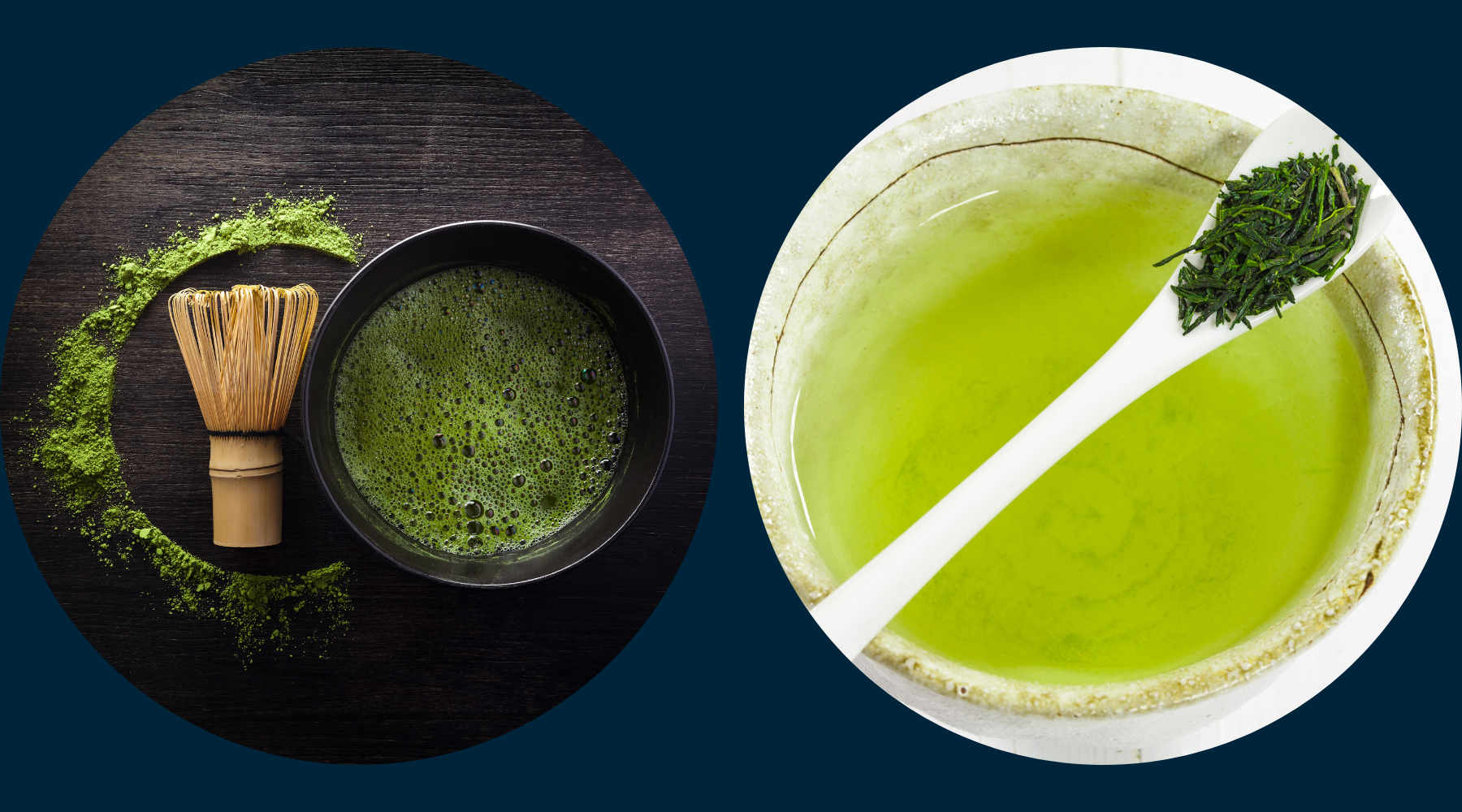
Matcha vs. Gyokuro: Die Unterschiede
Einführung
Matcha und Gyokuro sind beides bekannte japanische Grüntees, die aus der Pflanze Camellia sinensis gewonnen werden. Aber kennen Sie die wichtigsten Unterschiede zwischen ihnen? In diesem Artikel tauchen wir in die faszinierende Welt dieser beiden Teesorten ein und vergleichen ihre Herkunft, Herstellung, Geschmacksprofile, gesundheitlichen Vorteile, Brühtechniken, kulinarischen Verwendungsmöglichkeiten und vieles mehr.
Lassen Sie uns also eintauchen und herausfinden, welcher Tee zu Ihrem Geschmack und Lebensstil passt!
Die Ursprünge
Matcha
Matcha, mit seiner leuchtend grünen Farbe, stammt aus dem 12. Jahrhundert, als Zen-Buddhisten ihn aus China nach Japan brachten. Zunächst von Kaisern und der Elite verwendet, entwickelte sich Matcha-Tee bald zu einem beliebten Alltagsgetränk. Heute ist er weltweit für seinen unverwechselbaren Geschmack und seine gesundheitsfördernden Eigenschaften bekannt.
Gyokuro
Gyokuro, auch bekannt als „Jadetau“, ist ein hochwertiger Grüntee, der im 19. Jahrhundert in Japan entstand. Wie Matcha wächst Gyokuro im Schatten, seine Blätter werden jedoch sorgfältig von Hand gepflückt und anschließend zu feinen, nadelartigen Formen gerollt. Dieses einzigartige Verfahren verleiht Gyokuro seinen unverwechselbaren Geschmack und sein Aussehen.
Abonnieren Sie den RSS-Feed dieses Blogs unter http://premium-health-japan.myshopify.com/blogs/news.atom
Produktionsprozess
Schattenanbautechnik
Sowohl Matcha als auch Gyokuro werden im Schatten angebaut, d. h. sie werden vor der Ernte etwa 20 bis 30 Tage lang unter Dach kultiviert. Dieses Verfahren erhöht den Chlorophyllgehalt und reduziert die Tannine, was beiden Tees ihre charakteristische Süße und ihren Umami-Geschmack verleiht.
Ernte und Verarbeitung
Für Matcha werden die Blätter gedämpft, getrocknet und anschließend zu feinem Pulver gemahlen. Gyokuro hingegen wird geerntet, gedämpft und vor dem Trocknen zu dünnen, nadelartigen Teeblättern gerollt. Dieser Unterschied in der Verarbeitung beeinflusst den Geschmack und die Zubereitung der Tees.
Geschmacksprofile
Matcha
Matcha ist bekannt für seinen intensiven, umamireichen Geschmack mit einer leichten Süße und einer cremigen Textur. Er hat eine leuchtend grüne Farbe und ein starkes, grasiges Aroma.
Gyokuro
Gyokuro bietet einen zarten, süßen Geschmack mit einem reichen Umami-Aroma und einem seidigen Mundgefühl. Er hat eine tiefgrüne Farbe und ein frisches, grasiges Aroma mit einem Hauch von Seetang.
Gesundheitliche Vorteile
Matcha
Matcha ist reich an Antioxidantien, insbesondere Catechinen, die für ihre krebsbekämpfenden Eigenschaften bekannt sind. Außerdem enthält es L-Theanin, eine Aminosäure, die Entspannung fördert und Stress abbaut. Matcha sorgt für einen sanften Koffeinschub und ist damit eine hervorragende Alternative zu Kaffee für anhaltende Energie ohne Angstzustände.
Gyokuro
Gyokuro bietet viele der gleichen gesundheitlichen Vorteile wie Matcha, darunter einen hohen Gehalt an Antioxidantien und L-Theanin. Da Gyokuro-Blätter jedoch später geerntet werden, enthält er einen etwas höheren Koffeingehalt als Matcha und ist daher eine gute Wahl für alle, die einen stärkeren Energieschub suchen.
Brautechniken
Matcha
Zur Zubereitung von Matcha wird das Matcha-Pulver mit heißem Wasser mit einem Bambusbesen schaumig geschlagen. Die ideale Wassertemperatur für Matcha liegt bei 70–80 °C.
Gyokuro
Gyokuro wird aus ganzen Teeblättern gebrüht und benötigt eine niedrige Wassertemperatur von 60–70 °C, um seine feinen Aromen zu entfalten. Die Ziehzeit beträgt in der Regel 1–2 Minuten, und Sie können mehrere Aufgüsse derselben Teeblätter genießen.
Kulinarische Verwendung
Matcha
Matcha ist vielseitig einsetzbar und eignet sich perfekt für verschiedene Rezepte wie Smoothies, Lattes, Backwaren und sogar herzhafte Gerichte. Seine leuchtend grüne Farbe und sein einzigartiger Geschmack verleihen jedem Gericht eine raffinierte Note.
Gyokuro
Obwohl Gyokuro in der Küche nicht so häufig verwendet wird wie Matcha, kann er dennoch in Rezepte eingearbeitet werden, die grünen Tee erfordern. Sein subtiles Geschmacksprofil eignet sich gut für delikate Gerichte wie Desserts, Salate oder sogar als einfacher Eistee.
Matcha vs. Gyokuro – Koffein
Beim Vergleich von Matcha und Gyokuro ist es wichtig, den Koffeingehalt zu berücksichtigen, da dieser je nach Empfindlichkeit oder persönlichen Vorlieben Ihre Wahl beeinflussen kann.
Matcha
Matcha enthält je nach Sorte und Zubereitungsart etwa 30–70 Milligramm Koffein pro 230-ml-Portion. Diese Menge ist etwas höher als bei normalem Grüntee, aber niedriger als in einer Tasse Kaffee. Daher ist Matcha eine beliebte Wahl für einen ausgewogeneren und gleichmäßigeren Energieschub ohne Angstzustände.
Gyokuro
Gyokuro enthält etwa 40–80 Milligramm Koffein pro 230-ml-Portion und ist damit etwas koffeinreicher als Matcha. Dies liegt an der späteren Erntephase der Blätter, wodurch die Teepflanze mehr Koffein entwickeln kann. Der höhere Koffeingehalt von Gyokuro sorgt für einen stärkeren, nachhaltigeren Energieschub und ist daher die ideale Wahl für alle, die eine Alternative zu Kaffee mit zusätzlichen gesundheitlichen Vorteilen suchen.
Die richtige Wahl treffen
Berücksichtigen Sie bei der Wahl zwischen Matcha und Gyokuro aufgrund des Koffeingehalts Ihre persönlichen Vorlieben und Ihre Koffeinempfindlichkeit. Wenn Sie einen milderen, ausgewogeneren Energieschub suchen, ist Matcha möglicherweise die richtige Wahl. Bevorzugen Sie jedoch einen etwas stärkeren Koffeinkick, könnte Gyokuro die perfekte Option sein.
Bedenken Sie, dass beide Teesorten einzigartige Geschmackserlebnisse und gesundheitliche Vorteile bieten. Wenn Sie also mit beiden experimentieren, können Sie die perfekte Balance für Ihren Lebensstil finden.
Preisüberlegungen
Gyokuro ist aufgrund seines arbeitsintensiven Herstellungsprozesses und der begrenzten Verfügbarkeit im Allgemeinen teurer als Matcha. Beide Teesorten sind jedoch in verschiedenen Qualitäten und Preisklassen erhältlich, sodass Sie Optionen finden, die zu Ihrem Budget passen.
Die Wahl des richtigen Tees für Sie
Berücksichtigen Sie bei der Entscheidung zwischen Gyokuro und Matcha Ihre Geschmacksvorlieben, Ihre Gesundheitsziele und Ihre Zubereitungstechnik. Wenn Sie einen kräftigen, umamireichen Geschmack und die Bequemlichkeit von Pulvertee mögen, könnte Matcha die richtige Wahl sein. Bevorzugen Sie einen feineren, süßeren Geschmack und das Erlebnis, ganze Teeblätter aufzubrühen, könnte Gyokuro der ideale Tee für Sie sein.
Abschluss
Letztendlich bieten sowohl Matcha als auch Gyokuro einzigartige Geschmackserlebnisse und gesundheitliche Vorteile. Vielleicht genießen Sie beide Teesorten sogar zu unterschiedlichen Anlässen. Warum also nicht die Welt des japanischen Grüntees erkunden und die köstlichen Nuancen von Matcha und Gyokuro entdecken?
FAQs
-
Was ist der Hauptunterschied zwischen Matcha und Gyokuro? Der Hauptunterschied liegt in der Verarbeitung: Matcha wird zu feinem Pulver gemahlen, während Gyokuro zu nadelartigen Formen gerollt wird. Dies beeinflusst ihr Geschmacksprofil, ihre Zubereitungsmethoden und ihre kulinarische Verwendung.
-
Welcher Tee hat mehr Koffein, Matcha oder Gyokuro? Gyokuro hat aufgrund der späteren Ernte seiner Blätter normalerweise einen etwas höheren Koffeingehalt als Matcha.
-
Kann ich in Rezepten Gyokuro durch Matcha ersetzen und umgekehrt? Obwohl es möglich ist, die eine Sorte durch die andere zu ersetzen, sollten Sie sich bewusst sein, dass die unterschiedlichen Geschmacksprofile und Texturen das Endergebnis des Gerichts beeinflussen können. Am besten experimentieren Sie und passen die Menge oder Zubereitung nach Bedarf an, um den gewünschten Geschmack zu erzielen.
-
Wie lange bleiben Matcha und Gyokuro frisch? Um die Frische zu gewährleisten, sollten Matcha und Gyokuro in einem luftdichten Behälter, geschützt vor Licht, Feuchtigkeit und starken Gerüchen, aufbewahrt werden. Matcha sollte im Allgemeinen innerhalb von 3–6 Monaten nach dem Öffnen verzehrt werden, während Gyokuro bis zu einem Jahr frisch bleibt.
-
Sind Matcha und Gyokuro für Menschen mit Koffeinunverträglichkeit geeignet? Sowohl Matcha als auch Gyokuro enthalten Koffein, allerdings in unterschiedlichen Mengen. Wenn Sie empfindlich auf Koffein reagieren, sollten Sie diese Tees in Maßen genießen, auf koffeinärmere Alternativen zurückgreifen oder einen Arzt um Rat fragen.
Erfahren Sie mehr über Matcha:
Matcha und Akne: Kann es helfen, Ihre Haut zu reinigen?
Dieser Artikel untersucht die potenziellen Vorteile von Matcha für zu Akne neigende Haut. Matcha, ein fein gemahlenes Grünteepulver, ist reich an Antioxidantien und Nährstoffen, die Entzündungen reduzieren, Hormone regulieren und...

Matcha und Akne: Kann es helfen, Ihre Haut zu reinigen?
Gliederung |
|
|---|---|
| 1. Einleitung | |
| 2. Was ist Matcha? | |
| 2.1. Herkunft und Geschichte | |
| 2.2. Nährwertprofil | |
| 3. Was verursacht Akne? | |
| 3.1. Hormone | |
| 3.2. Bakterien | |
| 3.3. Verstopfte Poren | |
| 4. Wie Matcha bei Akne helfen kann | |
| 4.1. Antioxidantien | |
| 4.2. Entzündungshemmende Eigenschaften | |
| 4.3. Hormonregulierung | |
| 5. Wie man Matcha gegen Akne verwendet | |
| 5.1. Matcha trinken | |
| 5.2. Topische Anwendungen | |
| 6. Vorsichtsmaßnahmen und Nebenwirkungen | |
| 7. Fazit | |
| 8. FAQs |
1. Einleitung
Akne kann ganz schön lästig sein, oder? Egal ob Teenager oder Erwachsener, diese lästigen Pickel lassen uns einfach nicht los. Aber haben Sie schon einmal daran gedacht, Matcha zur Reinigung Ihrer Haut zu verwenden? Wenn Sie wissen möchten, wie Matcha bei Akne helfen kann, sind Sie hier genau richtig!
2. Was ist Matcha?

2.1. Herkunft und Geschichte
Matcha ist eine Grünteesorte, aber nicht irgendein Grüntee. Es handelt sich um ein fein gemahlenes Pulver aus speziell angebauten und verarbeiteten Teeblättern. Ursprünglich aus China stammend, gelangte Matcha im 12. Jahrhundert nach Japan, wo er zu einem festen Bestandteil der traditionellen japanischen Teezeremonie wurde.
2.2. Nährwertprofil
Matcha ist reich an Nährstoffen und Antioxidantien, die sowohl Ihrem Körper als auch Ihrer Haut guttun. Er enthält die Vitamine A, C und E sowie Mineralstoffe wie Kalium, Kalzium und Eisen. Im Vergleich zu herkömmlichem Grüntee weist Matcha außerdem eine höhere Konzentration des Antioxidans EGCG auf.
3. Was verursacht Akne?

3.1. Hormone
Hormone spielen eine wichtige Rolle bei der Entstehung von Akne. Androgene wie Testosteron können die Talgproduktion erhöhen, was zu fettiger Haut und verstopften Poren führt.
3.2. Bakterien
Bakterien, insbesondere Propionibacterium acnes, können Entzündungen und Rötungen verursachen, wenn sie mit überschüssigem Talg in den Haarfollikeln eingeschlossen werden.
3.3. Verstopfte Poren
Wenn sich abgestorbene Hautzellen, Öl und Bakterien ansammeln, können diese Ihre Poren verstopfen und zur Bildung von Pickeln, Mitessern und Whiteheads führen.
4. Wie Matcha bei Akne helfen kann
4.1. Antioxidantien
Der hohe Gehalt an Antioxidantien in Matcha kann dazu beitragen, Ihre Haut vor freien Radikalen zu schützen, die Entzündungen und Schäden an den Hautzellen verursachen können.
4.2. Entzündungshemmende Eigenschaften
Matcha enthält starke entzündungshemmende Verbindungen wie EGCG, die die mit Akne verbundenen Rötungen und Entzündungen reduzieren können.
4.3. Hormonregulierung
Einige Studien deuten darauf hin, dass der Konsum von grünem Tee zur Regulierung des Hormonspiegels beitragen kann, was möglicherweise zu einer Verringerung der Akneausbrüche führen könnte.
5. Wie man Matcha gegen Akne verwendet
5.1. Matcha trinken
Integrieren Sie Matcha in Ihren Alltag, indem Sie ihn als Tee trinken oder zu Smoothies und Lattes hinzufügen. Regelmäßiger Matcha-Konsum kann Ihnen helfen, von seinen potenziellen Vorteilen bei der Bekämpfung von Akne zu profitieren.
5.2. Topische Anwendungen
Sie können Matcha auch direkt auf Ihre Haut auftragen, indem Sie eine DIY-Matcha-Gesichtsmaske herstellen. Mischen Sie Matcha-Pulver mit Wasser, Honig oder Joghurt zu einer Paste und tragen Sie diese auf Ihr Gesicht auf. Lassen Sie die Maske 10–15 Minuten einwirken, bevor Sie sie mit warmem Wasser abspülen. Dies kann helfen, Entzündungen und Rötungen zu reduzieren und Ihre Haut sanft zu peelen.
6. Vorsichtsmaßnahmen und Nebenwirkungen
Obwohl Matcha im Allgemeinen unbedenklich zum Verzehr und zur äußerlichen Anwendung ist, ist Vorsicht geboten. Wenn Sie Matcha zum ersten Mal verwenden, beginnen Sie mit kleinen Mengen, um zu sehen, wie Ihr Körper reagiert. In manchen Fällen können Magenverstimmungen oder allergische Reaktionen auftreten. Führen Sie bei der äußerlichen Anwendung von Matcha immer zuerst einen Verträglichkeitstest durch, um sicherzustellen, dass keine Nebenwirkungen auftreten.
7. Fazit
Die antioxidativen und entzündungshemmenden Eigenschaften von Matcha können möglicherweise dazu beitragen, Ihre Haut zu reinigen, indem sie Entzündungen reduzieren, Hormone regulieren und vor Schäden durch freie Radikale schützen. Obwohl es keine Garantie dafür gibt, dass Matcha bei jedem wirkt, lohnt es sich, es auszuprobieren, wenn Sie nach einer natürlichen Methode zur Bekämpfung von Akne suchen. Seien Sie jedoch vorsichtig und konsultieren Sie bei Bedenken einen Dermatologen.
8. FAQs
1. Kann ich jedes Grünteepulver zur Aknebehandlung verwenden?
Zwar kann jedes Grünteepulver einige Vorteile bieten, Matcha weist jedoch eine höhere Konzentration an Antioxidantien und Nährstoffen auf und ist daher die bessere Wahl für die Aknebehandlung.
2. Wie oft sollte ich Matcha gegen Akne trinken?
Es gibt keine feste Regel, aber wenn Sie Matcha in Ihren Alltag integrieren, indem Sie beispielsweise ein oder zwei Tassen pro Tag trinken, können Sie von den potenziellen Vorteilen profitieren.
3. Kann ich Matcha verwenden, wenn ich empfindliche Haut habe?
Ja, aber seien Sie vorsichtig. Machen Sie immer einen Patch-Test, bevor Sie Matcha auf Ihr Gesicht auftragen, und verwenden Sie in Ihrer selbstgemachten Gesichtsmaske eine sanftere Zutat wie Joghurt.
4. Kann ich meine Aknemedikamente durch Matcha ersetzen?
Es wird nicht empfohlen, verschriebene Aknemedikamente ohne Rücksprache mit Ihrem Hautarzt durch Matcha zu ersetzen. Matcha kann eine hilfreiche Ergänzung Ihrer Hautpflegeroutine sein, ersetzt aber nicht die professionelle medizinische Beratung.
5. Wie lange dauert es, bis sich bei der Anwendung von Matcha gegen Akne Ergebnisse zeigen?
Die Ergebnisse können von Person zu Person unterschiedlich sein. Manche sehen bereits nach wenigen Wochen eine Verbesserung, andere brauchen länger. Konstanz ist der Schlüssel zur Aknebehandlung mit Matcha.
Abonnieren Sie den RSS-Feed dieses Blogs unter http://premium-health-japan.myshopify.com/blogs/news.atom
Japanische Teezeremonien: Ein Leitfaden für Anfänger
In diesem Anfängerleitfaden zu japanischen Teezeremonien befassen wir uns eingehend mit der Geschichte, den Prinzipien und den Arten von Teezeremonien und geben gleichzeitig Einblick in die Bedeutung der Ästhetik und...

Japanische Teezeremonien: Ein Leitfaden für Anfänger
Einführung
Tauchen Sie mit diesem Anfängerleitfaden zu japanischen Teezeremonien in das reiche kulturelle Erbe Japans ein. Diese ruhigen Rituale sind seit Jahrhunderten fester Bestandteil der japanischen Tradition und bieten ein transformierendes Erlebnis, das Sie in eine Welt der Achtsamkeit, Gastfreundschaft und Kunstfertigkeit entführt.
In diesem umfassenden Leitfaden erkunden wir die Geschichte, die wichtigsten Elemente und die Bedeutung japanischer Teezeremonien und zeigen Ihnen, wie Sie an einer solchen Zeremonie teilnehmen oder sie sogar selbst veranstalten können.
Die Geschichte der japanischen Teezeremonien
Die Ursprünge der japanischen Teezeremonie, auch bekannt als „Chanoyu“ oder „Sado“, gehen zurück auf China, wo Tee erstmals entdeckt und genossen wurde. Buddhistische Mönche brachten ihn im 9. Jahrhundert nach Japan. Sie nutzten ihn zunächst als Mittel zur Wachsamkeit während der Meditation. Im Laufe der Zeit entwickelte sich der Teegenuss in Japan zu einem anspruchsvollen Ritual mit tiefer spiritueller und kultureller Bedeutung.
Die Teezeremonie, wie wir sie heute kennen, wurde stark vom Zen-Buddhismus sowie der Ästhetik und den Prinzipien der japanischen Kultur beeinflusst. Sen no Rikyu, ein Teemeister des 16. Jahrhunderts, gilt als Vater der modernen Teezeremonie. Er betonte die Bedeutung von Einfachheit, Reinheit und Harmonie in der Teepraxis, und seine Lehren bilden bis heute die Grundlage japanischer Teezeremonien.
Die Prinzipien der Teezeremonie
Die japanische Teezeremonie basiert auf vier Grundprinzipien: Harmonie (wa), Respekt (kei), Reinheit (sei) und Ruhe (jaku). Diese Prinzipien sind nicht nur für die Teezeremonie selbst wesentlich, sondern dienen auch als Leitfaden für ein ausgeglichenes und erfülltes Leben.
Harmonie (wa):
Dieses Prinzip fördert die Wertschätzung der Natur, der Schönheit und der Verbindungen zwischen Mensch und Umwelt. Die Teilnehmer der Teezeremonie sollen sich miteinander und mit ihrer Umgebung im Einklang fühlen.
Respekt (kei):
Respekt ist während einer Teezeremonie entscheidend, da er gegenseitiges Verständnis und Wertschätzung fördert. Dies kann durch Gesten, Worte und den Umgang mit Teeutensilien zum Ausdruck gebracht werden.
Reinheit (sei):
Die Reinigung des eigenen Körpers und des Zeremonienraums ist ein wesentlicher Bestandteil der Teezeremonie. Dazu gehört die physische Reinigung des Teeraums und der Utensilien sowie die spirituelle Reinigung des eigenen Geistes.
Ruhe (Jaku):
Das Erreichen eines Zustands innerer Ruhe und Gelassenheit ist das ultimative Ziel der Teezeremonie. Sie ermöglicht es den Teilnehmern, ganz im Moment präsent zu sein, frei von den Ablenkungen des Alltags.
Der Ablauf der Teezeremonie

Die japanische Teezeremonie folgt typischerweise einer genauen Abfolge von Ereignissen, die die folgenden Schritte umfasst:
Vorbereitung:
Der Gastgeber reinigt den Teeraum und bereitet das Teegeschirr vor, während die Gäste bei ihrer Ankunft Hände und Mund mit Wasser reinigen. Dieser Reinigungsprozess symbolisiert das Verlassen der Außenwelt und das Betreten eines heiligen Ortes.
Der Auftritt des Gastgebers:
Der Gastgeber betritt den Teeraum und reinigt das Teegeschirr mit einem Seidentuch, was die Entfernung von Staub und Verunreinigungen symbolisiert.
Die Teezubereitung:
Der Gastgeber bereitet den Tee zu, indem er pulverisierten grünen Tee (Matcha) in eine Teeschale gibt und ihn mit einem Bambusbesen mit heißem Wasser verquirlt. Der Tee ist normalerweise dick und schaumig und hat ein reichhaltiges, erdiges Aroma.
Servieren des Tees:
Der Gastgeber serviert den Tee den Gästen, die das Design und die Handwerkskunst der Teeschale bewundern, bevor sie den Tee trinken.
Erfrischungen:
Leichte Süßigkeiten, „Wagashi“ genannt, werden oft vor oder zum Tee serviert, um den bitteren Geschmack des Matcha auszugleichen.
Abschluss:
Der Gastgeber reinigt das Teegeschirr ein letztes Mal und dankt den Gästen für ihre Teilnahme. Die Gäste bedanken sich beim Gastgeber und verabschieden sich. Damit ist die Teezeremonie beendet.
Die Rolle der Ästhetik in der Teezeremonie
Ästhetik spielt in der japanischen Teezeremonie eine wichtige Rolle. Schlichtheit, Eleganz und eine tiefe Wertschätzung für Schönheit stehen im Mittelpunkt. Der Teeraum selbst ist sorgfältig gestaltet und dekoriert, um eine ruhige und harmonische Atmosphäre zu schaffen. Natürliche Materialien wie Tatami-Matten, Papierschirme und Holzutensilien bringen die Essenz der Natur in den Raum.
Saisonale Elemente wie Blumen oder hängende Schriftrollen werden sorgfältig ausgewählt und im Teeraum platziert, um das Gesamterlebnis zu verbessern. Selbst kleinste Details wie Form, Farbe und Textur der Teeutensilien werden mit Sorgfalt ausgewählt, um ein Gefühl von Schönheit und Harmonie zu vermitteln.
Arten von Teezeremonien
In Japan gibt es zwei Hauptarten von Teezeremonien: die formelle „Chaji“ und die eher zwanglose „Chakai“.
Chaji:
Ein Chaji ist eine aufwendige, formelle Teezeremonie, die bis zu vier Stunden dauern kann. Sie umfasst ein mehrgängiges Menü (Kaiseki), gefolgt von der Gabe von dickem Tee (Koicha) und dünnem Tee (Usucha). Das Chaji findet oft in einem traditionellen Teehaus oder einem separaten Teeraum in einem Privathaus statt, und von den Teilnehmern wird erwartet, dass sie die strenge Etikette einhalten.
Chakai:
Ein Chakai ist eine informellere Teezeremonie, die in der Regel etwa eine Stunde dauert. Dabei werden in der Regel dünner Tee (Usucha) und Süßigkeiten serviert, ohne dass ein komplettes Menü angeboten wird. Das Chakai ist für Anfänger leichter zugänglich, da es eine weniger formelle Einführung in die Welt der Teezeremonie bietet.
Teilnahme an einer Teezeremonie

Wenn Sie selbst an einer japanischen Teezeremonie teilnehmen möchten, gibt es mehrere Möglichkeiten:
Besuchen Sie Japan:
Viele traditionelle Teehäuser, Kulturzentren und sogar einige Hotels in Japan bieten Besuchern Teezeremonien an. Informieren Sie sich unbedingt im Voraus und buchen Sie, da für manche Veranstaltungsorte eine Reservierung erforderlich ist.
Nehmen Sie an einem Workshop oder Kurs in Ihrer Nähe teil:
In einigen Städten weltweit gibt es japanische Kulturzentren oder Teeschulen, die Workshops oder Kurse zur Teezeremonie anbieten. Dies kann eine großartige Möglichkeit sein, die Feinheiten der Teezeremonie kennenzulernen und sogar Ihre Fähigkeiten zu üben.
Veranstalten Sie Ihre eigene Teezeremonie:
Mit etwas Recherche, Übung und den richtigen Werkzeugen können Sie eine einfache Teezeremonie zu Hause veranstalten. Bedenken Sie, dass es einige Zeit dauern kann, die verschiedenen Techniken und die Etikette zu beherrschen, aber die Erfahrung kann unglaublich lohnend sein.
Abschluss
Die japanische Teezeremonie ist eine wunderschöne und meditative Praxis, die die Prinzipien von Harmonie, Respekt, Reinheit und Ruhe verkörpert. Durch die Teilnahme an dieser jahrhundertealten Tradition können Sie die japanische Kultur und Ästhetik tiefer schätzen lernen und gleichzeitig ein Gefühl von innerem Frieden und Achtsamkeit entwickeln.
Egal, ob Sie an einem formellen Chaji oder einem eher zwanglosen Chakai teilnehmen, die Teilnahme an einer japanischen Teezeremonie wird mit Sicherheit eine unvergessliche und bereichernde Erfahrung sein.
Weitere Informationen zu diesem alten Brauch finden Sie auf unserer Seite zur japanischen Teezeremonie .
Matcha: Eine kurze Geschichte
Dieser Artikel erforscht die reiche Geschichte von Matcha, einem kräftigen Grünteepulver, von seinen Ursprüngen in Chinas Tang- und Song-Dynastien bis zu seiner Einführung und Entwicklung in Japan. Als Matcha zu...

Matcha: Eine kurze Geschichte
Einführung
Matcha, das kräftige Grünteepulver, erfreut sich weltweit großer Beliebtheit aufgrund seines betörenden Geschmacks und seiner zahlreichen gesundheitlichen Vorteile. Auch wenn seine Präsenz in Cafés und Supermärkten wie ein neuer Trend erscheint, ist Matchas Geschichte tief verwurzelt und erstreckt sich über ein Jahrtausend.
Dieser Artikel befasst sich mit der faszinierenden Geschichte des Matcha, von seinen bescheidenen Anfängen im alten China bis zu seinem hohen Stellenwert in der japanischen Kultur.
Die frühen Anfänge: China
Die Geschichte des Matcha geht auf die Tang-Dynastie in China zurück, etwa im 7. bis 10. Jahrhundert. In dieser Zeit galt Tee als kostbares Gut und war oft der Elite vorbehalten. Teeblätter wurden geerntet, gedämpft und für Transport und Handel zu Ziegeln gepresst – die damals bequemste Methode.
Um eine Tasse Tee zuzubereiten, wurde ein Stück des Teeziegels abgebrochen, pulverisiert und mit heißem Wasser vermischt. Diese frühe Teezubereitungsmethode legte den Grundstein für das, was später Matcha werden sollte.
Während der Song-Dynastie (960–1279) erlebten Teeanbau und -konsum eine Blütezeit. Die Chinesen führten eine neue Methode der Teezubereitung ein, die als „Tee verquirlen“ bekannt wurde. Teeblätter wurden zu feinem Pulver gemahlen und mit heißem Wasser verquirlt, wodurch ein schaumiges Getränk entstand, das dem heutigen Matcha sehr ähnelte. Diese neue Art des Teegenusses erfreute sich großer Beliebtheit und wurde 1107 sogar in der berühmten „Abhandlung über Tee“ von Kaiser Huizong gewürdigt.
Die Reise nach Japan

Die Ursprünge von Matcha in Japan reichen bis ins 12. Jahrhundert zurück, als der Zen-buddhistische Mönch Eisai Teesamen aus China in den Inselstaat brachte. Die Samen wurden in der Region Kyoto gepflanzt, und die Japaner begannen mit dem Teeanbau. Doch erst in der Kamakura-Zeit (1185–1333) begann Matcha, wie wir ihn heute kennen, in Japan Gestalt anzunehmen.
Eisai, dem die Popularisierung des Zen-Buddhismus in Japan zugeschrieben wird, war auch maßgeblich an der Einführung des Teeaufschäumens beteiligt. Er schrieb 1211 das berühmte Buch „Kissa Yōjōki“ (喫茶養生記), was übersetzt „Teetrinken für die Gesundheit“ bedeutet. Das Buch pries die gesundheitsfördernde Wirkung von Tee, insbesondere von Matcha, und empfahl dessen Genuss als Mittel zur Förderung geistiger Klarheit und Langlebigkeit.
Matcha und Zen-Buddhismus
Die Verbindung zwischen Matcha und dem Zen-Buddhismus ist untrennbar. Die Zen-Mönche betrachteten das Ritual der Matcha-Zubereitung und des Matcha-Genusses als eine Form der Meditation, die ihnen half, den für ihre Praxis notwendigen Zustand der Konzentration und Achtsamkeit zu erreichen. Die Teezeremonie, bekannt als „chado“ oder „sado“ (茶道), wurde zu einem integralen Bestandteil des Klosterlebens.
Die Entwicklung der Teezeremonie wird oft Murata Jukō (1423–1502) zugeschrieben, einem Zen-Mönch, der die spirituellen Aspekte des Teetrinkens betonte. Jukō gilt als Vater der japanischen Teezeremonie und propagierte „Wabi-Sabi“ – eine Wertschätzung von Einfachheit, Bescheidenheit und der Unvollkommenheit des Lebens. Diese Philosophie wurde zum Eckpfeiler der Teezeremonie und ist bis heute ihr Kern.
Matcha in der japanischen Kriegerklasse

Im 14. und 15. Jahrhundert verbreitete sich der Matcha-Konsum über die Grenzen der Klöster hinaus bis in die Samurai-Klasse. Die Krieger, inspiriert von den Zen-Mönchen, integrierten die Teezeremonie in ihren Verhaltenskodex, bekannt als „Bushido“. Die Samurai glaubten, dass die Praxis des Chado ihnen half, Disziplin, mentale Stärke und ein gesteigertes Bewusstsein zu entwickeln.
Teetreffen, auch „Chanoyu“ genannt, wurden zu einem wesentlichen Bestandteil der Samurai-Kultur. Sie boten den Kriegern die Möglichkeit, Bündnisse zu schmieden und ihre Meisterschaft in der Teezeremonie unter Beweis zu stellen. Bei diesen Treffen konnten sie auch ihre exquisiten Teeutensilien präsentieren, die oft als Statussymbole galten.
Das goldene Zeitalter des Matcha

Das 16. Jahrhundert markierte einen Wendepunkt in der Geschichte des Matcha und wird oft als sein goldenes Zeitalter bezeichnet. Die japanische Teezeremonie erfreute sich großer Beliebtheit, und Matcha wurde zum Symbol für Luxus und Raffinesse. In dieser Zeit entstanden die „großen Teemeister“ wie Sen no Rikyū (1522–1591), die die Entwicklung der Teezeremonie maßgeblich beeinflussten.
Rikyū, der angesehenste Teemeister der japanischen Geschichte, führte mehrere Neuerungen in die Teezeremonie ein, die bis heute praktiziert werden. Er betonte die Bedeutung von Harmonie, Respekt, Reinheit und Ruhe – den vier Prinzipien des Chado. Rikyū plädierte außerdem für die Verwendung lokal gefertigter, rustikaler Teeutensilien, die der Wabi-Sabi-Ästhetik entsprachen.
Hier erfahren Sie alles Wissenswerte über die japanische Teezeremonie.
Der Niedergang und die Wiederauferstehung von Matcha
Während der Edo-Zeit (1603–1868) nahm die Beliebtheit von Matcha ab, da die einfachen Leute Sencha, eine günstigere und leichter zugängliche Form von grünem Tee, bevorzugten. Matcha wurde zunehmend mit der Elite in Verbindung gebracht, und sein Konsum beschränkte sich hauptsächlich auf den Adel und die Samurai-Klasse.
Die moderne Renaissance von Matcha begann im späten 20. Jahrhundert, als seine gesundheitlichen Vorteile die Aufmerksamkeit der Weltöffentlichkeit erregten. Matcha ist reich an Antioxidantien, insbesondere Catechinen, und wird mit einer Reihe von gesundheitlichen Vorteilen in Verbindung gebracht, darunter eine verbesserte Herzgesundheit, ein gesteigerter Stoffwechsel und eine verringerte Entzündungsreaktion.
Darüber hinaus wird angenommen, dass das Vorhandensein von L-Theanin, einer in Matcha enthaltenen Aminosäure, die Entspannung fördert und Stress reduziert, was im Einklang mit den Zen-Prinzipien steht, die seit langem mit dem Matcha-Konsum in Verbindung gebracht werden.
Heute wird Matcha weltweit als vielseitige Zutat in einer Vielzahl von kulinarischen Anwendungen geschätzt, vom traditionellen Tee über Lattes und Smoothies bis hin zu Backwaren. Seine leuchtend grüne Farbe, sein einzigartiger Geschmack und seine zahlreichen gesundheitlichen Vorteile haben seinen Status als begehrtes Superfood gefestigt.
Abschluss
Die Geschichte des Matcha ist eine faszinierende Reise, die die komplexe Beziehung zwischen Kultur, Spiritualität und Teekunst widerspiegelt. Von seinen Anfängen im alten China bis zu seiner Entwicklung in Japan als Symbol des Zen-Buddhismus und des Verhaltenskodex der Samurai hat Matcha Zeit und Grenzen überwunden und sich weltweit zu einem beliebten Getränk entwickelt.
Möchten Sie mehr über die Geschichte von Matcha erfahren? Schauen Sie sich unsere Seite zur Geschichte von Matcha an.
Während wir jeden Schluck dieses kräftigen grünen Tees genießen, nehmen wir an einer jahrhundertealten Tradition teil und schätzen die Harmonie, den Respekt, die Reinheit und die Ruhe, die er verkörpert.
Matcha und Gehirngesundheit: Wie dieses Superfood Konzentration, Gedächtnis und Kreativität steigern kann
Matcha, ein pulverisierter grüner Tee, soll die kognitiven Funktionen steigern und die Gehirngesundheit fördern. Dieser Artikel untersucht, wie Matcha die kognitiven Funktionen verbessern kann, einschließlich seiner Fähigkeit, Konzentration, Aufmerksamkeitsspanne, Gedächtnis...

Matcha und Gehirngesundheit: Wie dieses Superfood Konzentration, Gedächtnis und Kreativität steigern kann
Matcha ist ein fein gemahlenes Grünteepulver, das in Japan seit Jahrhunderten genossen wird. Im Gegensatz zu normalem Grüntee, bei dem die Teeblätter in heißem Wasser ziehen und anschließend entsorgt werden, wird Matcha-Tee hergestellt, indem das gesamte Teeblatt zu Pulver gemahlen und anschließend in heißes Wasser eingerührt wird. Dieses Verfahren ermöglicht eine höhere Konzentration an Nährstoffen und Antioxidantien und macht Matcha zu einem wahren Superfood .
In den letzten Jahren hat Matcha im Westen als trendige Zutat in Lattes, Smoothies und Backwaren an Popularität gewonnen. Neben seinem köstlichen Geschmack und seiner leuchtend grünen Farbe hat Matcha auch eine Reihe gesundheitlicher Vorteile, insbesondere für die Gehirnfunktion.
In diesem Artikel untersuchen wir, wie Matcha die kognitive Funktion verbessern kann, die Wissenschaft hinter seinen gehirnfördernden Eigenschaften und einige köstliche Matcha-Rezepte für die Gehirngesundheit.
Wie Matcha die kognitive Funktion verbessert
Das Koffein in Matcha kann die kognitiven Funktionen verbessern. Wie Kaffee enthält Matcha Koffein , das das zentrale Nervensystem stimuliert und die Aufmerksamkeit und Konzentration steigern kann. Im Gegensatz zu Kaffee enthält Matcha jedoch auch die Aminosäure L-Theanin , die beruhigend auf das Gehirn wirkt und Angst und Stress abbauen kann.
Die Kombination aus Koffein und L-Theanin macht Matcha so einzigartig. Während Koffein manchmal Angstzustände auslösen kann, kann das L-Theanin in Matcha diesen Effekten entgegenwirken und ein Gefühl der Entspannung und Konzentration fördern. Dies liegt daran, dass L-Theanin nachweislich die Alpha-Gehirnwellen erhöht , die mit einem Zustand entspannter Wachsamkeit verbunden sind.
Die Wissenschaft von Matcha und der Gehirngesundheit
Matcha war Gegenstand mehrerer Studien, die seine Auswirkungen auf die Gehirnfunktion untersuchten. Eine Studie Eine im Journal of Medicinal Food veröffentlichte Studie ergab, dass der Konsum von Matcha die Aufmerksamkeit und Reaktionszeit der Teilnehmer im Vergleich zu einer Placebogruppe verbesserte. Eine weitere Studie fanden heraus, dass Matcha die kognitive Funktion während oder nach Stresssituationen bei jungen Erwachsenen verbessern kann.
Die hohe Konzentration an Antioxidantien in Matcha soll auch zu seinen gehirnfördernden Eigenschaften beitragen. Antioxidantien sind Verbindungen, die den Körper vor oxidativem Stress schützen, der Zellen schädigen und zu Alterung und Krankheiten beitragen kann. Insbesondere das Antioxidans Epigallocatechingallat (EGCG) in Matcha hat nachweislich neuroprotektive Wirkungen und kann dazu beitragen, kognitiven Abbau zu verhindern.
Abonnieren Sie den RSS-Feed dieses Blogs unter http://premium-health-japan.myshopify.com/blogs/news.atom
Matcha und Aufmerksamkeitsspanne: Steigerung von Fokus und Konzentration
Das Koffein und L-Theanin in Matcha können zusammenwirken, um die Aufmerksamkeitsspanne und Konzentration zu verbessern. Studie kam zu dem Schluss, dass die Kombination von L-Theanin und Koffein wahrscheinlich ein sicherer und wirksamer kognitiver Verstärker ist.
Ein anderer Studie Eine in der Fachzeitschrift Nutritional Neuroscience veröffentlichte Studie ergab, dass der Konsum einer Kombination aus Koffein und L-Theanin, wie sie in Matcha vorkommt, die Aufmerksamkeit und das Aufgabenwechselvermögen bei Teilnehmern verbesserte, die eine anspruchsvolle kognitive Aufgabe ausführten.
Gedächtnisfördernde Vorteile von Matcha
Matcha verbessert nicht nur Aufmerksamkeit und Konzentration, sondern kann auch das Gedächtnis fördern. Studie Eine in der Fachzeitschrift Bentham Science veröffentlichte Studie ergab, dass der Konsum von Grüntee-Extrakt, der viele der gleichen Verbindungen wie Matcha enthält, das Gedächtnis und die kognitiven Funktionen bei gesunden Erwachsenen verbesserte.
Ein anderer Studie Im Journal of Nutrition wurde festgestellt, dass das Trinken von grünem Tee mit einem verringerten Risiko kognitiver Beeinträchtigungen bei älteren Erwachsenen verbunden ist. Obwohl weitere Forschung erforderlich ist, um die spezifischen Auswirkungen von Matcha auf das Gedächtnis zu bestimmen, deuten diese Studien darauf hin, dass die Antioxidantien und anderen Verbindungen in Matcha Gedächtnisverlust entgegenwirken können .
Matcha und Kreativität: Verbesserung der Gehirnfunktion für mehr Produktivität
Das Koffein und L-Theanin in Matcha können auch Kreativität und Produktivität steigern. Das Koffein in Matcha kann Wachsamkeit und Energie steigern, während das L-Theanin Entspannung und Konzentration fördern kann.
Diese Kombination kann kreatives Denken anregen und die Produktivität steigern. Darüber hinaus können die Antioxidantien in Matcha dazu beitragen, Gehirnzellen vor Schäden zu schützen und die allgemeine Gehirngesundheit zu fördern, was die Kreativität und Produktivität langfristig fördern kann.
Die Rolle von Antioxidantien bei Matcha und der Gehirngesundheit
Antioxidantien spielen eine wichtige Rolle für die Gesundheit des Gehirns, da sie dazu beitragen können, Gehirnzellen vor Schäden und Entzündungen zu schützen. Oxidativer Stress, der durch ein Ungleichgewicht zwischen Antioxidantien und freien Radikalen im Körper verursacht wird, kann zu Alterung und Krankheiten beitragen.
Durch den Verzehr von Nahrungsmitteln und Getränken mit einem hohen Anteil an Antioxidantien, wie beispielsweise Matcha-Grüntee, können Sie die Gesundheit Ihres Gehirns unterstützen und das Risiko eines kognitiven Abbaus verringern.
Das Antioxidantienprofil von Matcha und seine Vorteile für die Gehirngesundheit
Matcha ist reich an Antioxidantien, darunter Catechine, Flavonoide und Polyphenole. Ein besonderes Antioxidans in Matcha ist Epigallocatechingallat (EGCG), das nachweislich neuroprotektive Wirkungen hat und kognitivem Abbau vorbeugen kann.
In einem Studie Im Journal of Alzheimer's Disease veröffentlichten Forscher fanden heraus, dass EGCG Beta-Amyloid-Plaques im Gehirn reduzieren kann, die ein Kennzeichen der Alzheimer-Krankheit sind. Ein weiterer Studie fanden heraus, dass EGCG die kognitive Funktion verbessern und die Gehirnentzündung bei Mäusen mit Alzheimer-ähnlichen Symptomen reduzieren kann.
Diese Studien legen nahe, dass die Antioxidantien in Matcha, insbesondere EGCG, einen starken Nutzen für die Gehirngesundheit haben und zum Schutz vor kognitivem Abbau und Erkrankungen beitragen können.
Wie Matcha-L-Theanin die Gehirnströme beeinflusst und Stress reduziert
L-Theanin ist eine Aminosäure, die in Matcha vorkommt und nachweislich eine beruhigende Wirkung auf das Gehirn hat. Sie wirkt durch die Erhöhung der Alpha-Gehirnwellen, die mit einem Zustand entspannter Wachsamkeit verbunden sind. Dies kann dazu beitragen, Stress und Angstzustände zu reduzieren, die sich negativ auf die kognitiven Funktionen auswirken können.
In einem Studie Im Journal of Functional Foods veröffentlicht, fanden Forscher heraus, dass der Konsum von L-Theanin die Entspannung der Teilnehmer im Vergleich zu einer Placebogruppe verbesserte und Stress reduzierte. Ein weiterer Studie Eine in der Fachzeitschrift „Biological Psychology“ veröffentlichte Studie ergab, dass L-Theanin die Aufmerksamkeit und Reaktionszeit als Reaktion auf kognitiven Stress verbessern kann.
Diese Studien legen nahe, dass das L-Theanin in Matcha eine starke Wirkung bei der Stressreduzierung und Verbesserung der kognitiven Funktion haben kann.
Neuroprotektive Eigenschaften von Matcha und wie sie das Gehirn vor Alterung und Krankheiten schützen
Die Antioxidantien und anderen Inhaltsstoffe in Matcha haben starke neuroprotektive Eigenschaften, die das Gehirn vor Alterung und Erkrankungen schützen können. Neben seinen Antioxidantien enthält Matcha auch andere Verbindungen mit nachweislich neuroprotektiver Wirkung , darunter die Aminosäure Theanin und das Polyphenol Catechin.
Eins Studie Eine in der Fachzeitschrift Nutrients veröffentlichte Studie ergab, dass das Trinken von grünem Tee, der viele der gleichen Inhaltsstoffe wie Matcha enthält, mit einem geringeren Risiko für kognitiven Abbau bei älteren Erwachsenen verbunden war. Eine weitere Studie Im Journal of Neuroscience wurde festgestellt, dass das Polyphenol Catechin das räumliche Gedächtnis verbessern und den kognitiven Abbau bei Mäusen verringern kann.
Diese Studien legen nahe, dass der Konsum von Matcha mit seiner hohen Konzentration an Antioxidantien, Theanin und Catechinen dazu beitragen kann, das Gehirn vor Alterung und Krankheiten zu schützen und die allgemeine Gehirngesundheit zu unterstützen.
Matcha-Rezepte für die Gehirngesundheit
Nachdem wir nun die wissenschaftlichen Hintergründe zu Matcha und der Gehirngesundheit erforscht haben, werfen wir einen Blick auf einige köstliche Matcha-Rezepte, die die kognitive Funktion unterstützen können.
Matcha-Latte-Rezept zur Steigerung der kognitiven Funktion
Zutaten:
-
1 Teelöffel Matcha-Pulver
-
1 Tasse Mandelmilch
-
1 Teelöffel Honig
Anweisungen:
-
Erhitzen Sie die Mandelmilch in einem kleinen Topf bei mittlerer Hitze, bis sie zu dampfen beginnt.
-
Verquirlen Sie in einer separaten Schüssel das Matcha-Pulver mit einem Schuss heißem Wasser, bis eine glatte Paste entsteht.
-
Gießen Sie die Matcha-Paste in den Topf mit der Mandelmilch und verquirlen Sie alles, bis es gut vermischt ist.
-
Den Honig hinzufügen und weiterrühren, bis alles gut vermischt ist.
-
Gießen Sie den Matcha Latte in eine Tasse und genießen Sie ihn.
Dieses Matcha-Latte-Rezept ist ein toller Start in den Tag und gibt deinem Gehirn einen Energieschub und steigert deine Konzentration. Die Mandelmilch sorgt für einen cremigen und nussigen Geschmack, während der Honig für eine süße Note sorgt.
Matcha-Smoothie-Rezept für eine verbesserte Gehirnfunktion
Zutaten:
-
1 Teelöffel Matcha-Pulver
-
1 Banane
-
1 Tasse Mandelmilch
-
1/2 Tasse gefrorene Blaubeeren
-
1 Esslöffel Honig
Anweisungen:
-
Alle Zutaten in einen Mixer geben und glatt rühren.
-
Den Matcha-Smoothie in ein Glas geben und genießen.
Dieses Matcha-Smoothie-Rezept steckt voller Antioxidantien und leistungssteigernder Nährstoffe. Die Banane sorgt für eine cremige Textur, während die Blaubeeren für einen süß-säuerlichen Geschmack sorgen. Mandelmilch und Honig runden das Ganze ab und ergeben ein köstliches und gesundes Getränk.
Matcha-Energiebällchen-Rezept für geistige Klarheit und Konzentration
Zutaten:
-
1 Tasse Haferflocken
-
1/2 Tasse Mandelbutter
-
1/4 Tasse Honig
-
1/4 Tasse ungesüßte Kokosraspeln
-
1 Esslöffel Matcha-Grünteepulver
Anweisungen:
-
Mischen Sie in einer großen Schüssel alle Zutaten, bis sie gut vermischt sind.
-
Rollen Sie die Mischung zu kleinen Kugeln, etwa in der Größe eines Esslöffels.
-
Legen Sie die Matcha-Energiebällchen für mindestens 30 Minuten in den Kühlschrank, damit sie fest werden.
-
Sobald die Energiebällchen fest sind, können Sie sie in einem luftdichten Behälter im Kühlschrank aufbewahren.
Diese Matcha-Energiebällchen sind ein toller Snack für mehr geistige Klarheit und Konzentration. Die Haferflocken liefern Ballaststoffe und anhaltende Energie, während Mandelmus und Honig für eine süße Note sorgen. Die ungesüßten Kokosraspeln verleihen einen nussigen Geschmack und eine tolle Textur, und das Matcha-Pulver rundet das Ganze ab und liefert eine kräftige Dosis Antioxidantien und gehirnfördernde Nährstoffe.
Abschließende Gedanken
Matcha ist ein Superfood, das sich positiv auf die Gehirngesundheit auswirken kann. Die Kombination aus Koffein und L-Theanin kann Aufmerksamkeit, Konzentration und Kreativität verbessern, während die hohe Konzentration an Antioxidantien das Gehirn vor Alterung und Krankheiten schützen kann.
Indem Sie Matcha mit diesen köstlichen Rezepten in Ihre Ernährung integrieren, können Sie Ihre kognitiven Funktionen und die allgemeine Gesundheit Ihres Gehirns unterstützen.
Matcha-Tee zum Abnehmen – Wie er bei der Fettverbrennung hilft
In diesem Artikel wird erläutert, wie Matcha-Tee beim Abnehmen helfen kann, indem er den Stoffwechsel anregt, Fett verbrennt, den Appetit zügelt, die Schlafqualität verbessert und Müdigkeit und Muskelkater nach dem...
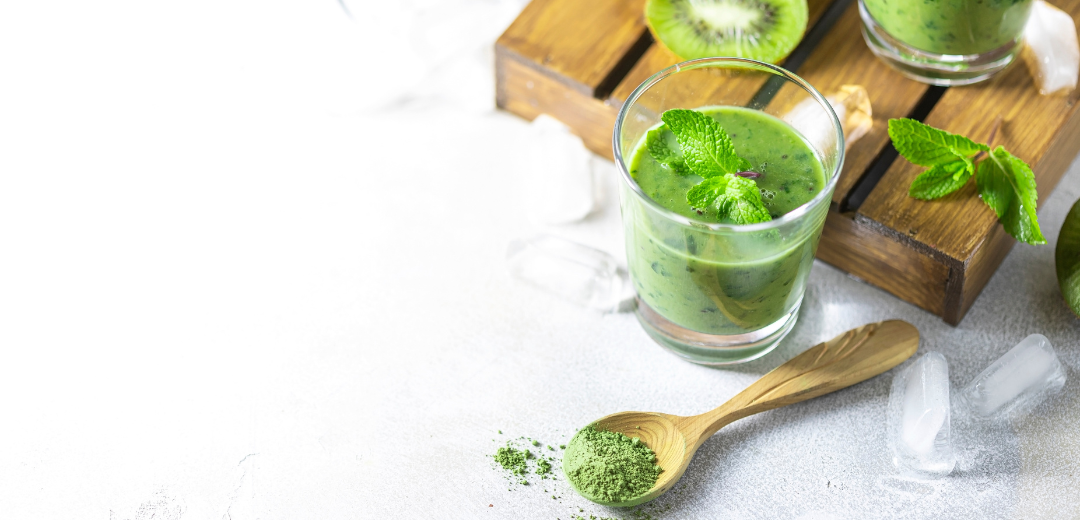
Matcha-Tee zum Abnehmen – Wie er bei der Fettverbrennung hilft
Matcha ist ein traditionelles japanisches Grünteepulver, das aufgrund seiner gesundheitsfördernden Wirkung weltweit beliebt ist. In den letzten Jahren hat Matcha-Tee aufgrund seines Potenzials, beim Abnehmen zu helfen, an Aufmerksamkeit gewonnen.
In diesem Artikel wird untersucht, wie Matcha-Tee die Fettverbrennung unterstützen und den Stoffwechsel ankurbeln kann. Außerdem gibt er Tipps zur Zubereitung und zum Verzehr von Matcha zur Gewichtsabnahme.
Studien haben gezeigt, dass das Trinken von mehr Matcha-Grüntee den Stoffwechsel und die Fettverbrennung anregt – beides kann zur Gewichtsabnahme beitragen!
Es wurde festgestellt, dass Matcha-Grüntee einen hohen Anteil an Catechinen enthält, einer Art Antioxidans, das mit einem verbesserten Stoffwechsel und einer besseren Fettverbrennung in Verbindung gebracht wird.
Eins Studie Eine im American Journal of Clinical Nutrition veröffentlichte Studie ergab, dass der Konsum von Grüntee-Extrakt mit hohem Catechingehalt, wie beispielsweise Matcha, im Vergleich zu einer Placebogruppe zu einem signifikanten Anstieg des Energieverbrauchs und der Fettoxidation führte.

Ein anderer Studie Eine im International Journal of Obesity veröffentlichte Studie ergab, dass Teilnehmer, die 12 Wochen lang täglich Grüntee-Extrakt mit 625 mg Catechinen und 39 mg Koffein zu sich nahmen, eine signifikante Verringerung ihres Körpergewichts, BMI, Taillenumfangs und Körperfettanteils erlebten.
Diese Ergebnisse deuten darauf hin, dass der regelmäßige Genuss von Matcha-Grüntee den Stoffwechsel und die Fettverbrennung ankurbeln und so zur Gewichtsabnahme beitragen kann.
Abonnieren Sie den RSS-Feed dieses Blogs unter http://premium-health-japan.myshopify.com/blogs/news.atom
Kalorienarm
Matcha-Grüntee ist kalorienarm und daher eine ausgezeichnete Wahl für alle, die abnehmen möchten. Eine Standardportion Matcha-Tee enthält nur 3 Kalorien, was deutlich weniger ist als bei vielen anderen zuckerhaltigen Getränken.

Darüber hinaus enthält Matcha-Tee eine Kohlenhydratart namens Catechin-Gallat-Ester, die zur Regulierung des Blutzuckerspiegels beitragen und das Verlangen nach Süßem reduzieren kann.
Durch den Ersatz kalorienreicher Getränke durch Matcha-Tee können Menschen ihre Kalorienaufnahme reduzieren und Gewicht verlieren.
Nährwertprofil von Matcha-Grüntee
Matcha-Grüntee ist ein sehr nahrhaftes Getränk, das zahlreiche Vitamine, Mineralien und Antioxidantien enthält. Eine Portion Matcha-Tee (ca. 1 Gramm) enthält 30 % der empfohlenen Tagesdosis (RDI) an Mangan, das für die Knochengesundheit und den Stoffwechsel wichtig ist.
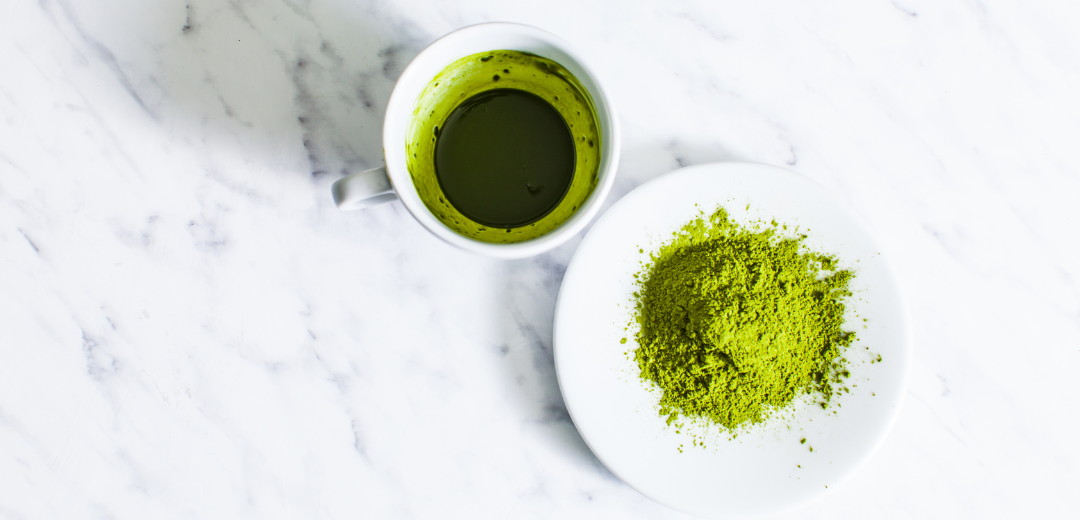
Es enthält auch geringe Mengen anderer wichtiger Nährstoffe wie Vitamin C, Vitamin K, Kalium und Magnesium.
Matcha-Tee ist außerdem reich an Antioxidantien, insbesondere Catechinen, die vor oxidativem Stress und chronischen Krankheiten schützen können. Insgesamt ist Matcha-Tee aufgrund seiner zahlreichen gesundheitlichen Vorteile eine hervorragende Ergänzung zu einem gesunden Lebensstil.
Wandelt weißes Fett in braunes Fett um
Matcha-Tee enthält das Antioxidans Epigallocatechingallat (EGCG), das nachweislich gegen Fettleibigkeit wirkt. EGCG kann unter anderem beim Abnehmen helfen, indem es weißes Fettgewebe, das Energie speichert und zur Gewichtszunahme beiträgt, in braunes Fettgewebe umwandelt, das Kalorien verbrennt und zur Regulierung der Körpertemperatur beiträgt.
A Studie Eine im Journal of Nutritional Biochemistry veröffentlichte Studie ergab, dass Mäuse, die mit einer fettreichen, mit EGCG angereicherten Diät gefüttert wurden, im Vergleich zu einer Kontrollgruppe mehr braunes Fettgewebe und ein geringeres Körpergewicht aufwiesen.
Zwar bedarf es noch weiterer Forschung, um die Auswirkungen von EGCG auf braunes Fettgewebe beim Menschen zu bestimmen, doch diese Erkenntnisse deuten darauf hin, dass der Konsum von Matcha-Tee möglicherweise ein natürliches Mittel zur Förderung der Gewichtsabnahme sein könnte.
Wie wäre es mit einer Stoffwechselankurbelung?

Matcha-Tee steigert nachweislich den Stoffwechsel, also den Prozess, bei dem der Körper Nahrung in Energie umwandelt. Studie Eine im Journal of Medicinal Food veröffentlichte Studie ergab, dass der Konsum von Grüntee-Extrakt mit hohem Catechingehalt, wie beispielsweise Matcha, im Vergleich zu einer Placebogruppe zu einer Erhöhung der Ruhestoffwechselrate führte.
Darüber hinaus enthält Matcha-Tee Koffein, das nachweislich den Stoffwechsel und den Energieverbrauch steigert.
Ein anderer Studie Eine im Journal of the American College of Nutrition veröffentlichte Studie ergab, dass Teilnehmer, die eine Kombination aus Catechinen und Koffein konsumierten, im Vergleich zur Kontrollgruppe einen signifikanten Anstieg der Fettverbrennung und des Energieverbrauchs verzeichneten. Durch die Anregung des Stoffwechsels kann Matcha-Tee dazu beitragen, mehr Kalorien zu verbrennen und die Gewichtsabnahme zu fördern.
Wie man Matcha-Tee zur Gewichtsabnahme trinkt
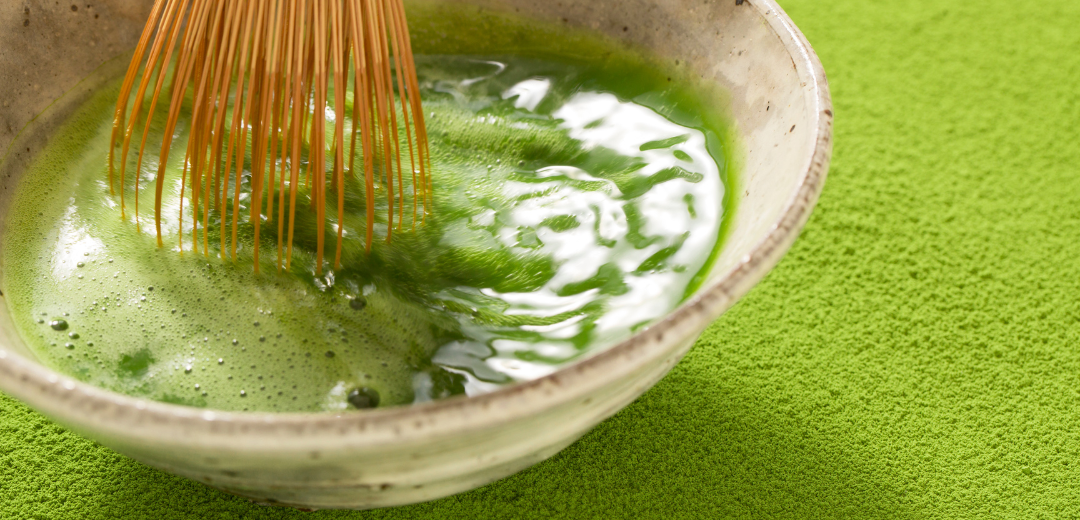
Hier sind einige Tipps zur Zubereitung von Matcha-Tee zur Gewichtsabnahme:
-
Verzehren Sie es ungesüßt und ohne Milch, um zusätzliche Kalorien und Fett zu vermeiden
-
Sieben Sie 1-2 Teelöffel Matcha-Pulver in eine Schüssel, um Klumpen zu entfernen
-
Fügen Sie 2-3 Unzen heißes Wasser (knapp unter dem Siedepunkt) hinzu und mischen Sie es mit einem Bambusbesen, bis eine glatte Paste entsteht
-
Geben Sie nach und nach mehr heißes Wasser hinzu, bis die Schüssel voll ist und der Tee schaumig ist
-
Nippen Sie langsam am Matcha-Tee und genießen Sie den Geschmack
-
Trinken Sie Matcha-Tee vor dem Training oder als Ersatz für kalorienreiche Getränke, um die Vorteile beim Abnehmen zu maximieren
Erhöht das Energieniveau
Matcha-Tee ist aufgrund seines hohen Koffeingehalts für seine energiesteigernde Wirkung bekannt. Eine Portion Matcha-Tee enthält etwa 35 mg Koffein – weniger als eine Tasse Kaffee, aber ausreichend für einen leichten Energieschub.
Im Gegensatz zu Kaffee enthält Matcha-Tee jedoch auch L-Theanin, eine Aminosäure, die nachweislich Entspannung fördert und Stress reduziert. In Kombination mit Koffein kann L-Theanin die Konzentration verbessern, ohne die mit Kaffee verbundenen Leistungsspitzen und -abstürze.
Durch die Steigerung des Energieniveaus kann Matcha-Tee dazu beitragen, dass Menschen aktiv bleiben und mehr Kalorien verbrennen, was mit der Zeit zu Gewichtsverlust führt.
Reduziert den Appetit

Matcha-Tee reduziert nachweislich den Appetit, was dazu beitragen kann, weniger Kalorien zu sich zu nehmen und die Gewichtsabnahme zu fördern. Studie Eine im European Journal of Clinical Nutrition veröffentlichte Studie ergab, dass der Konsum einer Kombination aus Catechinen und Koffein im Vergleich zu einer Kontrollgruppe zu weniger Hunger und einem stärkeren Sättigungsgefühl führte.
Darüber hinaus enthält Matcha-Tee ein Kohlenhydrat namens EGCG, das nachweislich den Appetit und die Nahrungsaufnahme reduziert. Durch das Trinken von Matcha-Tee können Sie Ihren Heißhunger zügeln und weniger Kalorien zu sich nehmen, was den Gewichtsverlust unterstützt.
Reduziert Müdigkeit und Muskelkater nach dem Training
Matcha-Tee kann Müdigkeit und Muskelkater nach dem Training lindern, was dazu beitragen kann, aktiv zu bleiben und mehr Kalorien zu verbrennen. Studie Eine im Journal of the International Society of Sports Nutrition veröffentlichte Studie ergab, dass Sportler, die Grüntee-Extrakt mit hohem Catechingehalt, wie beispielsweise Matcha, zu sich nahmen, nach dem Training weniger Muskelschäden und oxidativen Stress aufwiesen als eine Placebogruppe.

Darüber hinaus kann das Koffein im Matcha-Tee die Ausdauer verbessern und die gefühlte Anstrengung beim Training verringern, wodurch das Training leichter und angenehmer wird.
Durch die Verringerung von Müdigkeit und Muskelkater nach dem Training kann Matcha-Tee dabei helfen, die eigenen Fitnessziele zu erreichen und mit der Zeit die Gewichtsabnahme zu fördern.
Verbessert die Schlafqualität
Matcha-Tee kann die Schlafqualität verbessern, was für die Gewichtsabnahme wichtig ist, da Schlafmangel mit gesteigertem Appetit und verlangsamtem Stoffwechsel in Verbindung gebracht wird. Matcha-Tee enthält L-Theanin, eine Aminosäure, die nachweislich Entspannung fördert und die Schlafqualität verbessert.
A Studie hat herausgefunden, dass L-Theanin ein natürliches und sicheres Schlafmittel ist und die Schlafqualität verbessert. Darüber hinaus kann der Koffeingehalt im Matcha-Tee die Wachheit während des Tages fördern und so die Aufmerksamkeit und das Energieniveau für das Training steigern.
Durch die Verbesserung der Schlafqualität und die Förderung der Wachheit kann Matcha-Tee dazu beitragen, dass Menschen aktiv bleiben und mehr Kalorien verbrennen, was die Wahrscheinlichkeit einer Gewichtsabnahme erhöht.
Matcha vs. normaler grüner Tee – Warum Matcha-Pulver ein hervorragendes Mittel zur Gewichtsabnahme ist
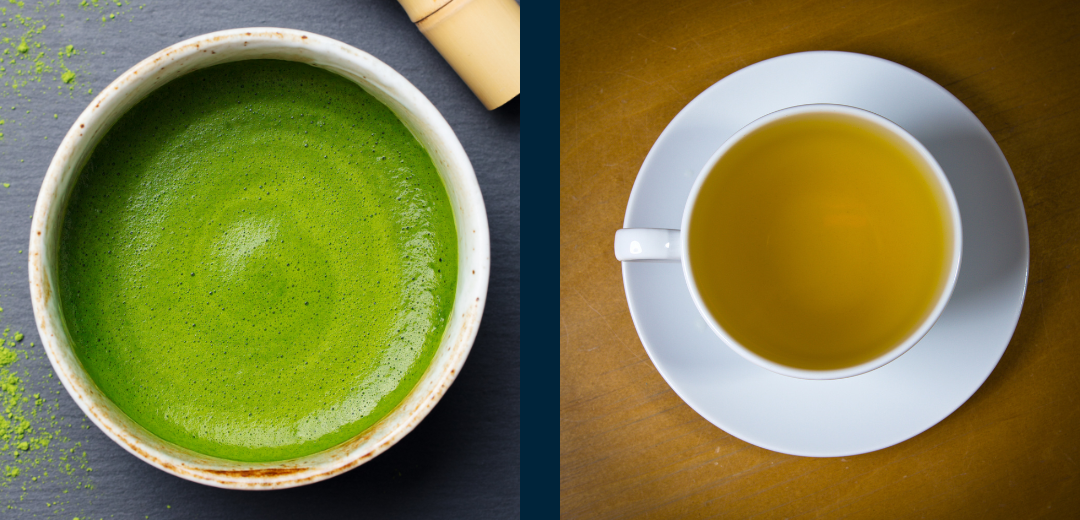
Matcha-Tee unterscheidet sich von normalem Grüntee in seiner Zubereitung und seinem Nährwertprofil, was ihn zu einem hervorragenden Mittel zur Gewichtsabnahme machen kann. Während normaler Grüntee durch Einweichen der Teeblätter in heißem Wasser aufgebrüht und anschließend weggeschüttet wird, wird Matcha-Tee durch Mahlen ganzer Teeblätter zu feinem Pulver hergestellt, was eine höhere Nährstoffkonzentration pro Portion ermöglicht.
Da Matcha-Tee im Ganzen getrunken wird, enthält er im Vergleich zu normalem Grüntee mehr Ballaststoffe und Antioxidantien. Matcha-Tee enthält außerdem höhere Mengen der Aminosäure L-Theanin, die zur Entspannung beitragen und die Schlafqualität verbessern kann.
Insgesamt bietet Matcha-Tee im Vergleich zu normalem Grüntee eine wirksamere Kombination aus Nährstoffen und nützlichen Verbindungen und ist daher eine gute Wahl für alle, die abnehmen möchten.
Um wie viel erhöht Matcha den Kalorienverbrauch beim Training?
Obwohl es keine genaue Zahl dafür gibt, um wie viel Matcha-Tee die Kalorienverbrennung während des Trainings steigert, haben Studien ergeben, dass der Konsum von Grüntee-Extrakt mit hohem Catechingehalt, wie beispielsweise Matcha, dazu beitragen kann, die Fettoxidation und den Energieverbrauch zu verbessern.
A Studie Im American Journal of Clinical Nutrition wurde festgestellt, dass Teilnehmer, die Grüntee-Extrakt mit hohem Catechingehalt zu sich nahmen, im Vergleich zu einer Kontrollgruppe eine erhöhte Fettoxidation und einen höheren Energieverbrauch aufwiesen.
Ein anderer Studie Eine im Journal of the International Society of Sports Nutrition veröffentlichte Studie ergab, dass bei Sportlern, die Grüntee-Extrakt mit hohem Catechingehalt zu sich nahmen, nach dem Training weniger Muskelschäden und oxidativer Stress auftraten als bei einer Placebogruppe.
Zwar bedarf es noch weiterer Forschung, um die genauen Auswirkungen von Matcha-Tee auf die Kalorienverbrennung beim Training zu bestimmen, doch diese Ergebnisse deuten darauf hin, dass das Trinken von Matcha-Tee dazu beitragen kann, mehr Kalorien zu verbrennen und die Fitness zu verbessern.
Wann sollte ich Matcha trinken, wenn ich nicht trainiere, aber abnehmen möchte?
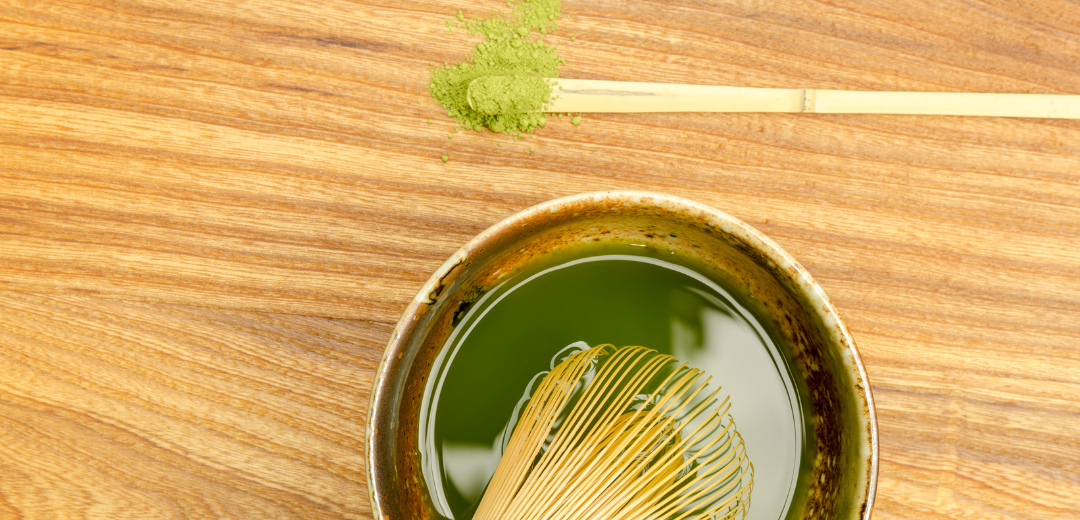
Wenn Sie nicht trainieren, aber abnehmen möchten, können Sie Matcha-Tee zu jeder Tageszeit trinken. Um den potenziellen Gewichtsverlustvorteil zu maximieren, sollten Sie Matcha-Tee jedoch anstelle von kalorienreichen Getränken wie Fruchtsäften oder zuckerhaltigen Kaffeegetränken trinken.
Matcha-Tee ist ein kalorienarmes und nährstoffreiches Getränk, das Heißhungerattacken zügelt und ein Sättigungsgefühl fördert, was zu einer insgesamt geringeren Kalorienaufnahme führen kann. Der Koffeingehalt von Matcha-Tee kann außerdem das Energieniveau steigern und möglicherweise den Stoffwechsel ankurbeln.
Um die Schlafqualität nicht zu beeinträchtigen, trinken Sie Matcha-Tee am besten früher am Tag und beschränken Sie den Konsum auf nicht mehr als 2–3 Portionen pro Tag.
Abschließende Gedanken
Matcha-Tee ist eine hervorragende Ergänzung zur Gewichtsabnahme, da er den Stoffwechsel anregt, Fett verbrennt, den Appetit reduziert, das Energieniveau steigert und die Erholung nach dem Training fördert. Durch den regelmäßigen Genuss von Matcha-Tee können Sie Ihre Kalorienzufuhr reduzieren, aktiv bleiben und Ihre Gewichtsabnahmeziele leichter erreichen.
Matcha Latte
Erfahren Sie mehr über den Antioxidantiengehalt, die energiespendende und stressreduzierende Wirkung von Matcha Latte. Vergleichen Sie ihn mit Kaffee und finden Sie Antworten auf häufige Fragen zu Sicherheit und Mäßigung.
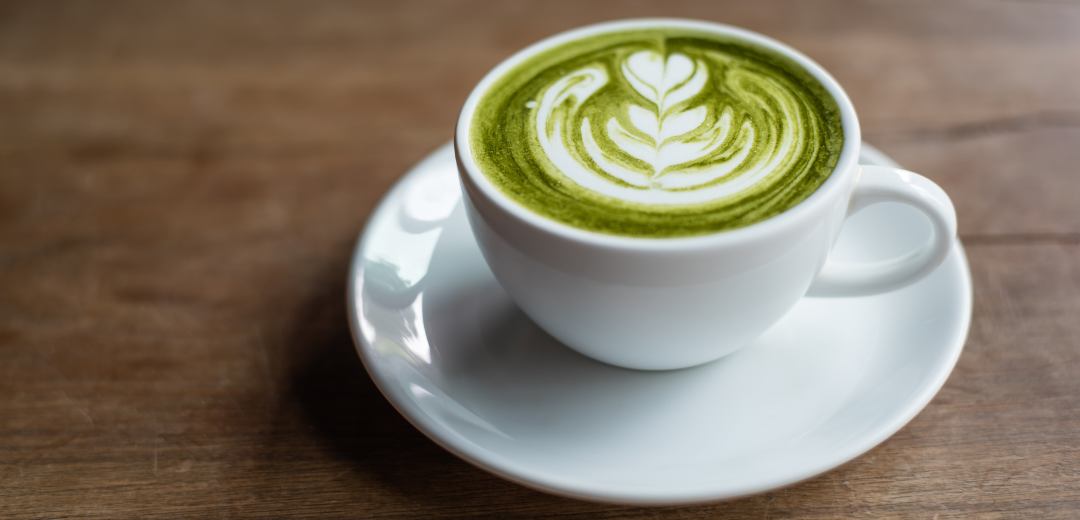
Was ist ein Matcha Latte?
Ein traditioneller Matcha-Tee-Latte ist ein warmes Getränk, das den intensiven Grünteegeschmack von Matcha-Pulver mit cremiger, aufgeschäumter Milch kombiniert. Das Ergebnis ist ein sanftes, wohltuendes Getränk, das sowohl belebend als auch köstlich ist.
Er wird oft als Muntermacher am Morgen oder als entspannende Leckerei am Nachmittag genossen. Matcha Lattes erfreuen sich aufgrund der gesundheitlichen Vorteile von Matcha und des wachsenden Trends zu Kaffeespezialitäten zunehmender Beliebtheit.

Sind Matcha Lattes gesund?
Matcha-Grüntee-Lattes gelten als eine gesündere Alternative zu anderen koffeinhaltigen Getränken wie Kaffee oder Softdrinks (Limonade). Matcha-Pulver wird aus beschatteten und gemahlenen Grünteeblättern hergestellt und ist daher eine hochkonzentrierte Quelle von Antioxidantien, Ballaststoffen und anderen nützlichen Inhaltsstoffen. Diese Inhaltsstoffe können helfen, steigern Sie Ihr Energieniveau , verbessern Sie Ihre geistige Wachheit und kognitive Funktion und vor oxidativem Stress schützen und Schäden.
Es ist jedoch wichtig zu bedenken, dass ein typischer Starbucks Matcha Latte Zucker und aufgeschäumte Milch enthält, was zusätzliche Kalorien liefern und den gesundheitlichen Nutzen mindern kann. Wählen Sie am besten ungesüßtes Bio-Matcha-Pulver und verwenden Sie fettarme oder pflanzliche Milch für ein gesünderes Getränk. Auch bei allen Speisen und Getränken ist Mäßigung wichtig. Übertreiben Sie es daher nicht und genießen Sie Ihren Matcha Latte als Teil einer ausgewogenen Ernährung.

Ist Matcha Latte gesünder als Kaffee?
Matcha-Grüntee-Latte und Kaffee haben jeweils ihre eigenen Vor- und Nachteile. Ob ein Matcha-Latte gesünder als ein Kaffee ist, lässt sich nur schwer eindeutig sagen, da dies von verschiedenen Faktoren wie der Zubereitungsmethode, den verwendeten Zutaten und persönlichen Gesundheitszielen abhängen kann.
Matcha ist eine Art pulverisierter Grüntee, der aus im Schatten gewachsenen Teeblättern hergestellt und zu feinem Pulver gemahlen wird. Matcha ist reich an Antioxidantien, Polyphenolen und Aminosäuren und wird mit einer Reihe von gesundheitlichen Vorteilen in Verbindung gebracht, darunter eine verbesserte Herzgesundheit, mehr Energie und Konzentration sowie reduziertes Stressniveau .
Kaffee hingegen ist reich an Koffein, das für einen schnellen Energieschub und eine verbesserte Konzentration sorgen kann. Kaffee enthält außerdem Antioxidantien, die das Risiko bestimmter Krankheiten senken können.
Es ist wichtig zu bedenken, dass sowohl Matcha Latte als auch Kaffee zwar im Rahmen einer ausgewogenen Ernährung genossen werden können, übermäßiger Konsum beider Getränke jedoch negative Auswirkungen auf die Gesundheit haben kann. So kann beispielsweise übermäßiger Koffeinkonsum zu Angstzuständen und Schlafstörungen führen. Darüber hinaus kann zu viel Zucker oder fettreiche Milchprodukte in Ihrem Matcha Latte oder Kaffee den Kalorien- und Fettgehalt des Getränks erhöhen, was offensichtlich nicht gut für die Gesundheit ist.
Letztendlich hängt die beste Wahl für Sie von Ihren persönlichen Gesundheitszielen sowie Ihren Geschmacksvorlieben ab. Ich persönlich liebe Kaffee und Matcha und genieße beides täglich in Maßen.
Abonnieren Sie den RSS-Feed dieses Blogs unter http://premium-health-japan.myshopify.com/blogs/news.atom

Ist es in Ordnung, jeden Tag Matcha Latte zu trinken?
Es gilt allgemein als unbedenklich, täglich einen Matcha-Grüntee-Latte zu trinken. Matcha ist reich an Antioxidantien und Nährstoffe die verschiedene gesundheitliche Vorteile haben, wie z. B. die Stärkung des Immunsystems, die Verbesserung der geistigen Klarheit und die Förderung der Herzgesundheit.
Es ist jedoch wichtig zu bedenken, dass Matcha-Tee-Lattes oft zugesetzten Zucker oder Sirup enthalten, die bei übermäßigem Konsum zu Gewichtszunahme, Karies und anderen gesundheitlichen Problemen führen können. Darüber hinaus enthält Matcha Koffein, das bei übermäßigem Konsum Schlaflosigkeit und andere Nebenwirkungen verursachen kann.
Es empfiehlt sich daher, Matcha-Grüntee-Latte in Maßen zu trinken und möglichst eine zuckerarme oder zuckerfreie Variante zu wählen. Es ist außerdem wichtig, einen Arzt zu konsultieren, bevor Sie Matcha-Latte regelmäßig zu sich nehmen, insbesondere wenn Sie unter Vorerkrankungen leiden oder Medikamente einnehmen.
Während das tägliche Trinken von Matcha Latte in Maßen eine köstliche und gesunde Angewohnheit sein kann, ist es wichtig, auf den Zucker- und Koffeingehalt zu achten und gegebenenfalls einen Arzt zu konsultieren.
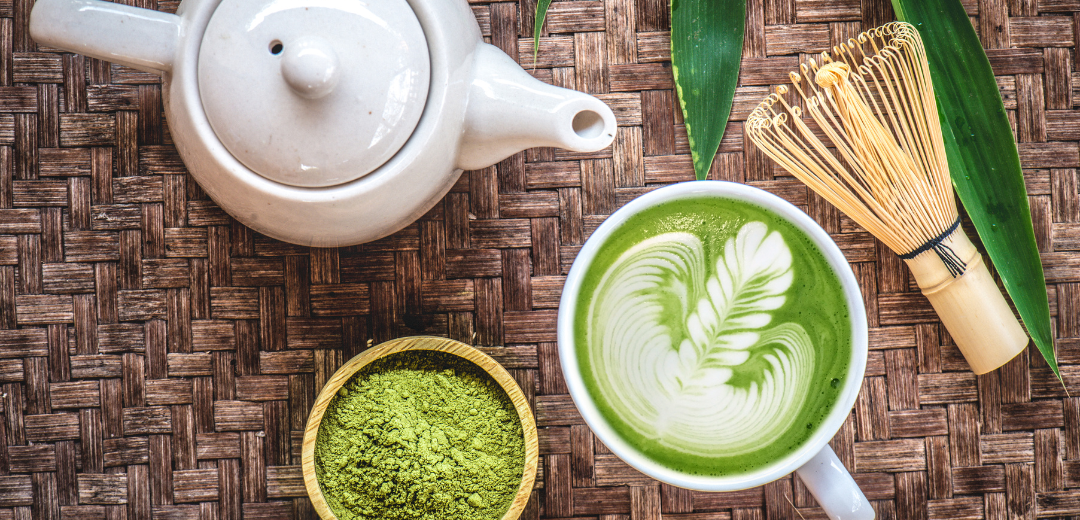
Welche Vorteile bietet das Trinken von Matcha Latte?
Das Trinken von Matcha Latte kann eine Reihe potenzieller gesundheitlicher Vorteile bieten, darunter:
-
Reich an Antioxidantien: Matcha wird aus im Schatten gewachsenen Teeblättern hergestellt, die reich an Antioxidantien sind, die dazu beitragen können, Ihre Zellen vor Schäden durch freie Radikale zu schützen.
-
Erhöhte Energie und Konzentration: Matcha enthält Koffein und die Aminosäure L-Theanin, die einen natürlichen Energieschub liefern kann und verbessern Sie Ihre geistige Konzentration .
-
Reduziertes Stressniveau: L-Theanin in Matcha hilft nachweislich Stress abbauen und Entspannung fördern .
-
Verbesserte Herzgesundheit: Die Antioxidantien und Polyphenole in Matcha werden mit einer verbesserten Herzgesundheit in Verbindung gebracht, indem sie den Blutdruck senken und den Cholesterinspiegel verbessern.
-
Angekurbelter Stoffwechsel: Einige Studien deuten darauf hin, dass die Catechine in Matcha den Stoffwechsel ankurbeln und die Fettoxidation steigern können, was bei der Gewichtsabnahme hilfreich sein kann.
-
Bessere Hautgesundheit: Die Antioxidantien in Matcha können auch dazu beitragen, Ihre Haut vor Schäden durch freie Radikale zu schützen, was zu einem jugendlicheren, strahlenderen Teint führen kann.
Es ist wichtig zu beachten, dass Matcha Latte zwar diese potenziellen gesundheitlichen Vorteile bieten kann, jedoch nur in Maßen als Teil einer ausgewogenen Ernährung genossen werden sollte und ein übermäßiger Konsum von Matcha oder anderen Lebensmitteln oder Getränken negative Auswirkungen auf Ihre Gesundheit haben kann.
Darüber hinaus empfiehlt es sich, natürliche Süßstoffe wie Ahornsirup, Honig, Agavendicksaft und Kokosblütenzucker zu verwenden. Pflanzliche Milchsorten wie Kokosmilch, Hafermilch, ungesüßte Mandelmilch sowie hochwertiges Matcha-Pulver ergeben ein sehr gutes Rezept und ein köstliches Getränk!
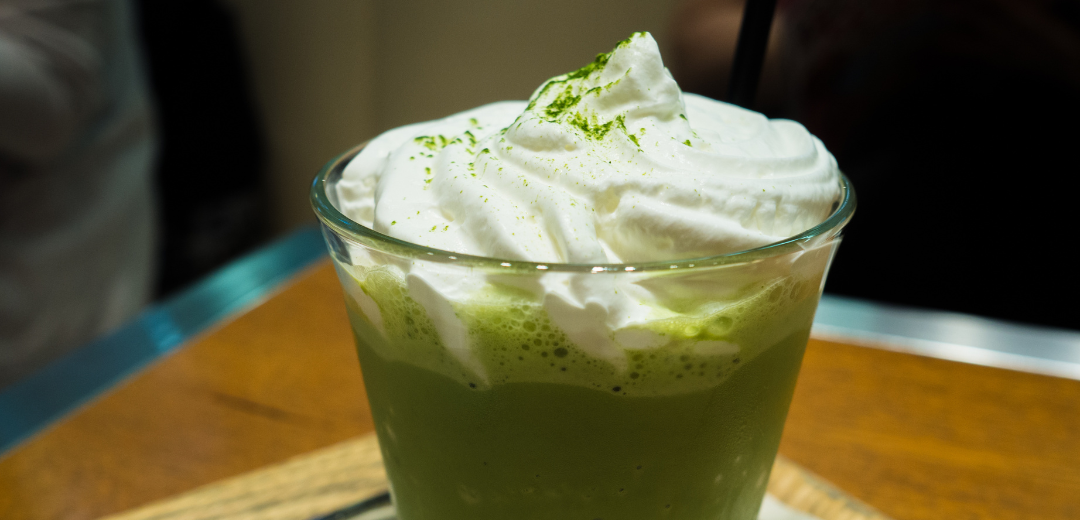
Machen Sie zu Hause einen Matcha Latte
Einen Matcha Latte zu Hause zuzubereiten ist ganz einfach. Hier ist ein Grundrezept:
Zutaten:
-
1 TL Matcha-Grünteepulver
-
2 Unzen heißes Wasser
-
250 ml Milch
-
1-2 TL Honig oder Süßstoff Ihrer Wahl (optional)
-
Schlagsahne (optional)
Anweisungen:
-
In einer kleinen Schüssel das Matcha-Grünteepulver und heißes Wasser glatt und schaumig rühren.
-
In einem Topf die Milch erhitzen, bis sie zu dampfen beginnt. Nicht kochen lassen.
-
Gießen Sie die aufgeschäumte Milch in eine große Tasse.
-
Geben Sie die Matcha-Mischung in die Tasse und rühren Sie, bis alles gut vermischt ist.
-
Falls gewünscht, Honig oder Süßstoff hinzufügen und umrühren, bis er sich aufgelöst hat.
-
Nach Belieben mit einem Klecks Schlagsahne garnieren.
-
Sofort servieren und Ihren köstlichen hausgemachten Matcha-Grüntee-Latte genießen!
Hinweis: Wenn Ihre Kaffeemaschine keine Dampfdüse hat, können Sie die Milch auch mit einem Milchaufschäumer oder Schneebesen aufschäumen. Sie können auch mit verschiedenen Milchsorten experimentieren, um die passende zu finden. Mandel-, Hafer- und leichte Kokosmilch sind beliebte Optionen.
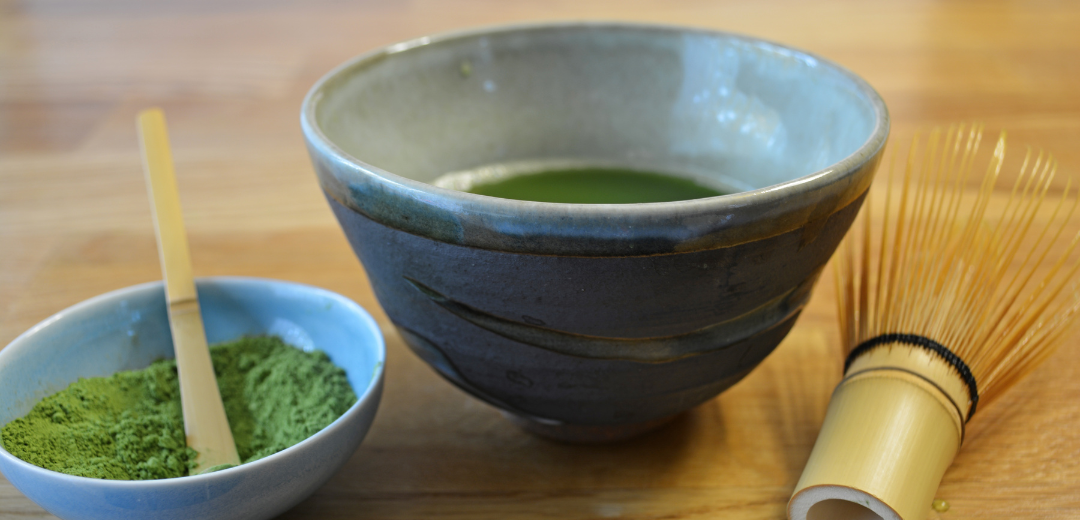
Welche Ausrüstung benötige ich?
Um einen Matcha Latte zu Hause zuzubereiten, benötigen Sie folgende Ausrüstung:
-
Hochwertiges Matcha-Pulver
-
Kleine Schüssel
-
Schneebesen oder Löffel
-
Topf
-
Milchaufschäumer (optional)
-
Großer Becher oder Tasse
-
Löffel zum Umrühren
Wenn du die Milch für deinen Latte aufschäumen möchtest, benötigst du zusätzlich eine Kaffeemaschine mit Dampfdüse oder einen separaten Milchaufschäumer. Du kannst die Milch aber auch auf dem Herd erhitzen und sie dann mit einem Schneebesen oder einem Milchaufschäumer manuell aufschäumen.
Eine Küchenwaage kann auch beim Abmessen des Matcha-Pulvers und anderer Zutaten hilfreich sein. So wird sichergestellt, dass Ihr Latte die perfekte Geschmacksbalance aufweist.

Welches Matcha-Pulver soll ich verwenden?
Für einen köstlichen Matcha Latte ist die Qualität des Matcha entscheidend. Der richtige Matcha kann den Geschmack und die Konsistenz Ihres Latte entscheidend beeinflussen.
Wenn Sie nach dem besten Matcha-Pulver für Ihren Latte suchen, sollten Sie unsere erste Bio-Sorte zur Frühjahrsernte. Matcha aus der ersten Frühlingsernte in Uji gilt als der feinste und hochwertigste Matcha. Unser Bio-Matcha wird nur einmal im Jahr geerntet, was ihn zu einer seltenen und besonderen Zutat macht.
Bio-Matcha-Pulver ist auch eine gute Option für alle, die eine gesündere Alternative suchen. Bio-Matcha ist frei von Pestiziden und Chemikalien, sodass Sie ein reines und natürliches Produkt konsumieren können.
Mit dem feinsten und hochwertigsten Matcha-Pulver aus der ersten Frühlingsernte können Sie einen köstlichen und authentischen Matcha Latte kreieren, der sich wirklich hervorhebt. Ob Sie ein Kaffeekenner sind oder einfach nur nach einer neuen und interessanten Art suchen, Matcha zu genießen – hochwertiges Matcha-Pulver ist der perfekte Ausgangspunkt.

Wie man Matcha ohne Bambusbesen zubereitet
Ein Bambusbesen wird traditionell für die Zubereitung von Matcha-Tee verwendet, ist aber nicht unbedingt erforderlich. Wenn Sie keinen Bambus-Matcha-Besen haben, können Sie mit anderen Werkzeugen trotzdem einen köstlichen Matcha Latte zubereiten.
So bereiten Sie Matcha ohne Bambus-Matcha-Besen zu:
-
Sieben Sie das Matcha-Pulver in einer kleinen Schüssel, um alle Klumpen zu entfernen.
-
Geben Sie 60 ml heißes Wasser in die Schüssel und rühren Sie den Matcha mit einem Löffel um, bis er vollständig aufgelöst und schaumig ist.
-
Nach Belieben 1–2 Teelöffel Honig oder Süßstoff hinzufügen und umrühren, bis sich dieser aufgelöst hat.
-
Erhitzen Sie die Milch in einem Topf, bis sie zu dampfen beginnt. Achten Sie darauf, dass sie nicht kocht.
-
Wenn Sie die Milch aufschäumen möchten, verwenden Sie einen Milchaufschäumer oder einen Schneebesen, um eine cremige und schaumige Konsistenz zu erzeugen.
-
Gießen Sie die aufgeschäumte Milch in eine große Tasse.
-
Geben Sie die Matcha-Mischung in die Tasse und rühren Sie, bis alles gut vermischt ist.
-
Nach Belieben mit einem Klecks Schlagsahne garnieren.
-
Sofort servieren und Ihren köstlichen Matcha Latte ohne Bambusbesen genießen!
Hinweis: Wenn Sie keinen Milchaufschäumer haben, können Sie die Milch auch mit einem Mixer oder einem Handaufschäumer aufschäumen. Sie können auch mit verschiedenen Milchsorten experimentieren, um die für Sie passende zu finden. Ungesüßte Mandelmilch und Hafermilch sind beliebte Optionen.
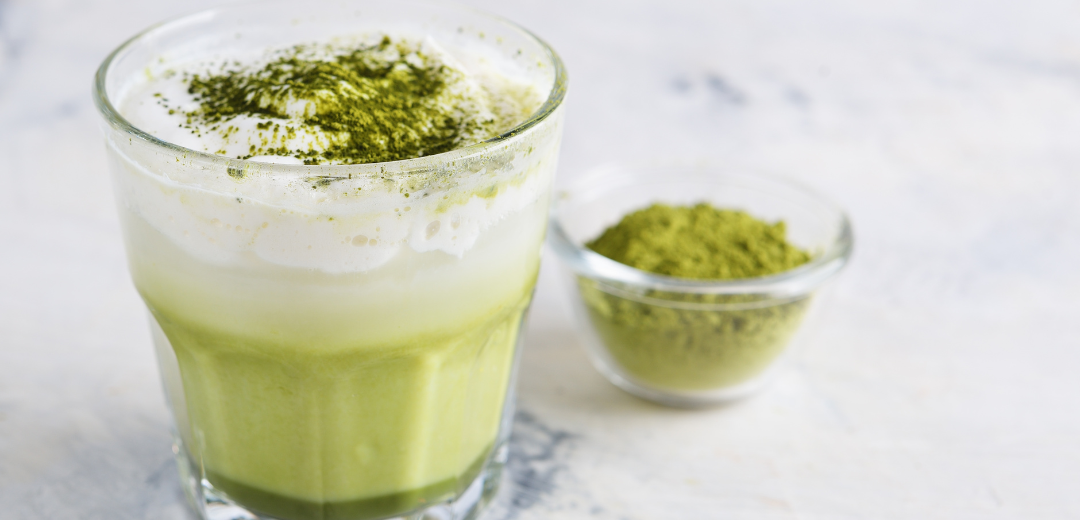
Unsere beliebten Matcha-Rezepte, die Ihnen schmecken werden
Hier sind einige beliebte Matcha-Rezepte, die Sie lieben werden:
-
Klassischer Matcha Latte: Dies ist ein traditionelles und einfaches Rezept für einen köstlichen Matcha Latte zu Hause. Mischen Sie einfach Matcha-Pulver, heißes Wasser und geschäumte Milch, um ein cremiges und schaumiges Getränk zu erhalten.
-
Matcha-Smoothie: Für ein erfrischendes und nahrhaftes Getränk probieren Sie doch mal einen Matcha-Smoothie. Mischen Sie einfach hochwertiges Matcha-Pulver, Mandelmilch, gefrorene Bananen und Ihre Lieblingsfrüchte zu einem köstlichen und gesunden Getränk.
-
Matcha Iced Latte: Wenn Sie Ihre Matcha-Getränke lieber kalt mögen, versuchen Sie es mit einem Matcha Iced Latte. Mischen Sie einfach Matcha-Pulver, kaltes Wasser und Ihre Lieblingsmilch auf Eis zu einem erfrischenden und belebenden Getränk.
-
Matcha Latte mit Mandelmilch: Für eine nussige Variante des klassischen Matcha Latte probieren Sie einen Matcha Latte mit Mandelmilch. Die Mandelmilch verleiht dem Latte einen cremigen und nussigen Geschmack, der den erdigen Geschmack des Matcha perfekt ergänzt.
-
Matcha-Grüntee-Frappuccino: Wenn Sie Lust auf ein süßes und cremiges Matcha-Getränk haben, versuchen Sie es mit einem Matcha-Grüntee-Frappuccino. Mischen Sie einfach Matcha-Pulver, kaltes Wasser, Ahornsirup und Kokosmilch zu einem köstlichen, cremigen Eisgenuss.
Dies sind nur einige der vielen Matcha-Rezepte, die Sie zu Hause ausprobieren können. Egal, ob Sie Ihren Matcha warm oder kalt, süß oder herzhaft mögen – es gibt das passende Matcha-Rezept für Sie!
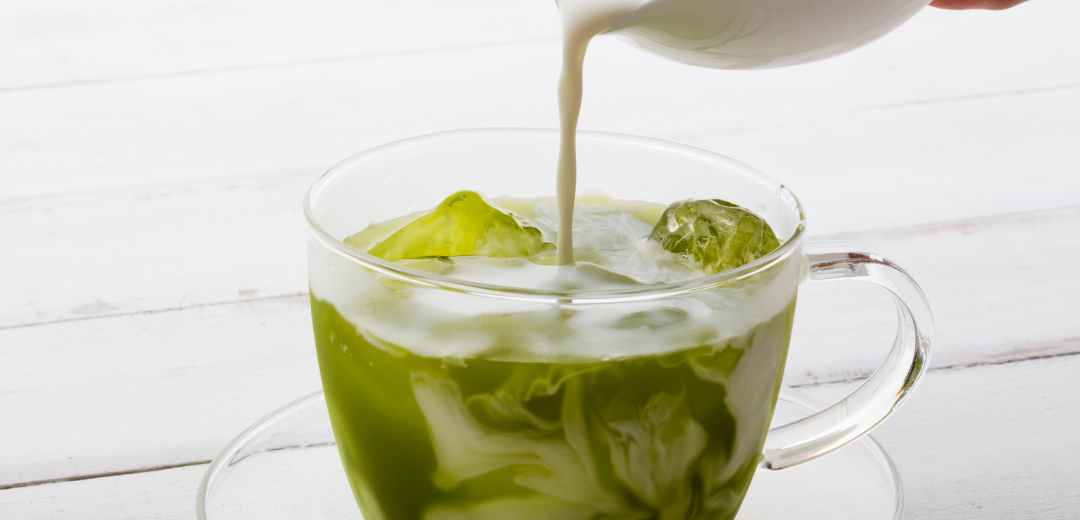
Welche Milch passt am besten zu Matcha?
Welche Milch sich am besten für einen Matcha Latte eignet, hängt von persönlichen Vorlieben und Ernährungseinschränkungen ab. Hier sind einige der beliebtesten Optionen:
-
Kuhmilch ist die traditionelle Wahl für Matcha Lattes, da sie einen cremigen, reichhaltigen Geschmack bietet, der den erdigen Geschmack von Matcha perfekt ergänzt. Am häufigsten wird Vollmilch verwendet, für eine leichtere Variante kann aber auch Magermilch oder fettarme Milch verwendet werden.
-
Sojamilch ist eine beliebte Alternative zu Kuhmilch und eignet sich besonders für Menschen mit Laktoseintoleranz und Veganer. Sojamilch verleiht einen leicht nussigen Geschmack, der gut zu Matcha passt.
-
Mandelmilch ist eine weitere beliebte Wahl für Menschen mit Laktoseintoleranz oder Veganer und sorgt außerdem für den leicht süßen, nussigen Geschmack, der Matcha ergänzt.
-
Hafermilch ist eine beliebte Alternative zu Kuhmilch. Ihr cremiger, leicht süßer Geschmack ergänzt den erdigen Geschmack von Matcha-Pulver perfekt. Sie ist auch eine gute Wahl für Menschen mit Laktoseintoleranz oder pflanzlicher Ernährung, da sie milchfrei und vegan ist.
-
Kokosmilch ist eine weitere Alternative zu Kuhmilch und eignet sich besonders für alle, die einen süßeren, cremigeren Geschmack bevorzugen. Sie enthält jedoch mehr gesättigte Fettsäuren als andere Milchsorten und ist daher möglicherweise nicht für Personen geeignet, die sich fettarm ernähren.
Letztendlich ist die beste Milch für einen Matcha Latte diejenige, die den Geschmack von Matcha ergänzt und Ihren persönlichen Geschmacksvorlieben und Ernährungseinschränkungen entspricht. Möglicherweise müssen Sie experimentieren, um die perfekte Milch für Sie zu finden.
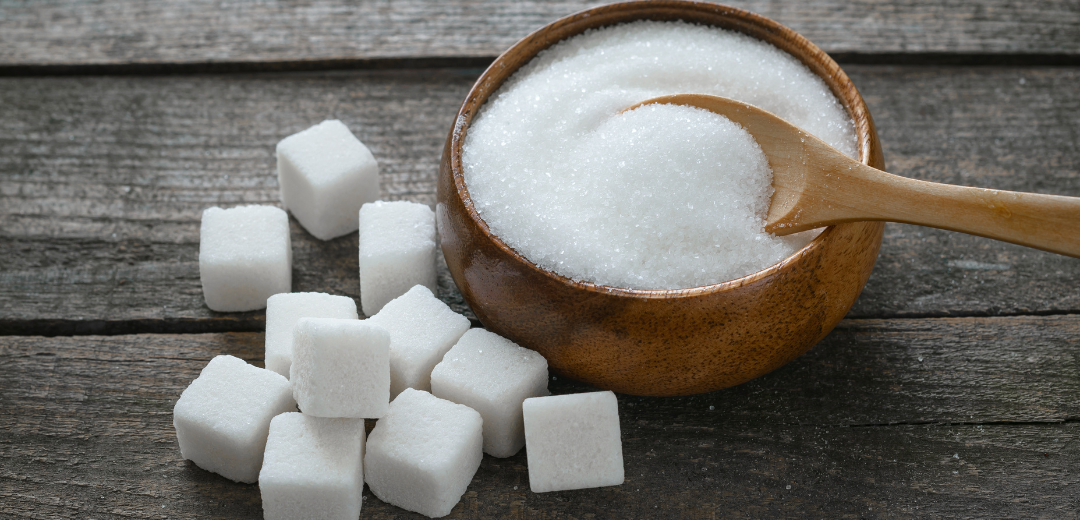
Gibt man Milch und Zucker in Matcha?
Ob Matcha mit Milch und Zucker zubereitet wird, ist Geschmackssache. Manche genießen Matcha lieber pur, nur mit Wasser, um den natürlichen Geschmack und die Nährstoffe des Tees voll auszukosten.
Andere bevorzugen es, ihrem Matcha Milch und/oder Zucker hinzuzufügen, um ein süßeres, cremigeres Getränk zu erhalten. Milch kann helfen, die natürliche Bitterkeit von Latte Matcha auszugleichen und ihn für Neueinsteiger zugänglicher zu machen. Die Zugabe von Zucker kann die Süße des Getränks noch verstärken.
Wichtig zu beachten: Milch und Zucker können die gesundheitlichen Vorteile von Matcha mindern und den Kaloriengehalt erhöhen. Für einen gesunden Lebensstil empfiehlt es sich, Matcha nur mit Wasser oder pflanzlicher Milch zu genießen und die Zuckermenge zu begrenzen (Ahornsirup, Agavendicksaft oder Honig als Alternative). Matcha in Zeremonienqualität ist die beste Wahl, da er nicht bitter schmeckt und man weniger Zucker oder Süßstoffe hinzufügen möchte.
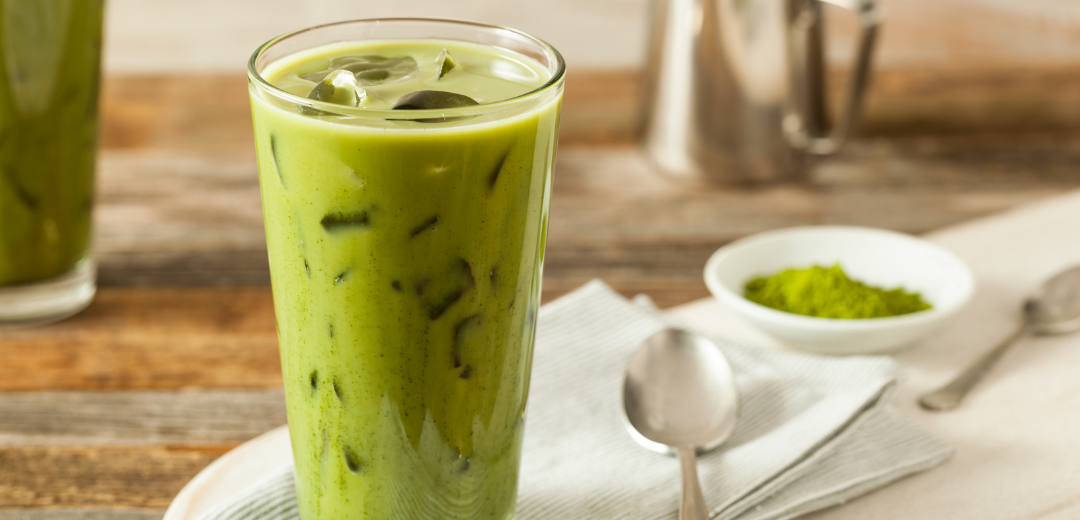
Kann man Matcha einfach in Milch geben?
Ja, Sie können Matcha mit Milch vermischen, um ein einfaches und köstliches Getränk zuzubereiten. Mischen Sie dazu einfach die gewünschte Menge Matcha-Grünteepulver mit etwas warmer Milch zu einer Paste, geben Sie dann die restliche Milch hinzu und erhitzen Sie alles auf die gewünschte Temperatur. Sie können die Milch auch aufschäumen, um ein cremiges Getränk im Latte-Stil zuzubereiten.
Wichtig: Wenn Sie Matcha in Milch geben, verwenden Sie am besten hochwertiges Matcha-Pulver, um den Geschmack und die vielfältigen Vorteile des Tees voll auszukosten. Die Verwendung von minderwertigem oder abgelaufenem Matcha kann zu einem bitteren oder unangenehm schmeckenden Getränk führen.
Matcha mit Milch zu verfeinern ist eine tolle Möglichkeit, den Tee einfach und wohltuend zu genießen. Experimentieren Sie mit verschiedenen Matcha-Milch-Verhältnissen, um Ihr persönliches Geschmackserlebnis zu finden.


